#Haarlem (City/Town/Village)
Explore tagged Tumblr posts
Text
Explore the Wonders of the Netherlands: 8 Days, 7 Nights Tour Package

The Netherlands is a country of timeless charm, where history, culture, and nature merge seamlessly to create an unforgettable travel experience. The "Explore the Wonders of the Netherlands: 8 Days, 7 Nights Tour Package" offers a perfect opportunity to immerse yourself in the Dutch way of life, from vibrant cities to serene countryside, showcasing the essence of this picturesque European gem. This comprehensive itinerary is designed to help you explore the country’s most famous attractions, hidden gems, and local traditions, ensuring a well-rounded and enriching vacation.
Day 1: Arrival in Amsterdam – Begin Your Journey
Your journey begins upon arrival in Amsterdam, the vibrant capital of the Netherlands. Known for its scenic canals, historic architecture, and lively cultural scene, Amsterdam offers the perfect blend of old-world charm and modern elegance. After being transferred to your hotel, take some time to relax and refresh.
In the evening, embark on a canal cruise that will allow you to see the city from a unique perspective. As you float along the iconic canals, you’ll pass by beautiful bridges, picturesque houseboats, and the charming facades of Amsterdam’s historic buildings. The shimmering lights reflecting on the water create a magical atmosphere, providing a perfect introduction to your Dutch adventure.
Day 2: Art and History in Amsterdam – Museums and More
Day two is dedicated to exploring the artistic and historical treasures of Amsterdam. Begin your day with a visit to the world-famous Rijksmuseum. Home to an impressive collection of Dutch art and history, this museum is a must-see for culture enthusiasts. Admire works by renowned artists like Rembrandt, Vermeer, and Frans Hals, including the iconic The Night Watch by Rembrandt. The museum also houses exhibits on Dutch history, including its golden age, colonial past, and innovative maritime achievements.
Next, visit the Van Gogh Museum, which showcases the works of Vincent van Gogh, one of the most influential artists of the post-impressionist era. Explore the vivid, expressive style that marked van Gogh’s evolution as an artist, and learn about the trials and triumphs that shaped his iconic art. Afterward, stroll through the charming neighborhoods surrounding the museum, such as the trendy De Pijp area, known for its eclectic cafés, boutiques, and markets.
Day 3: A Day in the Countryside – Windmills and Traditional Villages
On day three, you’ll venture beyond the city to discover the peaceful countryside of the Netherlands. First, visit Zaanse Schans, an open-air museum where you can experience traditional Dutch culture. The star attractions here are the windmills, which have long been essential to the country’s water management and land reclamation efforts. Learn about the importance of these windmills and watch as artisans demonstrate traditional crafts, such as clog-making and cheese production.
Continue your countryside journey to the picturesque village of Marken, a former island village famous for its wooden houses and charming streets. Explore the village at your leisure, visit local museums, and discover the unique character of this historic town. Afterward, head to Volendam, another quaint fishing village known for its beautiful harbor, colorful houses, and bustling streets. Sample fresh seafood and traditional Dutch snacks before returning to Amsterdam for the evening.
Day 4: Keukenhof Gardens and Haarlem – Blooms and Heritage
Day four takes you to two beautiful destinations outside of Amsterdam. In the morning, visit the Keukenhof Gardens, one of the largest flower gardens in the world, and a must-visit in the spring when tulips are in full bloom. Keukenhof is renowned for its dazzling array of flowers, with over seven million blooming tulips, daffodils, hyacinths, and more. Walk through the themed gardens, enjoy the vibrant colors, and take in the fresh, floral scents.
In the afternoon, head to Haarlem, a picturesque city filled with charming canals, historic architecture, and a lively cultural scene. Visit the Grote Kerk (Great Church), a Gothic masterpiece, and explore the medieval streets that are home to quaint boutiques, art galleries, and cozy cafés. Haarlem is the perfect blend of rich history and modern flair, making it an ideal place to spend a relaxing afternoon before heading back to Amsterdam.
Day 5: Kinderdijk and Alkmaar – Windmills and Cheese
Day five is a true celebration of Dutch heritage, with visits to two iconic locations: Kinderdijk and Alkmaar. Begin your day at Kinderdijk, a UNESCO World Heritage site renowned for its collection of 19 windmills. These windmills were built in the 18th century to manage water levels and prevent flooding in the region. A visit to Kinderdijk offers an incredible opportunity to step back in time and understand the engineering feats that helped transform the landscape of the Netherlands.
In the afternoon, travel to Alkmaar, a charming town famous for its historic cheese market. On Fridays, the town comes alive with the traditional cheese auction, where cheese traders display their goods in colorful, lively fashion. Watch the auction process and learn about the different types of Dutch cheese. Afterward, take a stroll through Alkmaar’s cobbled streets and enjoy a leisurely lunch at one of the local cafés.
Day 6: The Hague and Delft – Art, Politics, and Craftsmanship
Day six takes you to The Hague, the political heart of the Netherlands. Start your day with a visit to the Binnenhof, the seat of the Dutch government, and marvel at the medieval architecture that houses the nation’s political institutions. The Hague is also home to the Mauritshuis Museum, where you’ll find an exceptional collection of art, including works by Vermeer, Rembrandt, and other Dutch masters. Don’t miss Vermeer’s Girl with a Pearl Earring, one of the world’s most iconic paintings.
In the afternoon, travel to Delft, a charming town known for its blue-and-white porcelain. Explore the narrow streets lined with canals, visit the Royal Delft factory to see the iconic pottery being made, and learn about the city’s historical connection to renowned painter Johannes Vermeer. Delft’s peaceful atmosphere and rich artistic history make it a delightful destination to explore.
Day 7: Maastricht – A European Blend of History and Culture
On day seven, venture south to Maastricht, a city that offers a unique blend of Dutch, Belgian, and German influences. As one of the oldest cities in the Netherlands, Maastricht is steeped in history. Visit the Basilica of Saint Servatius, one of the oldest churches in the country, and learn about the city’s role in European history, especially its connection to the Maastricht Treaty, which founded the European Union.
Afterward, explore the charming town center, with its medieval buildings, cobblestone streets, and vibrant café culture. Don’t forget to try Limburgse vlaai, a traditional fruit pie from the region, before heading back to Amsterdam for the evening.
Day 8: Departure from Amsterdam
On your final day, enjoy some last-minute shopping or sightseeing in Amsterdam before your departure. You might want to visit the Anne Frank House, a moving museum that tells the story of Anne Frank’s life during World War II. Alternatively, relax in one of Amsterdam’s beautiful parks, such as Vondelpark, or simply enjoy a leisurely breakfast at a local café before transferring to the airport.
Conclusion
The "Explore the Wonders of the Netherlands: 8 Days, 7 Nights Tour Package" offers an immersive experience that showcases the best of Dutch culture, history, and natural beauty. From the artistic masterpieces of Amsterdam to the historic windmills of Kinderdijk, this tour takes you through the highlights of the Netherlands while also offering a chance to explore its lesser-known treasures. Whether you’re an art lover, a history buff, or simply someone looking to experience the tranquility of the Dutch countryside, this tour promises to leave you with lasting memories of one of Europe’s most enchanting countries.
#TravelPackage#NetherlandsTour#HollandTravel#ExploreNetherlands#8Days7Nights#DutchAdventures#Amsterdam#Rotterdam#Utrecht#TulipFields#Windmills#HistoricalSites#TravelWithUs#DiscoverHolland#TravelDeals#EuropeanGetaway#VacationPackage#TravelInspiration#CanalCruise
0 notes
Text
Wonders of The Netherlands: Exploring the Most Amazing Places

The Netherlands, often known for its picturesque landscapes and charming cities, offers a myriad of incredible places that captivate visitors from around the world. From bustling urban areas to serene villages, this country has it all. Here’s a glimpse into some of the most amazing places in the Netherlands.
Ahmad Numan
Amsterdam: The Vibrant Capital
Amsterdam, the capital city, is a vibrant hub of culture, history, and modernity. Known for its iconic canals, which are a UNESCO World Heritage site, the city offers beautiful canal cruises that give visitors a unique perspective of its architecture and daily life. The Anne Frank House, Van Gogh Museum, and Rijksmuseum are must-visit attractions, providing a deep dive into history and art.
Giethoorn: The Venice of the North
Giethoorn is a picturesque village often referred to as the “Venice of the North” due to its intricate network of canals. Here, you won’t find cars, but rather boats gently gliding through the waterways, making for a tranquil and serene experience. Visitors can explore charming cottages, beautiful gardens, and quaint bridges, all contributing to the village’s fairy-tale-like ambiance.
Keukenhof: The Garden of Europe
Keukenhof is a stunning display of the Netherlands’ famous tulip fields, often called the “Garden of Europe.” Spanning over 79 acres, this park is home to millions of blooming tulips, daffodils, and hyacinths. The vibrant colors and meticulously designed flower beds create a visual feast that attracts photographers and nature lovers from across the globe. The best time to visit Keukenhof is during the spring months of April and May, when the flowers are in full bloom.
Delft: A Historic Gem
Delft, known for its historic charm and blue-and-white ceramics, offers a delightful journey back in time. The city’s old town is filled with well-preserved buildings, narrow streets, and charming canals. The New Church (Nieuwe Kerk) and Old Church (Oude Kerk) are significant landmarks, and a visit to the Royal Delft pottery factory allows visitors to witness the traditional craftsmanship of Delftware.
Haarlem: A Cultural Delight
Just a short trip from Amsterdam, Haarlem is a cultural treasure trove. The city is renowned for its medieval architecture, art museums, and vibrant market squares. The Frans Hals Museum, named after the famous Dutch Golden Age painter, showcases an impressive collection of Dutch art. Haarlem’s Grote Markt is a lively place where locals and tourists gather to enjoy the city’s unique atmosphere.
Zaanse Schans: A Glimpse into the Past
Zaanse Schans is an open-air museum that offers a glimpse into the Netherlands’ rich cultural heritage. Located near Amsterdam, this village features well-preserved windmills, traditional wooden houses, and workshops where visitors can learn about Dutch crafts like cheese making, wooden shoe carving, and oil pressing. The scenic beauty and historical significance of Zaanse Schans make it a popular destination for those seeking an authentic Dutch experience.
Conclusion: The Best Time to Visit
The Netherlands is a year-round destination, but the best time to visit depends on what you wish to experience. Spring (April to May) is ideal for enjoying the tulip fields in full bloom, while summer (June to August) offers pleasant weather for outdoor activities and festivals. Autumn (September to November) brings beautiful fall foliage, and winter (December to February) transforms the cities into cozy, festive wonderlands.
Whether you’re drawn to the bustling streets of Amsterdam, the serene canals of Giethoorn, or the vibrant colors of Keukenhof, the Netherlands promises an unforgettable journey filled with beauty, culture, and history.
Plan your trip and immerse yourself in the wonders of this enchanting country! 🌷🛶🏛️
Book now and enjoy a journey filled with excitement and wonder!
Trip.com Official Site | Travel Deals and Promotions
Choose from over 1.2 million hotels in more than 200 countries, 30 million real guest reviews. Book flights to over…
0 notes
Note
hi kyle! im actually in the netherlands rn and i am enjoying all the museums and tours ive been on. i did faint in the rijk museum (i think that’s the name) in front of sole stained glass and straight onto a hard stone floor.
ur health care system is either rly good or the day i went was super empty bc i was checked out super quickly. (i am fine now just w a very big bump on the back of my head)
i hope ur having a nice monday!
wiggles please what, no what, I know what spot at the rijks ur talking abt that must have been a fucking hard hit oh my god I'm so glad ur okay????
I'm also glad ur enjoying the country! I highly recommend going to some towns and villages outside of Amsterdam, Amsterdam is a hub of tourism and a real bad representation of what the countrys actually like! haarlem, den bosch and utrecht are all amazing and fun cities !!
1 note
·
View note
Text
Exploring the Netherlands on a Budget: Budget-Friendly Tour Tips and Netherlands Visa Essentials
The Netherlands, with its iconic windmills, charming canals, and vibrant cities, offers a wealth of attractions for travelers on a budget. From picturesque towns to cultural landmarks, there are plenty of affordable ways to experience the beauty and culture of this enchanting country. In this guide, we'll explore budget-friendly tour tips for exploring the Netherlands, along with essential information on obtaining a Netherlands visa.
Explore Amsterdam on Foot or by Bike: Start your budget-friendly tour in the capital city of Amsterdam, known for its picturesque canals, historic buildings, and vibrant atmosphere. Skip the expensive tours and explore the city's iconic landmarks on foot or by bike. Wander through the narrow streets of the Jordaan district, admire the colorful tulips at the Bloemenmarkt (flower market), and take a leisurely stroll along the scenic canals. Renting a bike is an affordable and eco-friendly way to explore Amsterdam like a local, with many rental shops offering daily or hourly rates. Also Read: Lithuania visa
Visit Free Museums and Attractions: The Netherlands is home to a wealth of museums and cultural attractions, many of which offer free admission or discounted entry on certain days. Take advantage of these opportunities to explore Dutch art, history, and culture without breaking the bank. Some must-visit free museums include the Van Gogh Museum's outdoor sculpture garden, the Rijksmuseum's courtyard, and the Anne Frank House's exterior. Additionally, don't miss the chance to explore Amsterdam's beautiful parks and gardens, such as Vondelpark and Hortus Botanicus, which offer free entry and are perfect for a relaxing afternoon. Also Read: Iceland visa
Discover Quaint Dutch Villages: Escape the hustle and bustle of the city and discover the charm of the Dutch countryside by visiting quaint villages and towns. Take a day trip to Zaanse Schans, where you can wander among traditional windmills, visit a cheese farm, and learn about Dutch craftsmanship at the wooden shoe workshop. Alternatively, explore the historic town of Haarlem, known for its stunning architecture, bustling market squares, and picturesque canals. Many villages are easily accessible by public transportation, making them ideal destinations for budget-conscious travelers. Also Read: Hungary visa
Sample Dutch Street Food: Indulge in delicious Dutch street food without breaking the bank by sampling local favorites from street vendors and markets. Try a freshly baked stroopwafel (caramel-filled waffle) from a market stall, savor a cone of hot, crispy fries with mayonnaise from a "frietkraam" (chip stand), or enjoy a herring sandwich with onions and pickles from a "haringhandel" (herring stand). Exploring the local food scene is not only affordable but also offers a unique opportunity to experience authentic Dutch flavors and culinary traditions. Also Read: Czech republic visa
Take Advantage of Discount Cards and Passes: Maximize your savings with discount cards and passes that offer reduced rates on transportation, attractions, and activities. The Amsterdam City Card, for example, provides free unlimited public transportation within the city, as well as free or discounted admission to museums and attractions. Additionally, consider purchasing a Dutch Rail Pass, which offers unlimited travel on trains throughout the Netherlands for a fixed period, allowing you to explore multiple cities and regions at a fraction of the cost. Also Read: Croatia visa
Navigating the Netherlands Visa Process:
Traveling to the Netherlands may require obtaining a visa, depending on your nationality and the purpose of your visit. Here are some essential tips for navigating the Netherlands visa process:
Check Visa Requirements: Determine whether you need a visa to enter the Netherlands based on your nationality and the duration of your stay. Citizens of many countries are exempt from visa requirements for short stays.
Apply for the Visa: If a visa is required, gather all necessary documents and submit your visa application to the nearest Dutch embassy or consulate. Required documents may include a valid passport, visa application form, passport-sized photos, proof of travel arrangements, and proof of sufficient funds for your stay in the Netherlands.
Provide Supporting Documents: Be prepared to provide additional documents as requested by the visa authorities, such as proof of accommodation, travel insurance, and a detailed itinerary of your trip. Also Read: Luxembourg visa
Pay Visa Fees: Pay any applicable visa fees as required by the Dutch embassy or consulate. Fees may vary depending on the type and duration of the visa.
Schedule Visa Appointment: Depending on the visa type and your country of residence, you may be required to schedule a visa appointment at the embassy or consulate. Be sure to book your appointment well in advance to secure your desired date and time.
Attend Visa Interview (if required): Prepare for a visa interview if required by the Dutch embassy or consulate. Be ready to answer questions about your travel plans, purpose of visit, and financial situation. Also Read: Schengen visa
Receive Visa Approval: Once your visa application is approved, you will receive your visa either by mail or by picking it up in person from the embassy or consulate.
By following these steps and planning ahead, you can obtain your Netherlands visa efficiently and embark on an unforgettable budget-friendly tour of this captivating country.
In conclusion, the Netherlands offers endless opportunities for budget-conscious travelers to explore its rich culture, history, and natural beauty. Whether exploring Amsterdam's canals, discovering quaint Dutch villages, or indulging in delicious street food, there's something for everyone to enjoy without breaking the bank. With proper planning and preparation, obtaining a Netherlands visa is a manageable process, allowing you to focus on creating lasting memories in this enchanting destination.
0 notes
Text
The Netherlands: Past Amsterdam
The Netherlands: Past Amsterdam
Rick Steves’ Europe Journey Information | By prepare, bike, and boat, we go to the highest Dutch sights outdoors of Amsterdam: from Haarlem to Rotterdam, and from Delft to the …

View On WordPress
#Delft (Dutch Municipality)#Europe travel advice#Europe travel guide#Europe travel tips#Haarlem (City/Town/Village)#Netherlands (Country)#Netherlands Rick Steves#Netherlands travel guide#Netherlands travel video#Rick Steves (Author)#Rick Steves Europe#Rick Steves full episode#Rick Steves Netherlands#Rotterdam (Dutch Municipality)#Zuiderzee (Location)
0 notes
Text
The Netherlands: Beyond Amsterdam
The Netherlands: Beyond Amsterdam
Rick Steves’ Europe Travel Guide | By train, bike, and boat, we visit the top Dutch sights outside of Amsterdam: from Haarlem to Rotterdam, and from Delft to the …

View On WordPress
#Delft (Dutch Municipality)#Europe travel advice#Europe travel guide#Europe travel tips#Haarlem (City/Town/Village)#Netherlands (Country)#Netherlands Rick Steves#Netherlands travel guide#Netherlands travel video#Rick Steves (Author)#Rick Steves Europe#Rick Steves full episode#Rick Steves Netherlands#Rotterdam (Dutch Municipality)#Zuiderzee (Location)
0 notes
Text
Jan Janszoon also known as Murat Reis the Younger (c. 1570-c. 1641) Dutch Barbary Pirate and founder/leader of a pirate republic, Republic of Sale...
Mention pirates and you may well conjure a number of images in the mind. It depends on the context you’re discussing in terms of history and placement in the world. The western world usually has an image of a swashbuckling and misunderstood rogue or misfit outcast who has been rejected from their society or can’t tolerate authority so they take to a life on the high seas in search of freedom, adventure and plunder. Edward Teach (1680-1718) better known as Blackbeard is sometimes cited as the archetypal pirate in many modern works of fiction. Or one might picture the character of Jack Sparrow in the Pirates of the Caribbean film franchise. Images that are based in elements of truth but probably watered down from the reality of the harsh existence pirates found themselves in and the harsh price they exacted from others.
Another type of pirate, widely talked about but not perhaps as well known in some parts of the world is that of the Barbary pirate or Barbary corsair. The Barbary pirate were privateers or pirates from an Islamic background typically and sometimes used a nominally religiously infused perspective to ply their trade. They usually hailed from or were based out of the so called Barbary Coast of North Africa, so named for the native Berber peoples who made up the majority of these lands, Berber being a corruption of the ancient Greek for Barbarian a term applied to all non Greco-Roman peoples in antiquity. These lands were the modern nations of Morocco, Algeria, Tunisia & Libya in particular. These pirates were largely in operation from the 16th-19th centuries with their zenith being in the early to mid 17th century. The modern states of North Africa were not full fledged nation states as they are today, in fact they were instead made up of various city states that with the exception of Morocco were nominal parts of the Turkish Ottoman Empire. These locations while part of the Ottoman sphere of influence had relative degrees of autonomy that fell to their local governors called dey or bey or pasha. All honorific titles taken from Turkish to roughly mean leader or governor. The pirates on behalf of their dey or pasha or sometimes on behalf of themselves had virtual control of over their city-states and the surrounding seas.
The most prominent grounds to find these pirates and their bases was the Western Mediterranean and Atlantic seaboard of Western Europe. Their primary focus was to engage in the plunder of merchant ships and occasionally raid coastal villages and towns. The main target wasn’t so much goods like money or inanimate objects but rather in the capture of people, mostly Europeans and later Americans to become part of the greater Islamic slave trade within the preexisting Ottoman and Arab slave trades which spanned from Asia to Africa and Europe. Now keep in mind slavery was not exclusive to any one society, culture or location, slavery and human trafficking was commonplace on virtually all continents among all peoples during the 16th-19th centuries. However, the focus of this post will be on the Barbary slave trade and to provide a snapshot of the practices within that context.
Not all Barbary pirates were born within the Islamic world, in fact some of the best known were originally Christian or Jewish and later converted to Islam. One of the best known was a Dutchman named Jan Janszoon (Jan Jansen) who took on the later moniker of Murat Reis the Younger...
Early Life...
-Not much of Jan’s early life is documented, other than he was born in the city of Haarlem in the Netherlands in roughly the year 1570. Sources don’t definitively state who his parents were other than we can determine his surname followed the Dutch patronymic naming system of Janszoon or Jansen meaning “son of Jan or son of John” in English.
-At the time of Jan’s birth, the Netherlands was technically part of the Catholic Spanish Empire. However, the ethnic Dutch who were primarily Protestants of the Calvinist Dutch Reformed Church were increasingly at odds with Spanish rule, what resulted was the Eighty Years War or War of Dutch Independence (1568-1648). Seven northern provinces of the Netherlands, one of the most powerful being Holland formed the united nucleus of new country determined to breakaway from Spanish rule. This became the Dutch Republic. What followed was a period of off and on warfare, colonial expansion and a flowering of cultural expression in art, commerce and the establishment of relatively tolerant values based in individualism. This was reflected in the largely Protestant personalized philosophy of their religion. The Dutch Republic became a place of comparative religious freedom within Europe and its government was run more by a legislative body than a monarch, though it had monarch like figures with varying degrees of power, more symbolic than absolute. This contrasted with the absolute monarchy and centralizing of power in most of 17th-18th century Europe.
-Jan’s profession wasn’t known either, other than at some point he took to a life at sea, it is speculated by some sources that he was apprenticed on merchant ships as a teenager which enabled him to learn the skills of sailing and nuances of trade and diplomacy in all dealings that would later serve him in life.
-In 1595, Jan is recorded as marrying a woman, presumably named Soutgen Cave with whom he had at least one daughter and possibly a son, Edward The daughter, Lysbeth, was definitively confirmed by virtually all sources and would play a role in her father’s later life.
-Jan would eventually abandon his family in the Netherlands and would never return to them in a long lasting fashion. Jan appears to have been restless and turned to a life at sea, first as a Dutch privateer on behalf of the Dutch Republic, raiding Spanish merchant ships in an effort to hurt the economy of the nation that nominally ruled over the Dutch Republic.
-However, in the early 17th century a nominal period of peace or truce was established between Spain and the Netherlands, though the war and issue of independence wasn’t officially resolved. Jan during these years appears to have left the official capacity of serving under the Dutch flag and instead made his way to Spain and North Africa and largely went into business for himself.
Algiers and Spain “Turning Turk”...
-The timeline is somewhat confused based on the sources we have but Jan’s adventures appear to have taken him to the Canary Islands off Africa’s coast where he was captured by Barbary pirates, possibly under the Ottoman privateer of Albanian extraction, Murat Reis (The Elder). Jan was conveyed to Algiers (modern capital of Algeria) where he was most likely considered for a life of slavery. However, it appear Jan either made the conversion to Islam outright to officially spare him the pain of slavery, since nominally Islam forbids the enslavement of other Muslims, though this was not always practiced since other Muslims were occasionally enslaved by the Barbary pirates. The other possibility is that Jan convinced his captors of his suitability as a sailor and guide and offered his services if not his faith, though it most likely he converted to Islam at this time, probably as a practical matter. The conversion in European circles was known as “turning Turk” since Turk became a blanket misnomer to all Muslims regardless of ethnicity at this time.
-Jan also made his was to Spain, in particular the port city of Cartagena where in the first decade of the 17th century, some of the last sizable remnants of a Muslim community lived, descended from Muslims that once controlled most of the Iberian Peninsula in the semi-autonomous province of Al-Andalus (Andalusia) from the 8th century to the year 1492.
-Since 1492, the Christian kingdoms of northern Spain and Portugal pushed backed the Muslims and “reconquered” Iberia from Muslim rule. The Spanish monarchy overtime changed from relative tolerance of Muslims and Jews to threats of expulsion, forced conversion or death for non-Christians. In the midst of all this Jan, either not yet a Muslim or a Muslim who as a European could pass for a Christian met a new woman, sources can’t confirm her identity beyond the Spanish name Margarita. Margarita was known to be a Spanish Moor or Muslim of mixed ethnic background, most likely Arab-Berber with roots in Morocco. She was part of a community known as Mujedars or Moriscos, Moors who nominally were converted Christianity but in private secretly maintained their Islamic faith and customs. Sources also vary on whether Margarita was a woman of high birth or nobility or a domestic servant to a Christian family. There is even a source that speculates her genealogy can be traced in part to the then ruling dynasty of Morocco, the Arab Saadi dynasty which claim descent from the Islamic prophet Muhammad through the Prophet’s daughter Fatima.
-What is known is that Margarita would become Jan’s wife, the first of four permissible simultaneous wives under Islamic law. It is not known if Jan ever took another wife. His first Christian marriage in the Netherlands would be viewed as invalid under from the Islamic viewpoint. Jan and Margarita also had four sons whose names are Abraham, Anthony, Philip & Cornelis. All four would have been raised as Muslims by their parents, from this point on this became Jan’s family. His Dutch family is variously reported to have been ignored or still the recipients of child/spousal support from Jan who would send portions of his earnings to them. There is evidently truth to this given that his daughter Lysbeth later visited him late in life, suggesting a good enough relationship if distant.
Sale...
-In roughly the period 1609-1612 the family would have left Spain for Algiers and later Morocco and settled in the city of Sale, today a twin city of the capital of Rabat. Sale had a long history but a number of thousands of expelled Muslims from Spain would come together to form the nucleus of a new period of history in Sale. These Muslims would have differed from the Berbers of Morocco despite their overlapping ethnic similarities, in that they grew up speaking Spanish probably in addition to Arabic and would have had Spanish influenced customs, this put them at odds with their fellow Moroccans.
-Jan in his travels would have been multilingual. In addition to his native Dutch he would have known Spanish and likely Arabic, English and possibly French at the very least.
-1619 saw the city of Sale which had a small Barbary pirate operation already declare itself an independent republic, not subject to the authority of the Sultans of Morocco, then ruled by two brothers of the Saadi dynasty in a virtual state of civil war At the center of this “revolt” was Jan himself, now known as Murat Reis (The Younger), taken after his former captor who had passed away a decade before. Jan was already successful in conducting raids for Algiers on European shipping, mostly of Spanish shipping and other nations. Though he was known to release or ransom his fellow Dutch from captivity in many instances.
-Sale in its newly declared independence was helmed by a ruling council of 14 leading pirates who elected Jan at its Grand Admiral (head of the fleet) and President. The newly minted Republic of Sale, was a functioning de-facto city-state that was run by and for Barbary pirates who enriched themselves off of the slave trade and sale of plunder of other goods taken from European ships.
-Sale’s fleet was small at first, numbering 18 ships, mainly of the “polacca” design, the ships were small, sleek and fast. The harbor at Sale was the mouth of the Bou Regreg river which divided Sale & Rabat on the north and south banks respectively. The harbor was protected by a sandbar and due to the small design of the ships with they had the ability to slide over the sandbar and dock in the shallow harbor, where European ships typically required deep ports for docking due to their deep and large hulls. Sale at the time also benefitted from relative isolation with next to no roads leading to the city from land and it was purely a port city.
-Jan is noted by all sources as an intelligent and brave fighter as well as able administrator, the docking fees, percentages of profits from slave sales and others good sold made Sale blossom financially under Jan’s administration. Nominal fees to the Sultan also helped maintain their semi-autonomy, in recognition of this and due to other deeper difficulties Sultan Zidan Abu Maali of the Saadi dynasty made Jan the ceremonial Governor of Sale.
-Jan and the Sale Rovers as his fleet was called in English sources was known for their guile. Carrying multiple flags on board Jan and fleet were known to approach ships and like a chameleon adapts to their surroundings by changing colors, the pirates would fly friendly flags as they approached their prey. This meant they kept informed on the latest diplomatic changes of the day and using this ruse got close to their quarry and then suddenly would raise their own flag of the two conjoined sabers on a field of green or the crescent moon of Islam and frighten their victims. Barbary pirates in general speaking foreign tongues with a fearsome appearance of swords and pistols in hand and dagger in mouth relied on intimidation and very often tried to capture their victims without an actual fight. Since the goal was enslavement harm or death to their prisoners was not ideal and psychological terror was their foremost weapon hence why they chose merchant and passenger ships and usually fled at the sight of military ships.
-According to the known accounts Jan and his men treated their prisoners relatively humanely given the circumstances as Barbary piracy was well known by this time, most knew their fate would not be good, few slaves ever returned to their homeland or another destination. Typically, women and children would be separated from the men, meaning families were often divided. Once arrived at port, they would be separated according to age and gender since they served different purposes. Men would typically be used for forced manual labor to their Muslim masters or serve as oarsmen or servants on ships, rarely setting foot on land for long periods of time. Children would be taken to serve as domestic servants in Muslim homes and women would typically be sold to become domestic servants as well. Occasionally women were made into sex slaves to their masters, sometimes ending up in the harems of the Sultan or other Muslim rulers. On the auction block as is true of slaves anywhere, one would be publicly displayed sometimes naked or asked to run and jump or to be prodded and inspected by prospective buyers. Those in good health commanded the highest price. Some slaves were also ransomed through funds raised by the family, government or Christian religious orders, though this fueled the Barbary pirates economy and perpetuated the cycle of enslavement. Jan is known to have made large profits to fund his family, fleet and home and is known to have had many servants, most probably being men to perform manual labor in maintaining his fleet for future slave runs.
-Jan also occasionally ventured outside of the Western Mediterranean and Atlantic near the Canary Islands, sight of his own capture years before. He was known to base himself on islands off the coast of England and even return to the Netherlands. Using his Dutch citizenship and his new found role as an Admiral nominally in the Moroccan navy, he had diplomatic immunity and for his service in attacking the hated Spanish, he was viewed with mixed feeling in his homeland as his fame had spread by this time. The authorities banned piracy officially and condemned it and thought him a bad example, even if he exacted a toll on the Spanish economy which rivalled the Dutch and was still at war with them. During one visit back to Amsterdam in 1622, the authorities located his first wife and their children in the hopes the sight of them would spurn him to give up his piracy, it failed. To make matters worse, he had somewhat a folk hero appeal that lead several Dutchmen to actually leave behind their lives in Amsterdam and leave to join his crew for a life of piracy, a testament to the charisma he probably possessed. His crew would have been multiethnic containing other Europeans including Dutch, Spanish, French, English and German crewmen alongside Arabs, Berbers and Turks. Spanish & Arabic would have probably served as lingua francas onboard.
Return to Algiers...
-By 1627, the political situation in Morocco had deteriorated and for safety reasons he took his family to Algiers. His son Anthony had by this time now an adult left Morocco for a life in the Netherlands and would eventually marry a Dutch woman and immigrate under the auspices of the Dutch West India Company to North America, settling in the colony of New Amsterdam, modern day New York City. Anthony was known as Anthony Janszoon Van Salee in Dutch. He was the first Muslim recorded to have been a long term settler in North America and kept the first known copy of a the Qu’ran in America as well, reputed to be a copy of the Moroccan Sultan’s personal Qu’ran which was a gift and a testament to the honorifics bestowed upon the Janszoon family. Anthony became a successful farmer, landowner and merchant in New Amsterdam and helped found settlements that made up modern day Brooklyn, New York. He was known to have an independent streak like his father and little regard for authority, making him a colorful character in colonial America. Through Anthony, Jan has many living descendants in America (see my previous post on Anthony) including the Vanderbilt family which became wealthy in the 19th century.
-Upon his return to Algiers, Jan resumed his piracy this time conducting two of his most famous raids in 1627 and 1631 respectively. First, he had his crew leave from England northward to Iceland of all places, where they captured a couple hundred Icelanders and a few Danes from Denmark, all were sold into slavery in Algiers where Jan continued his large profits. The second took place in Ireland at the village of Baltimore, once more he successfully made off with hundreds of prisoners, only two would ever return to Ireland. This latter raid was lamented in the 19th century Thomas Davis poem The Sack of Baltimore. In both instances, Jan’s crew went ashore and captured villagers from their homes, again using intimidation with probably only enough physical violence so as to intimidate and deter resistance. In the case of the Baltimore raid, Jan’s crew attacked in the middle of the night abducting people from their sleep.
Capture...
-1635 saw Jan captured while at sea in the Eastern Mediterranean, captured by the Christian military order, the Knights of Rhodes or Knights Hospitaller. He was kept on the island of Malta, the details of his confinement are murky, but he was known to have been beaten and subjected to torture though he never renounced Islam and was known to have become quite pious in his faith. He encouraged many European captives to convert and spare themselves slavery as Islam forbids enslavement of other Muslims. In fact, the Muslim view of Jan and his fellow Barbary pirates at the time was widely one of celebration and righteousness. Not only did it provide economic benefit but the enslavement of non-Muslims was viewed as an act of almost holy war waged against infidel peoples and the pirates were warriors of Islam acting in a righteous manner.
-Jan’s imprisonment lasted five years until he was freed by Tunisian Barbary pirates in a raid on Malta. He was heralded with great pomp in 1640 at his release having achieved fame in the Islamic world as well as have been a scourge to Christians in Europe.
Final return to Morocco...
-Jan was essentially in search of work despite his old age and feeble condition from his imprisonment.
-He returned to Morocco but not Sale where he made his name and fortune but instead, the new Sultan made him Governor of Oualidia further south on the Moroccan coast. The modern day seaside resort had a unique lagoon and a new fortress or “Kasbah” was built specifically for Jan. He also maintained a home in nearby Safi, no longer at sea, he retired and merely administered the area but appears to have been restored to his wealth, his wife Margarita is presumed to have predeceased him either in Algiers or Morocco before or during his imprisonment on Malta.
-In 1641 his daughter Lysbeth from his first marriage travelled with a Dutch embassy to Morocco to greet the new Sultan. Lysbeth and her husband met with Jan, supposedly both on their docked ship and and his many homes, he was described as being enfeebled but surrounded by luxury and comfort attended to by servants. Lysbeth stayed with her father for months, the only extended period of time since her childhood, presumably this meant despite his physical distance, their relationship was relatively good.
-No further sources of Jan’s life are known, its presumed he died shortly thereafter of natural causes and was buried in Safi, Morocco in an unmarked grave but no source has yet validated this.


#jan janszoon#barbary pirates#16th century#17th century#pirates#piracy#slave trade#islamic history#military history#morocco#arab world#berbers#moors#dutch republic#spain#al andalus#salee#rabat#algiers#malta#murat reis
22 notes
·
View notes
Text
Amsterdam Holidays
Amsterdam Holidays

whilst taking a vacation in Amsterdam, there are numerous matters to take into account that can make your go to simpler, and extra amusing.
information the layout of Amsterdam:
information the layout of Amsterdam because Amsterdam runs alongside a canal, it's easiest to recognize the orientation that it runs along: east to west. most important streets, in comparison, run north to south. The canal circle "starts offevolved" at Centraal Station and follows the circle of water, so it is pretty tough to without a doubt wander away.

pleasant Time to go to Amsterdam:
pleasant Time to go to Amsterdam Spring is arguably the most famous time to visit Amsterdam, especially due to the fact the metropolis becomes a veritable blanket of tulips. After spring though, Amsterdam isn't always quick of things to experience, along with Museum night that's held for the duration of the first week of November. lawn walks across the city are held at some stage in the 0.33 weekend of June and get admission to to historical residences and gardens is made available to the public in the course of the second one weekend of September.
What to Do in Amsterdam؟
What to Do in Amsterdam whilst you're on vacation in Amsterdam, one of the great methods to feed your urge for tradition and art is to get your self an I Amsterdam card, available through a journey agent or at most airports or significant Station. the card offers you heavily discounted or maybe unfastened get entry to to a lot of Amsterdam's well-known museums, loose use of public transportation, a unfastened cruise at the canal that surrounds the town and reductions at popular restaurants.

hire a Bicycle for Sightseeing:
hire a Bicycle for Sightseeing Amsterdam is one of the most popular towns for biking enthusiasts as well as commuters. cycling is likewise a famous way to see Amsterdam and bicycle leases may be located just about anywhere. Cycle across the canal or to different local cities like Haarlem which features medieval architecture and the u . s . a .'s oldest museum. as an alternative of getting to rely on tight schedules for motorized public transportation, you could sightsee at your entertainment and prevent to dine or stroll round.
experience Dutch cuisine:
experience Dutch cuisine The Dutch are acknowledged for numerous famous dishes that should not be ignored whilst you're on excursion. a touch is going an extended way too, and you may be complete after simply one entree of traditional Dutch meals. Bread is a staple item that accompanies or is brought to many dishes. Potatoes also are determined in many Dutch dishes and may be very filling, however also scrumptious. traditional Dutch cuisine normally consists of ingredients that keep well like smoked fish and soups as well as wealthy, decadent desserts. whilst searching over a menu, pick lighter or smaller fare as an appetizer or actually experience a full size appetizer as a meal.
With glowing lanterns decking the streets, festive markets popping up all over the place and the fragrance of gingerbread within the air, Amsterdam is a remarkable area to visit inside the iciness time. now not best imparting a great alternative to Christmas buying on your nearby excessive road, you could also indulge your cultural side in the many yule activities on offer.
Europe's historic and cultural centres:
renowned for being one among Europe's historic and cultural centres, in addition to Holland's maximum famous city, Amsterdam is bursting with interesting activities at some point of its festive season. as an instance, among the museums and nearby points of interest play host to a chain of Christmassy activities.
As a result, traffic can count on to be entertained with a number unique performances, which includes holiday concert events and beautiful nativity scenes. it is also possible to visit the Theater Carré, that's domestic to the well-known Wereldkerstcircus, or international Christmas Circus. similarly exciting is taking a experience on the museum tram.

Amsterdam also sees as much as one hundred,000 people coming to experience the largest global documentary movie competition. based in 1988, it has grown through the years right into a amazing occasion, imparting those interested the risk to observe greater than 250 international documentaries and films.
For some festive a laugh, you could also take yourself along to the sprawling Christmas marketplace, which is located behind the city's Rijksmuseum. similarly to the sort of crafts and presents provided, there's also a Ferris wheel and ice rink. To hold the cold at bay you may bask in some warm chocolate and traditional Dutch sugar-lined pancakes!
Holland's capital also gives up some excellent Christmas shopping and is a extremely good way to avoid the crowds of human beings elbowing their way down your local excessive street. De Negen Straatjes, or the nine little streets as it's miles known, is a adorable area to visit and gives up the risk to shop for a few precise Amsterdam goodies. alternatively, if you head to De Jordan, you could discover an array of hidden treasures.
as well as familiarising yourself with the town, Amsterdam is also a gateway into a plethora of smaller towns and villages. As a end result, it is possible to take a few day trips into the encompassing regions to experience their take at the festivities. as an instance, you can take a teach ride to Haarlem to look the Christmas marketplace or wander around the picturesque Het loo. Den Haag is every other superb vacation spot, as is Gouda, where the tree-lighting ceremony is a popular event.
So, in case you select to take one of the many flights to Amsterdam which can be to be had, no longer simplest can you take pleasure in a few conventional Dutch services, however it is also a excellent vicinity to get the Christmas purchasing executed!

any movements. Any links are protected for facts
The information contained within this newsletter is the opinion of the writer and is meant basically for records and interest purposes most effective. It ought to now not be used to make any selections or take any movements. Any links are protected for facts purposes only.
Andrew Regan writes on behalf of a digital advertising and marketing enterprise. He hopes you loved his article, but urges you to are seeking further knowledge of its subjects before making any selections primarily based on its content material.
from Blogger https://ift.tt/3is4qg6 via IFTTT
0 notes
Text

1868 Map of the northern part of the island of Manhattan, New York city by W. C. Rogers. Map covers the upper part of Manhattan, above 86th street (including Morningside Heights, Manhattan Valley, Harlem, Inwood, the Upper West Side, the Upper East Side, etc...). Based upon the 1836 Topographical Map of the City and County of New York drawn by David H. Burr and published by J.H. Colton.
_________________________________
79. Harlem Square and the village of Harlem
Detail of the Commissioners' Plan of 1811.
Under the direction of Peter Stuyvesant, Dutch settlers founded the town of Nieuw Haarlem in 1658. As seen on the Commissioners' Plan of 1811, the agricultural village was organized around the intersection of three roads, a spot known locally as Five Corners. Church Lane, later known as the Old Harlem Road, began at the Harlem River and ran southwest, connecting the town to the Kingsbridge Road, while the Boston Post Road ran northerly toward the Harlem Bridge.
The commissioners established two open spaces in the area: the Harlem Square, between 117th and 121st Streets and Sixth and Seventh Avenues, and the Harlem Marsh, an outlet for the Harlem Creek. In the late 1830s, as the city began opening streets and avenues in the district, these sites were altered. Fifth Avenue cut straight through Snake Hill, a seventy-foot rocky outcropping around 121st Street, noted on Randel's map. Instead of blasting through this area, the city decided to make it a park, interrupting Fifth Avenue's course as it runs northward. In 1836 the state legislature passed an act that eliminated Harlem Square and established Mount Morris Square (now Marcus Garvey or Mount Morris Park) between 120th and 124th Streets. One year later, Harlem Marsh was also abolished, and the grid was projected onto its swampy land.
-- Andrea Renner / The Greatest Grid
0 notes
Photo
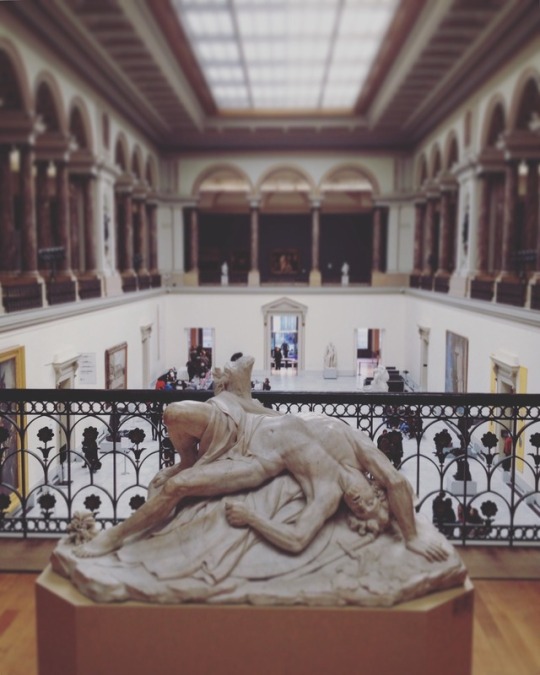
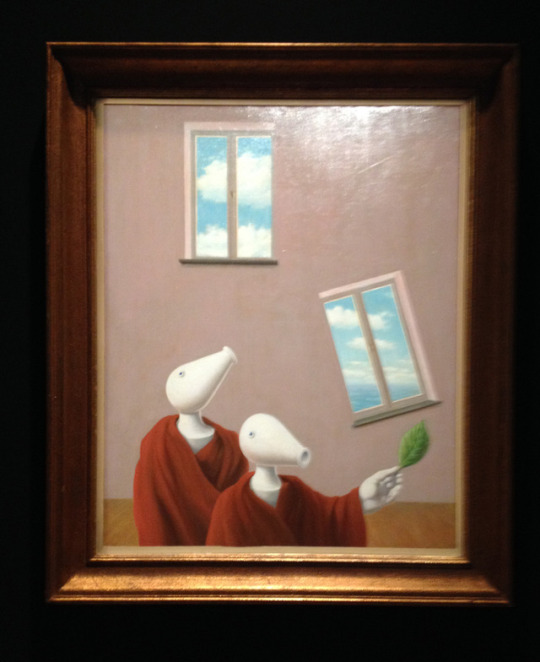
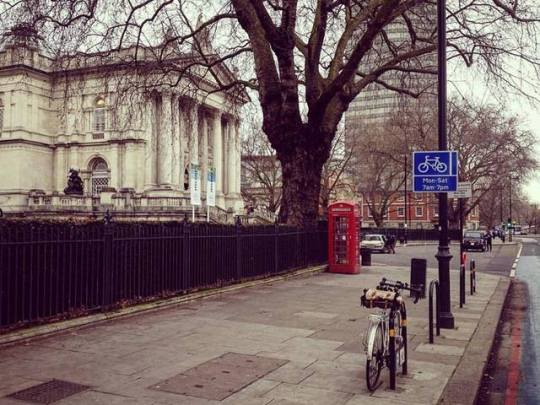
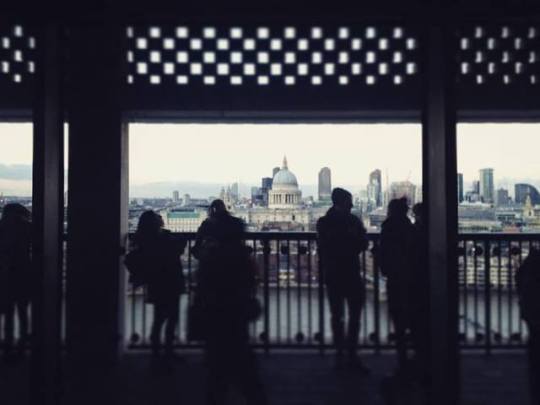
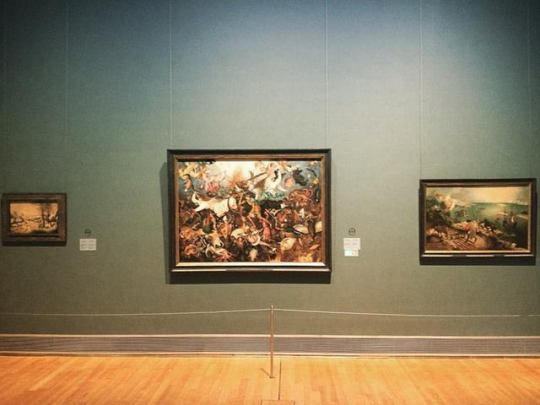
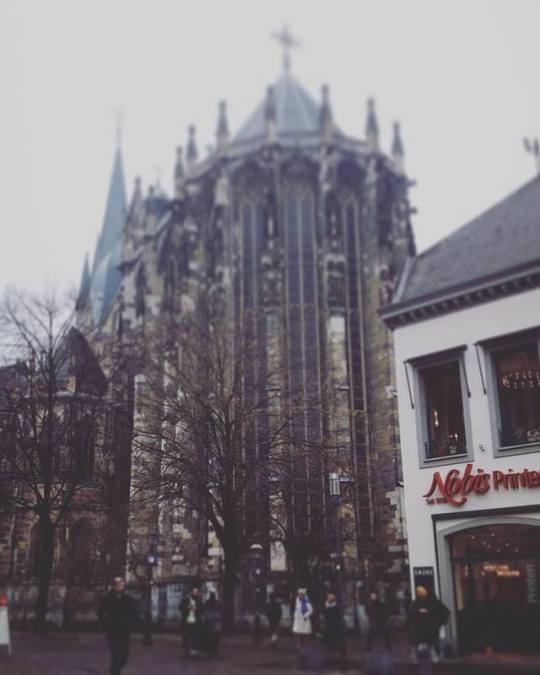
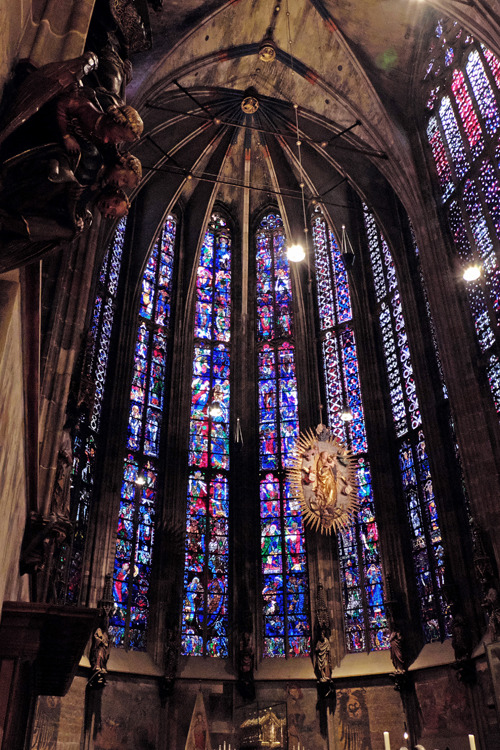

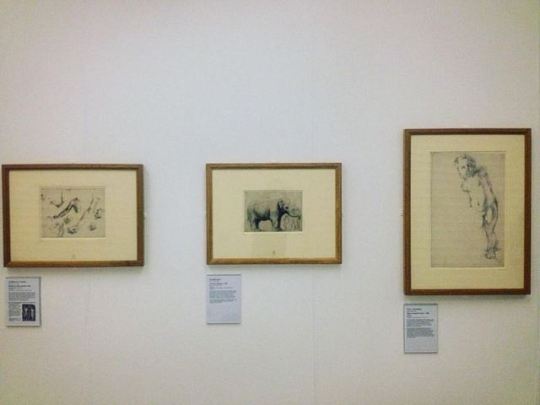
London to the Lowlands- a winter cycle touring trip: the art and culture
Following 2 initial posts, describing the planning/cycling and the places I visited, this third blog post on my series of my winter cycle in the Netherlands/Belgium takes a slightly different angle- and focuses on the art and culture I managed to experience on my travels. I think it is important to understand that cyclists often have interests out with cycling, and that there are often great opportunities for using a bike as a way of accessing and partaking in such wider interests. I have had an interest in art and culture for a long time, but it is in recent years as I have got more involved in cycling that I have actually been able to reach a wider range of exhibitions, galleries and locations- both in and around my home city of Glasgow, but furthermore more widely in Scotland and in other countries that I visit.
During my January cycle trip I passed through the major European cities, and the home of major art collections, of London and Brussels- while furthermore manged to incorporate visits to other significant cultural heritage sites that I had been aware of, such as the cathedral in Aachen and the UNESCO heritage site of Leuven’s old town. (A previous cycle trip to the region allowed me to incorporate visits to the galleries and museums of Amsterdam and The Hague, the beautiful and historic old towns of Brugge and Haarlem, and furthermore initially unplanned visits to the memorable Kröller-Müller Museum and the emotional Westerbrook World War 2 refugee transit camp.)
It is perhaps these unexpected cultural visits and experiences that you have when cycle touring that demonstrate the value and opportunity of combining cycle touring with accessing art and culture. Two examples are evident from my January cycle. The impromptu stop I made at Brussels’s Cinquantenaire Museum/ Royal Museums of Art and History to see its Ukiyo-e exhibition of Japanese art- including the famous ‘Great Wave’ by Hokusai (an exhibition I only became aware of because the cycle path I was following took me through the Parc de Cinquantenaire). The overnight stay I had in the tiny village of Stevensweert in the middle of the Maas River- historically important due to the fact the Spanish had built a fortress there during the Dutch War of Independence in the 16/17th century, and still retaining the hexagonal street layout from that period (again a place I would unlikely to have reached by other forms of transport).
The images here are of a few of the fantastic art, cultural and historic attractions I managed to see on my journey- while some of the specific art/cultural things I got up to included:
- London: Using my Art Fund pass, and travelling between numerous galleries by bike, allowed me to affordably access numerous exhibitions and locations across city during the few days I was there- from a Paul Nash exhibition at the Tate Britain, a number or shows at the Nordic Matters festival at the Southbank Centre, a Caravaggio exhibition at the National Gallery, the Wildlife Photographer of the Year at the Natural History Museum, and Maps of the 20th century at the British Library. I also managed to visit the new Design Museum at Holland Park and climb the Switch House tower at the Tate Modern, affording some new spectacular views over the London skyline.
- Brussels: As well as the Ukiyo-e exhibition featuring work by Japanese artist Hokusai and a number of his contemporaries, I furthermore visited the Royal Museum of Fine arts to see a exhibition containing a number of Peter Bruegel ‘s most famous pieces (including ‘Fall of Icarus’) as well as seeing several other significant European works (the likes of ‘The Death of Marat’ by Jacques-Louis David and ‘The Temptation of St. Anthony by Salvador Dali). I also visited the Rene Magritte museum to see works by Belgium’s Surrealist master.
- Aachen: In a day trip from Maastricht, I cycled to the German city of Aachen to see its quite majestic cathedral- the oldest cathedral in Northern Europe, dating from the 8th century, and which has been developed over its 1000+ year lifetime into an architectural wonder of numerous artistic styles in addition to its religious and historic significance.
- Hull: Not normally referred to in the same breath as these other locations for its art and cultural heritage- but Hull, the port on the east coast of England where my ferry from Rotterdam docked, is the UK’s City of Culture for 2017. Numerous events throughout the year make the city a place to really consider visiting for art lovers in 2017- and I saw the fantastic ‘Lines of Thought’ exhibition on the last day of my trip, with sketches by many of the greatest European artists in history- Rembrandt to Durer to Cezanne.
#cycling#cycle touring#cycle#cycling adventures#sustainability#sustainable travel#mobility#art#culture#art galleries#architecture#cultural heritage#belgium#netherlands#history#lowlands
3 notes
·
View notes
Text
7 Day Netherlands Travel Itinerary and Guide
The Netherlands is a beautiful country filled with towns, cities, and villages that are all very unique and diverse, and also one of the best destinations to travel to for Solo Travellers. It is a small country and therefore, spending one week in the Netherlands is just enough time to get a taste of some of the top places within the country. Of course, more time is always better, but this 7 Day Netherlands Travel Itinerary will give you the best Holland experience in the limited time that you have.
What’s great about travelling around the Netherlands is that, as previously mentioned, it is a very small country and that means getting around and travelling around seeing a lot of cities is very easy. Journeys between destinations are scenic and quick and offer tons to see along the way. With only seven days in the Netherlands you have to be picky on the places you choose to go to. In an ideal world you would go everywhere but, in this case, you have to pick the best of the best.
This Netherlands travel itinerary covers cities like Amsterdam, Rotterdam, Haarlem, Utrecht, Gouda, that will give you the best Holland experience. Feel free to moderate this one week Netherlands itinerary to fit your needs if you prefer to travel slowly and spend a little more time in cities you could cut one or two of the places out of this itinerary in order to make it fit your travel style.
Pin Me
[toc]
Day 1 – 2 | Amsterdam
The first stop on your Trip to Netherlands is the very famous capital city of the Netherlands, Amsterdam. This is by far the most popular city in the Netherlands that attracts millions of tourists a year all eager to explore the stunning canals, quirky houses, and famous landmarks. But to do and see everything you should in Amsterdam, it is suggested you spend at least two days here. The best two days during the week to spend in Amsterdam are the weekend, as Amsterdam during the weekend is when you will find most events and special surprises.
During the two days in Amsterdam be sure to go to The Anne Frank House, visit the Jordaan, eat Dutch cheese, and admire the architecture. There’s so much to see and do and you will surely be lost in the streets and wishing you had a few more days.
(adsbygoogle = window.adsbygoogle || []).push({});
Day 3 | Utrecht & Gouda
After visiting Amsterdam, take a short 20-minute train ride to Utrecht. Here you will find mediaeval buildings, old canals, lively streets and a ton to see. Spending the day here will show you another beautiful city in the Netherlands that is much less busy and touristy than Amsterdam. Utrecht is also very close to Gouda which is another city in the Netherlands famous for its Gouda cheese. Therefore, after spending one day in Utrecht it is suggested to leave early the next morning and make a quick top in Gouda before visiting the next city.
(adsbygoogle = window.adsbygoogle || []).push({});
Day 4 | Rotterdam
A quick morning stop in Gouda is perfect before visiting Rotterdam. Gouda is an authentic Dutch town whereas Rotterdam could not be any more different. Rotterdam is a city that was completely destroyed during World War II and therefore it looks very different from the other cities in the Netherlands because it was rebuilt in a more modern style than the classic style. It is such an interesting place to explore and see a more modern futuristic side to the Netherlands.
Day 5 | Den Haag
The Hague | Flickr | R Boed
The Hague is an interesting city that is known as the political capital of the Netherlands. Find various embassies, political buildings, and palaces in the Hague which are stunning and great to photograph. The most interesting and enticing aspect of the Hague is the beach called Scheveningen beach. This is a large sandy stretch of beach that becomes filled with people in the summer!
Day 6 – 7 | Haarlem
Spend the last two days of this One Week Netherlands Travel Itinerary, in Haarlem. Haarlem is also regarded as a mini Amsterdam because it looks quite similar but with much fewer tourists. This is a great place to explore by foot or by boat, plus it is close to the famous Zaanse Schans which is an area full of authentic Dutch windmills!
Spend two days in Harlem and you will be able to explore the city plus venture outside and go to Zaanse Schans. What’s also great is that Harlem is very close to Amsterdam (only 20 minutes by train) so if you are flying out from Amsterdam you are close and don’t need to travel far to get to the airport.
Zaanse Schans, Netherlands | Unsplash | Tommy Ferraz
(adsbygoogle = window.adsbygoogle || []).push({});
The 7 Day Netherlands Itinerary – Summarised
Day 1 – 2 | Amsterdam
Day 3 | Utrecht & Gouda
Day 4 | Rotterdam
Day 5 | Den Haag
Day 6 – 7 | Haarlem
Tips and Recommendations for your Trip to Netherlands
How to get around The Netherlands
The Netherlands is very easy to travel around. The easiest way is by train and luckily the train transportation system in the Netherlands is one of the best in Europe. The trains are running constantly throughout the day and are a very fast way to get from city to city all around the country. However, if you are taking the train very often you might see the price catch up with you. The trains in the Netherlands are on the more expensive side and if you find yourself on a train every day it can get quite pricey.
If you are looking to save some money on transportation you can also rent a car. Driving in the Netherlands is quite easy as there are not many major highways. Plus if you have your own car you can stop along the way and check out any additional places that are along the route.
Weather in The Netherlands
The one thing that is not so great about the Netherlands is the weather. The Netherlands is notorious for raining very often and seemingly out of nowhere. You’ll most likely get used to these types of weather conditions and you just have to make the best of exploring in a little bit of rain. However, what’s great about the weather is that the Netherlands is a pretty mild country meaning in the winter it is cold but not very often in the negatives and during the other seasons you can expect mild and not extreme temperatures.
(adsbygoogle = window.adsbygoogle || []).push({});
I hope you found this 7 Day Netherlands Travel Itinerary, to be of help to you, as a reliable Travel Resource for planning your Trip to Netherlands. Don’t forget to Pin these images, and save this Best of Netherlands in 7 Days – A Travel Itinerary and Guide, for future travel planning.
#gallery-0-5 { margin: auto; } #gallery-0-5 .gallery-item { float: left; margin-top: 10px; text-align: center; width: 33%; } #gallery-0-5 img { border: 2px solid #cfcfcf; } #gallery-0-5 .gallery-caption { margin-left: 0; } /* see gallery_shortcode() in wp-includes/media.php */
If you enjoyed reading this 7 Day Netherlands Itinerary and Travel Guide, you might want to check out some other 7 Day Travel Guides and Itineraries, as well.
7 Day Road Trip to Scotland
Best of South Africa in 7 Days
The 7 Day Myanmar Road Trip Itinerary
One Week in Crete | Greece – Travel Itinerary and Travel Guide
7 Days in Israel – A Detailed Travel Itinerary
7 Day Road Trip to Bhutan – The Last Shangri La
One Week in Kerala – God’s Own Country
The Epic 7 Day Leh Ladakh Road Trip Itinerary
And if you like reading the content I create and curate, I will be really thankful if you could
LIKE | COMMENT | SHARE and SUBSCRIBE
Also, if you’re on Facebook, I would love to have you as a part of
the Eat Travel Live Repeat Travel Community
You are following this blog
You are following this blog, along with 11,607 other amazing people (manage).
One Week in Netherlands | Travel Itinerary and Guide 7 Day Netherlands Travel Itinerary and Guide The Netherlands is a beautiful country filled with towns, cities, and villages that are all very unique and diverse, and also…
0 notes
Text
Most Scenic Towns Worth Exploring At Least Once in The Netherlands
Finding natural beauty and adventure is never a struggle in the Netherlands, the Dutch city is world-famous from flat green tulip gardens in Keukenhof, the coastal provinces of Noord Holland, the exuberant windmill, the historic sites of Haarlem, the quaint little Dutch villages are worth exploring at least once. Unlike Amsterdam, Netherlands is a place where modernity mix with tradition. Whether you are religiously looking for artistic masterpieces, cutting else design, old age windmills or romantic cafes the city promises endless adventures and memorable experiences on all occasions.
https://www.sooperarticles.com/travel-articles/destination-tips-articles/most-scenic-towns-worth-exploring-least-once-netherlands-1767819.html
0 notes
Text
הפוסט הזה ״הושבילים״ מציג כיצד בני הדור השני והשלישי מנציחים את קרוביהם שנרצחו בהשואה. כאן נחשוף בפניכם סיפור אישי ומשפחתי. הפוסט הזה מיועד להציג את פרויקט אבני נגף Stolperstein (בגרמנית) – Struikelstene (בהולנדית) של האמן הגרמני גונטר דמניג באירופה בכלל והפרויקט בהולנד דרך מסע ההנצחה של סבא וסבתא של משפחתי, תושבי הילפרסום-Hilversum בהולנד, שגורשו למחנה ווסטרבורק בשנת 1943 ונרצחו באכזריות בשנת 1943. נסקור כאן את תולדות העיר הילפרסום והאיזור Het Gooi, תולדות הקהילה היהודית במקום, הכיבוש הנאצי בהילפרסום, והשואה בהילפרסום. בסוף תוכלו לצפות בסרטון איכותי מאוד (בהולנדית) על תקופת הכיבוש הנאצי והשואה בעיר הילפרסום. [לנוחיותכם סיכמתי בעברית את הנקודות המרכזיות של הסרטון.]
הזריזות של ההולנדים לקיים את ״הפתרון הסופי״
ועידת ואנזה (Wannseekonferenz) התקיימה ב-20 בינואר 1942. בועידה הנאצים קיבלו החלטת לבצע את ״הפתרון הסופי״ – התוכנית להשמדת יהודי אירופה. עד אמע יוני 1942 כל יהודי הילפרסום כבר גורשו לאמסטרדם. בטקס Struikelstene – אבן נגף של של המשפחה שלנו, שהתקיים ב- 10.09.19, ראש הקהילה היהודית הקטנטנה של הילפרסום, מר קליין, הדגיש שבעיר זאת מילאו את הוראות בנאצים בזריזות ובדייקנות.
אבני נגף – Struikelstene (בהולנדית) – Stumbling Block (אנגלית)
אבני נגף – Stolperstein (בגרמנית), הוא שמו של פרויקט הנצחה מיוחד בערים שונות באירופה. הפרויקט הוא פרי יצירתו של האמן הגרמני גונטר דמניג. דמינג הוא בן “הדור השני” – אביו היה חייל נאצי. בחברה הישראלית, הביטוי “הדור השני” מכוון לילדיהם של ניצולי השואה. ואילו בגרמניה, הביטוי “הדור השני” מכוון לבניהם ולבנותיהם של גרמנים שהיו נאצים בעלי עבר קודר ואפל. דמינג מייצר את כל האבנים וחורט עליהן בעצמו. זאת, בשל רצונו שפרויקט ההנצחה יישאר אישי. האבנים בולטות מעט מעל פני המדרכה. גם כיום, לאחר שהניח מאות אלפי אבני נגף קטנות, דמינג מקפיד לחקור את פרטיהם של כל איש, אישה, ילד או ילדה שהוא מנציח.
ראשיתו של סיפור ההצלחה בתערוכה של דמניג ב-1991. אז הניח לראשונה סרט של כ-16 קילומטר לאורך שביל ששימש את הנאצים במאי 1940 כדי להוביל אלף צוענים מהעיר קלן שבמערב גרמניה לקרונות הרכבת הנוסעת מזרחה אל מחנות ההשמדה. זו הייתה חזרה כללית לקראת השמדת היהודים.
יש אנשים עם לב של אבן, יש אבנים עם לב אדם. (הכותל מילים: יוסי גמזו)
https://upload.wikimedia.org/wikipedia/commons/transcoded/3/34/Verlegung_Stolperstein_Historisches_Rathaus_K%C3%B6ln.WebM/Verlegung_Stolperstein_Historisches_Rathaus_K%C3%B6ln.WebM.480p.vp9.webm
אבני הנגף של דמניג שקועות במדרכות בערים שונות במטרה להזכיר לעוברים ושבים את קורבנות הנאציזם. נכון לסוף שנת 2018 הונחו מעל ל-70,000 אבני נגף בערים רבות ברחבי אירופה:בכ-610 יישובים בגרמניה, באוסטריה, באיטליה, בהולנד, הונגריה, אוקראינה, מקדוניה, צ’כיה ובלגיה. האבנים מציינות קורבנות הנאצים יהודים וגם מקהילות שונות: צוענים, אנשים שהומתו במסגרת תוכנית האותנסיה הנאצית (שסבלו מפגמים גופניים, כמומים מולדים או מחלות כרוניות וכן מקשיים נפשיים כמובן), אסירים פוליטיים, הומוסקסואלים וחסרי בית)
ב-1995 הניח דמניג באופן נסיוני (ומבלי לקבל רשות) את האבנים הראשונות ברחובות קלן
ב-1995 הוא הניח את “אבני הנגף” בקרויצברג, שכונה בברלין.
ב-1996 הניח דמניג 55 אבנים בברלין במסגרת פרויקט “אמנים מחפשים את אושוויץ”.
ב-1997 הונחו שתי האבנים הראשונות לזכר עדי יהוה בעיירה סט. גאורגן, ליד זלצבורג.
ב-2001 לאחר שהוסרו המכשולים הבירוקרטיים, הוא קיבל רשות להניח עוד 600 אבני-נגף בקלן.
Laying of stumbling blocks – The photo shows the artist Gunter Demnig
דמניג מכין קוביית בטון בגודל 10X10 ס״מ, ומחבר אליה לוחית פליז, עליה נחרטים הפרטים הבאים: הכותרת “כאן גר…” או “כאן חי…”, שם הנספה, שנת הלידה ומה עלה בגורלו – על פי רוב תאריך המוות או המשלוח למחנה.
התנגדות לאבני נגף: התעוררה התנגדות לאבני נגף בערים שונות מכמה סיבות: האבנים מזכירות את השימוש של הנאצים במצבות קברים בסלילה, הולכי רגל ידרסו על האבנים, פחד מאינפלציה של אנדרטות, וסתם אנטי-שמיות.
אבני נגף בהולנד
פרויקט אבני נגף פעיל מאד בהולנד. אבני הנגף בהולנד הונחו בנובמבר 2007 ב-Borne. הראשונים בהילפרסום הונחו ב2009. כל אבני הנגף בהולנד ובלגיה הם של יהודים.
ב-אפריל 2009 ב-Sneek ו-Glanerbrug.
במאי 2009 ב:Bos en Lommer, Westerpark, Zuideramstel, Oud-Zuid Amsterdam, Weesp, Eindhoven,Almelo, Borne, Doesburg, Zaandam, Haarlem and Leiden
ב-אפריל 2010 ב-Holten, Haaksbergen, Tilburg, Roosendaal, Werkendam, Tiel, Rotterdam, Utrecht, Hilversum, Leeuwarden and Haren. הונחו גם ��-Amsterdam and Utrecht לזכר השחקנים היהודיים שזכו במדליות זהב באולימפיאדה של 1928.
עירית הולפרסום מחליטה להמשיך מבצע ״אבני הנגף״ – Hilversum continues with stumbling stones
Tuesday 26 Feb 2019
HILVERSUM – The municipality will continue to place stumbling stones in Hilversum. The college decided that today. The municipality asks the Foundation for the Preservation of the Jewish Heritage Gooi and Vechtstreek to place 408 stumbling stones in the coming years. This brings the World War II memorials to the entire city. The stumbling stones are placed in memory of the Jews who lived in Hilversum during the Second World War, were taken away and put to death. The small, gold-shining stones on the sidewalk are therefore a tangible reminder of the horrors of our time. The stumbling stones are an initiative of German artist Gunter Demnig and together form the largest art project in public space in Europe
The city council of Hilversum already decided in 2015 that they wanted 750 stumbling stones to be placed throughout the city. The project has paused for a while, but is now being restarted. Responsible alderman Wimar Jaeger is happy with the decision. “I am very happy that we can now complete the making of the memory permanent. It would be unthinkable that not all Jewish victims are commemorated in this way.” The Foundation for the Preservation of the Jewish Heritage Gooi and Vechtstreek has been placing stumbling stones since 2009. They placed the first 272 stumbling stones in front of the municipality and also erected the Rudelsheim monument, in memory of 70 deported and killed children and supervisors of the former Rudelsheim Foundation. The foundation will also place the remaining 408 stumbling stones. Because Hilversum is not the only place that waits for the ten by ten centimeters of small stones and Demnig, as Jaeger says, also has only two hands, it takes a few years before all the stones are placed. The alderman hopes for roughly thirty to forty stones per year. It will soon become clear when and where the next stones will be placed
תולדות העיר הילפרסום בהולנד
הילפרסום (Hilversum – משמעות: הבית של הילברט) ממוקמת במרכז Het Gooi (המכונה ביתם של העשירים והמפורסמים). קוראים לה ‘garden city’ +’villa village’ +’garden of Amsterdam’. הילפרסום היא העיר החשובה ביותר ב- Het Gooi. היא עלתה על Naaden נמאה ה-18 בגלל ההתפתחות המהיר של צמר, טקסטיל ושטיחים. משפחות עשירות מאמסטרדם בנו בתים בהילפרסום ויצרו אוירה קתולית בעיר. הם בנו את הכנסייה הקתולית – כנסיית St . Vitus Church של הארכיטקט Pierre Cuype. הכומר של כנסייה זו, Pastor J. Dresmé, שהיכר את משפחתנו בלוויה של To Van De Weijer, השתתף בטקס ה-Struikelstene שלנו.
St. Vitus Church (architect Pierre Cuypers, construction Karel de Bazel), in a watercolor by K.P.C. de Bazel Rijksdienst voor het Cultureel Erfgoed הכנסייה הקתולים הגדולה במרכז הילפרסום. הכומר של הכנסייה השתתף בטקס ״אבן נגף״ שלנו
הילפרסום היא מרכז שידורי הרדיו והטלויזיה. בית חרושתNederlandse Seintoestellen Fabriek למכשירי שידור וקליטה של רדיו נבנה בשנת 1918 ובעקבותיו הוקם Netherlands Public Broadcasting. תחנת הרדיו של הילפרסום שידרה ב-1933 תוכנית ״Talk on Palestine״ ותוכנית שירה ביידיש ועברית: Jewish Songs, sung by Leo Fuld : 1, Ghetto (Benatzky ; 2, Yismach Moshe (Roskin) ; 3, Gott in sein Mishpot is gerecht (Meierowitz-Berman) ; 4, Steh auf, mein Volk (Goldfaden.
בית העירייה Raadhuis van Hilversum הוקם בשנת 1931 על ידי הארכיטקט Willem Marinus Dudok. בשנות הכיבוש הנאצי היה משרד ה- Wehrmacht. המגדל הבולט הוסווה מעיני הטייסים האנגלים והאמריקאים. קריון – carillon הפעמונים במגדל צילצלו חי כל שעה עגולה מלפני 1940 עד שנות ה-1960.
Roundtheworld – Own work Hilversum Town Hall: the finest example of the work of architect Willem Marinus Dudok בנין עיריית הולפרסום נחשב השג ארכיטקטוני. מיד לאחר בכיבוש הגרמני הפך למשרדי הצבא הגרמני.
האוכלוסיה מתמעטת ומזדקנת. ב-1965 היו 103,000 תושבים ובשנת 2016 רק 88,000. בניית מספר בתי אבות בעיר גרם לעלית הגיל הממוצע. בעיר יש תחנת של ״Gooilijn״ רכבת (Amsterdam / Schiphol – Amersfoort). בהילפרסום גשר הטבע (ecoduct) הארוך בעולם. הילפרסום איחרה את ה- 1958 Eurovision Song Contest.
Gooiland map drawn between 1725 and 1734 by Reinier and Joshua Ottens יוצר Inter-Antiquariaat Mefferdt & De Jonge מפת איזור Gooi סביב הילפרסום סורטט בין 1725-1734
Het Gooi – איזור חואי
משמעות השם היא יחידה מנהלית בתוך מדינה, והוא מקביל למונח “מחוז”. Het Gooi הוא האיזור סביב הילפרסום במחוז הולנד הצפונית. יחד עם Bussum ,Naarden ,Huizen ,Laren ,Blaricum הן יוצרות Randstad רנדסט סוג של ״metropolitan area״. Het Gooi היה אחד האיזור הראשונים להתישבות קבע בהולנד. התושבים היו רועי צאן ובקר.
Historic map of the Gooi מפה הסטורית של איזור חואי -Gooi
תולדות יהודי הילפרסום
בעת גירוש ספרד בשנת 1492 נמלטו חלק מיהודי ספרד לפורטוגל. אולם אף בפורטוגל המשיכו היהודים לסבול את רדיפות האינקוויזיציה וחלקם נאלצו להתנצר. מאה שנה לאחר גירוש ספרד, הגיעו לאמסטרדם צאצאי האנוסים מספרד ופורטוגל. באותה תקופה נלחמה הולנד בספרד, ולכן העדיפו היהודים שבאו מחצי האי האיברי, לקרוא את קהילתם “הקהילה הפורטוגזית” ולא הקהילה הספרדית.
במאה ה-17 אנשים עברו ממדינה למדינה בדומה להיום. מלחמת 30 השנה (1618-1648) ופרעות ת״ח-ת״ט ב1648 גרמו לבריחה של מיליוני אירופאים. גם אפליה דתית גרמה לרבים לחפש בתים חדשים. הרפובליקה ההולנדית, יחסית משגשג, וסובלנית, במיוחד באמסטרדם במחוז העשיר הולנד היוו מגנט לרבים. אמסטרדם גדלה פי שלשה במחצית הראשונה של המאה. העיר נזקקה לפועלים, עוזרות, בנאים, בעלי מלאכה, פועלי דפוס, מלומדים, וימאים לקיים את המשק הצומח והתרבות הבורגנית. האוכלוסיה היתה מאד מגוונת. הצייר רמברנדט שהתגורר ברובע היהודי גילה דוגמנים אקזוטיים המתאימים לציורי התנ״ך מבין המהגרים.
הצעדים הראשונים לקראת הקמתו של ארגון שירכז את כל הקהילות היהודיות נעשו כבר ב-1808, תחת שלטונו של נפוליאון.
חיים יהודיים בהילפרסום התחילו כבר בראשית המאה ה-18. אז התפללו ב-Kerkstraat לידGroeststraat.
בשנת 1751 נחנך בית עלמין על Gooise Vaart. בית הקברות היה בשימוש עד 1863 כאשר נרכש שטח ב-Vreelandseweg להקמת בית קברות חדש. הקברים בבית הקברות הישן הועברו בשנת 1937.
Postcard of the Gooische Vaart in Hilversum with the jewish cemetery, ca. 1914 בית הקברות היהודי העתיק מימין לתעלת Gooische Vaart
בשנת 1781 ראשי הישוב אישרו הקמת קהילה יהודית.
בשנת 1788 הגישו בקשה להקמת בית כנסת.
בית הכנסת הוקם בשנת 1789.בית הכנסת היה ב-Zeedijk. הקהילה שגשגה. הארגונים היהודיים כללו ועד בית הכנסת, חברה קדישא, גמ״ח, ארגון נשים, ובית ספר יהודי ב-Zeedijk. מרכזים רפואיים יהודיים כללו: Rudelsheim Foundation , Beth Azarya, Beth Refu’a sanitarium, Friedman Foundation childrens health colonies, De Bergstichting orphanage, Zonnestraal sanitarium
Postcard of the Friedman Foundation in Hilversum, ca. 1930 צילום של בית החולים היהודי לילדים בהילפרסום
במאה ה-19 רוב היהודים היו קצבים או סוחרים.
בשנה הראשונה של מלחמת העולם השנייה עלה המספר לכ-1400, כאשר פליטים יהודים מגרמניה אולצו להתיישב בה ובכמה ערים אחרות.
הצמיחה הגדולה ביותר של הקהילה היתה בין 1900-1930. הקהילה מנתה כאלף אנשים ב-1930 (600 משפחות) לפני המלחמה.
אוכלוסיה יהודית בהילפרסום והסביבה
1789 80 1809 184 1840 160 1869 246 1899 538 1930 1007 1951 200 1971 150 1998 40
Post-WWII Synagogue in Hilversum, The Netherlands בית כנסת בהילפרסום לאחר מלחמת העולם השניה
לאחרונה מדובר על איחוד הקהילות היהודיות של הילפרסום ובוסום.
תולדות משפחת ויינברג-Wijnberg (אדוארד אפרים ויינברג ורעיתו ריינה לבית
יש עדות למגורי משפחת ויינברג בצפון הולנד באופן רצוף מלפני תקופת נפוליאון. יתכן שהם היגרו מגרמניה במאה ה-17 או ה-18. משפחת ואן מנק לעומת זאת היא מעיר במרכז הולנד לא רחוק מהילפרסום.
משה יצחק ויינברג נפטר 1790 עמנואל טוביה ואן מנק
פיליפוס יצחק ויינברג גרונינגן 1785-1803 שלמה ואן מנק הרדרויק 1781-1834
יצחק ויינברג גרונינגן 1800-1872 עמנואל ואן מנק הרדרויק 1813-1894
פיליפוס ויינברג זודלרן 1824-1906 יעקב ואן מנק הרדרויק נולד 1854
יצחק ויינברג גרונינגן 1852-1934 (למטה רישום קבורתו בספרי הקהילה)
אפרים אדוארד ויינברג זודלרן 14.7.1881 – סוביבור 26.3.1943 י״ט אדר ב׳
ריינה ואן מנק הרדרויק 27.4.1888 – סוביבור 26.3.1943 י״ט אדר ב׳
ריינה ואן מנק-ויינברג למדה להיות קצרנית (סטנוגרפית) – 90 הברות לדקה עם שיחזור מהיר. הדוד היה סטנוגרף בפרלמנט ההולנדי.
איזידור יצחק ויינברג גרונינגן 22.8.1917 – אושוויץ 31.1.1943 כ״ה שבט
חתונה במלחמה של איזידור יצחק דוריס ויינברג וג׳נט אמה לבית במברג. נוכחו הורים ואחים
ואשתו ג׳נט אמה לבית במברג קלן, גרמניה 16.6.16 אושוויץ 24.9.42 י״ג תשרי
Memorial Book of the Federal Archives for the Victims of the Nazi Persecution of the Jews in Germany (1933-1945) תאריך רציחת ג׳נט אמה ויינברג בארכיון הגרמני הלאומי
בטסי (ביילה מינדלה) ויינברג – ארליך Groningen-חרונינגן 24.6.1919 – קרית אתא 27.7.1988 י״ג אב
ריינה לבית ואן מנק נולדה בהרדרויק. אדוארד וריינה התגוררו תחילה בחרונינגן במחוז חרונינגן בצפון המדינה. ילדיהם איזידור יצחק ובטסי נולדו בחרונינגן. ולאחר מכן עברה משפחת ויינברג להילפרסום במחוז Noord-Holland.
בטסי ויינברג ומקהלת הילדים של רדיו הולפרסום
Hilversum is often called “media city”, since it is the principal centre for radio and television broadcasting in the Netherlands, and is home to an extensive complex of radio and television studios and to the administrative headquarters of the multiple broadcasting organizations which make up the Netherlands Public Broadcasting system. Radio Netherlands, which has been broadcasting.
העיר הילפרסום מופיעה על כל מכשירי הרדיו באירופה (שמאל למעלה). כאן על מכשיר גרמני משנת 1939(צילום Ingeborg Wilke)
One result of the town’s history as an important radio transmission centre is that many older radio sets throughout Europe featured Hilversum as a pre-marked dial position on their tuning scales
הושבילים ביקר אצל חברים במזרח גרמניה בעלי אוסף של מכשירי רדיו עתיקים. בכולם בלט שם עיר השידור ההולנדי: ״Hilversum״
AVRO Childrens Choir – prewar (צילום לואיז אלפרדינג Louise Elverding) מקהלת הילדים של רדיו AVRO בהילפרסום
בטסי ויינברג בילדותה שרה כל שבוע במקהלת הילדים בניצוח של יעקב המל בתחנת AVRO cרדיו . המקהלה נוסדה ב-1929 בניצוח של Jacob Hamel – יעקב המל (1883-1943). כל יום שלhשי בשעה 17:00 היה שידור של מקהלת הילדים ברדיו. היו חוברות ותקליטי LP עם כל השירים ששרו במקהלה. במאי 1940, מיד לאחר הכיבוש הגרמני יעקב המל פוטר עקב יהדותו. המל נרצח בסוביבור.
youtube
youtube
הכיבוש הנאצי של הולנד
״הקרב על הולנד״ נמשך מ-10 במאי עד 14 במאי 1940. הקרב הסתיים בניצחון גרמני בעקבות כניעתה של הולנד, לאחר הפצצת רוטרדם בידי הלופטוואפה. הנאצים ציפו שיהיה קל לספח את הולנד כמו האנשלוס – Anschluss של אוסטריה. הפרעות של הקומוניסטים ההולנדים מנעו תוכנית זו.
‘עובד המספנה’, האנדרטה לזכר שביתת פברואר 1941 שפיסל מרי אנדריסן. ברקע בית הכנסת הפורטוגזי. צילום:Gus Maussen
מעצר יהודים הולנדים בפברואר 1941 באמסטרדם
הכיבוש הנאצי של הילפרסום
בלילה בין 14-15 למאי 1940 הצבא ההולנדי פוצץ את מגדל השידור של Nederlandse Seintoestellen Fabriek בהילפרסום. בלילה ב-14 למאי 1940 ה-Wehrmacht לקח את העיר ללא יריה אחת. לפני הכיבוש הנאצי כבר היו בהילפרסום 1000 פליטים יהודים מגרמניה. בשנה הראשונה של מלחמת העולם השנייה עלה המספר לכ-1400 פליטים יהודים מגרמניה. ראש העיר של הילפרסום Karel de Wijkerslooth והוחלף עלידי Ernst von Bönninghausen חבר התנועה הנאצית.
בפרואר 1940 Karel de Wijkerslooth התמנה ראש עיריית הולפרסום. במשך החדשים הראשונים של המלחמה הוא נשא נאומים המיועדים למעמד הביניים בעיר בעיקר על נושא ארגון חיי היום-יום. בהדרגה הוא התחיל לתמוך בעמדות התומכות בגרמנים. ב-1940 הוא ייסד תנועה משלו – National Unity. ב2 ביולי 1940 הוא הכריז בישיבת מועצת העירייה על עצמו כמנהיג העם ההולנדי. הוא הקריא קטע מאילן היוחסין שלו לפיו נראה שלפי הקו הנשי של משפחתו הוא צאצא של Willem van Oranje גיבור הלאום. חברי המועצה התיחסו בקרירות ודחו את טענותיו של ראש העיר. הוא פוטר ב11 ליולי 1940. הוא התנדב להיות חייל ב-Waffen-SS ומ-1942 הוא נלחם בחזית המזרחית.
Ernst von Bönninghausen הצטרף לתנועת National Socialist Movement (NSB). בשנים 1940-1943 הוא מילא את תפקיד ראש העיר (government commissioner) של הילפרסום. לאחר מלחמת העולים השניה הוא נידון לשנתיים בכלא.
כריסטיאן, המפקד העליון של הצבא הגרמני בהולנד, התיישב בבית העירייה בהילברסום. המגדל הבולט של בית העירייה הוסווה מיד. מכאן ואילך בית העירייה נקרא גם “מבצר הילברסום“. Foto:http://www.nicospilt.com
הגירוש והרצח של חבר עיריית הילפרסום היהודי דוד לופז דיאס
להבדיל – חבר העיריה David Lopes Dias נאלץ להסתתר ובסוף מת ב- Mauthausen. מפקדת ה- Wehrmacht בהולנד התמקם בעיריה של הילפרסום. מחסומי טנקים הוקמו סביב לעיר ובונקרים (Wisseloord bunkers-Blaskowitzbunke על שם המפקד המקומי של הורמאכט) נחפרו.
The Memorial to David Lopes Dias in Hilversum is a reminder of alderman and resistance fighter David Lopes Dias. David Lopes Dias was an ardent fighter against Nazism and wrote for the first underground papers. David Lopes Dias was deported to the Mauthausen concentration camp, where he was killed on juli 10, 1942. Anneke Moerenhout הנצחה לחבר העיריה דוד לופז שנרצח בשואה
השואה בהילפרסום
השואה הכתה בהילפרסום מכה קשה. שלשה יהודים מיד התאבדו. עד אמע יוני 1942 כל יהודי הילפרסום גורשו לאמסטרדם. בית הכנסת ב- Zeedijk נהרס ב-1942. כלי קודש שהיו בבית הכנסת נגנבו אך ספרי התורה הוסתרו מראש ושרדו עד גמר המלחמה. מבנה בית הכנסת פורק חלק חלק על ידי התושבים בתקופה קשה של מחסור בחומרי בעירה ורעב בחורף 1944-1945.
באפריל 1943 אחרוני יהודי העיר גורשו למחנות ריכוז דרך כפר Vught. רק כעשרה אחוזים מיהודי העיר נשארו בחיים (ביניהם לשמחתי אמה של אשתי). שרדו כ-200 יהודים. בית Rüdelsheim שהיה מוסד לפגוע נפש הוחרם. תלמידים יהודים הועברו לבתי ספר מיוחדים. חלק ממנהלי בתי הספר הסכימו למסור רשימות תלמידים יהודיים. רק בבית ספר HBS סירבו המנהל ומורה אחד למסור רשימות יהודים והם נעצרו בגלל זה.
A Sign from the Period of Nazi Occupation of Hilversum, Holland: “Forbidden for Jews…!” Yad Vashem Artifacts Collection Gift of W. Niemoeller, Hobrede, Netherlands שלט נאצי שנשאר במקום בהילפרסום עשרות שנים לאחר השואה.
השואה הכתה בהילפרסום מכה קשה: רק כעשרה אחוזים מיהודי העיר נשארו בחיים.
הסיפור של רחוב וונדלפאד, שכונת Sint Vitusbuurt, הילפרסום
מספר גדול של יהודים התגוררו בשכנות טובה ברחוב וונדלפאד Wandelpad ליד תחנת הרכבת של הילפרסום. גם הרב של הקהילה היהודית, הרב דסברג, התגורר באותו רחוב ובטסי ויינברג למדה עברית בביתו. היחסים עם השכנים הלא יהודים היו מצויינים.
משפחת ויינברג: אדוארד עומד, ריינה, איזידור, בטסי, ודוד.
הבית ברחוב Wandelpad 90
המבנה האדום בגינה האחורית של משפחת ויינברג ברחוב Wandelpad 90. כאן בטסי כתבה שירים בעברית.
רחוב וונדלפאד – חברות עם שכנים לא יהודים
למשפחתנו (משפחת Wijnberg – ויינברג) מזל מיוחד שהשכנים של משפחת ויינברג היו משפחת ואן די וואייר – Laurens and Johanna Van de Weijer.
משפחת ואן דה וייר
בשבתות נעזרת משפחת ויינברג ב”גויים של שבת” להדלקת חימום ותאורה. משפחת ואן דה וייר עושים זאת ברצון. למשפחה חמישה ילדים טו, ניני, אטיי, נל, והארי. ניני סיפרה לנו: “כשהיינו ילדים שיחקנו בשבת אחת עם ילדי השכונה. חזרנו הביתה וצחקנו מכיסוי הראש השחור שהילדים היהודיים חבשו. אמא שלנו היסתה אותנו: ״היהדות היא דת עתיקה מאוד, אסור ללעוג למנהגים שלה'”. זו הסבתא של לואיז וגילן. הסבתא שלהן היתה עדוקה יותר מהאפיפיור.
משפחת ואן דה וייר החביאה בביתה דברי ערך ואלבומים של משפחתנו ושל משפחות יהודיות נוספות.
To ואחותה בגיל צעיר
טו, הבת הגדולה במשפחה, רכבה על אופניים ביער כשעה כל שבוע לבקר את בטסי במסתור ולהביא תלושי אוכל, עיתונים, ובעיקר לערוך חברה. כאשר בתה בדרכים בשלג ובקיץ בין משמרות גרמנים, אמה היתה מבקשת מהארי הקטן שיכרע ברך איתה בתפילה, ויתפללו ביחד שטו תחזור בשלום. לא פלא ששנים רבות אחר כך טו אמרה לנו: “כשיש בעיה או מחלה במשפחה של אחת מאיתנו, אנחנו נתפלל בשבילכם בכנסייה, ואתם תתפללו בשבילנו בבית הכנסת”. בזכות משפחת ואן דה וייר, יש לנו תיעוד, אלבומי תמונות, מכתבים ומסמכים מהימים הרגועים של לפני המלחמה.
בטסי וילדיה שמרו קשר הדוק עם To במשך שנים רבות. הנה סרטון של To שרה בבית אבות בהילפרסום.
youtube
המחבוא של בטסי
ראש המשפחה היה נפח ומפרזל סוסים ולו קשרים עם חקלאים בכל הסביבה. בזכותו נמצא מקום אצל איכר רווק זקן בשם Jaan יאן וסטברוק מחבוא לבת המשפחה בטסי ויינברג – האמא של אשתי. הכינוי של הבית הקטן של יאן ביער ב-Hollandsche Rading היה “de Vilde Baan״. יאן, פועל חקלאי, איש צדיק ותמים נהג לבטסי כבתו. בבית הקטן הסתיר אחר כך עוד 2 זוגות יהודים. הוא הוכרז כחסיד אומות העולם. האריך ימים עד גיל 91.
שתי ציירות אחיות Gretha Peick – Adri Pieck ציירות את הבית של יאן וסטברוק.
ציור של בית המחבוא על ידי בציירת Gretha Pieck. גרתה נפטרה משפעת ספרדית בשנת 1919. ציור צבעוני של אותו בית – בית המחבוא של Jaan. ציירה Adri Pieck, אחות של Gretha, בשנות ה-30
עדותה של זידי על הבית של יאן וסטברוק
סיפור שואת יהודי הולנד מפי בטסי ויינברך–ארליך ז“ל (סופר על ערש דווי לנכדתה הילה)
כל מה שלא בסוגריים הוא ציטוט מההקלטה של סבתא בטסי. הערות בסוגריים כאלה { } מוסיפות פרטים שלא אמרה כאן.
“ב– 10.5.1940 פלש הצבא הגרמני להולנד, ארץ שקטה, בה היו בזמן ההוא כ– 150,000 יהודים, כ-100,000 יהודים הולנדים וכ-50,000- יהודים שבאו מגרמניה, שחשבו שאולי יהיה להם מקלט בטוח, אבל רק לזמן קצר, כי גרמניה הגיעה גם להולנד. אחרי זה פלשו צבאות גרמניה לבלגיה, משם לצרפת ואחר–כך, בעצם לכל אירופה. הם חשבו גם לעבור לאנגליה אבל זאת לא עלה בידם. לאט–לאט התחילו לפרסם כל מיני הוראות. אסור ליהודים לקנות בחנויות של גויים, אסור ליהודים ללכת לגינות ציבוריות, אסור ליהודים לנסוע ברכבת, אסור ליהודים לנסוע באוטובוס. אסור ואסור ואסור, ולאט לאט התהדקה החגורה סביב ליהודים והחיים הפכו לגיהינום.
אחר–כך התחילו לשלוח גברים למקומות מרוחקים מהערים הגדולות למחנות עבודה ובדרך–כלל גם משם לא חזרו הביתה. בתחילה עוד חזרו לסוף שבוע ובסוף בכלל לא. משם כבר שלחו אותם הלאה. ובמקומות אחרים בהולנד התנהל אחרת.אצלנו, שלחו אותנו קודם לאמסטרדם. עלי לציין שיצאה הוראה שכל היהודים צריכים לקנות את הטלאי הצהוב (גם כן בנקודות, כי כל הטקסטיל גם היה בנקודות) ולתלות על הבגדים ואבוי ליהודי שייתפס ללא הטלאי. קדמה לזה הוראה אחרת שצריך להירשם. כל מי שיש לו סבא יהודי וצריך ללכת לעירייה ולהצהיר: “יש לנו שתי סבתות ושני סבים“. אנחנו בהתחלה טעינו והצהרנו שיש לנו שני סבים וסבתות ותיקנו את עצמנו. היו אנשים שפשוט הצהירו שהיו להם רק שתי סבתות או אחד, ואלה אח“כ היו כאילו חצי יהודים והצליחו להינצל בצורה כזאת, בזמן מסוים. קיבלנו תעודת זהות עליה היתה מוטבעת האות י‘= J גדולה מאוד, ותעודות זהות כאלו בהולנד היה קשה לזייף.
חותמת נאצית בתעודת זהות של בטסי
אם ביקשו תעודת זהות מאדם יהודי, מיד ידעו שהוא יהודי. במצב הזה ב1942- לא זוכרת בדיוק מתי, גירשו את היהודים למקומות מסוימים. העיקר, אצלנו, שהיינו קרובים לאמסטרדם – לאמסטרדם. {סבתא התגוררה עם משפחתה בהילוורסם, מדרום לאמסטרדם}התוצאה היתה שהיהודים ישבו בריכוז גדול, ותחת ידם של הגויים.
כיצד התנהל הדבר?
ב-1942, גירשו את היהודים ממקומות מגוריהם למקומות אחרים. אצלנו, שהיינו קרובים לאמסטרדם – לאמסטרדם.
ביום אחד באו ורשמו כל מה שיש בדירה ואוי ואבוי למי שיוציא משהו. אנחנו לפני– כן כבר הוצאנו לשכנים טובים. היו גם תמונות שהורדנו מהקירות, ואז באו ושאלו מה היה תלוי שם. אמרנו שלא יודעים. שאלו גם כן אם יש פוליסות ביטוח, כי הם חשבו לגנוב את היהודים וגם את הביטוח–חיים שלהם יכניסו לכיס. יום אחד בהיר, או לא בהיר, נאלצנו לעזוב את הבית וסגרו את הבית אחרינו עם כל מה שיש לנו בפנים. אנחנו הצלנו דברי כסף וערך אצל שכנים טובים ויכולנו להביא לאמסטרדם רק מה שאפשר לסחוב. כל אחד עשרה קילוגרם. לפני כן שלחנו קצת דברים לאמסטרדם – לקרובים.
Doris Wijnberg and Jeannette Emma Bamberg – צילום חתונת איזידור יצחק ויינברג וג׳נט במברג-ויינברג
נסענו ברכבת אני והוריי (אחי איזידור יצחק ויינברג כבר היה נשוי עם ג׳נט אמה במברג), אנשים שהיו תושבים 300 שנה בערך בהולנד, ישרים, אהובים. היתה שם אנטישמיות, מעט – לא הרבה, כי הולנד היתה ארץ שבעצמה סבלה מהקתולים נגד הפרוטסטנטים והם קיבלו יפה מאוד את יהודי פורטוגל (ב1650), וגם את יהודי אשכנז, ולאט לאט קיבלנו זכויות מלאות ומהמהפכה הצרפתית היו היהודים שווי זכויות. לפתע הפכנו לאנשים חסרי כל זכויות, נתונים לרדיפות. בהולנד הגרמנים השתלטו על כל דבר. היו ארצות אחרות שזה היה קצת פחות. גם הפקידות ההולנדית איכשהו שיתפה פעולה, לא כולם, אבל היו גם מדי דייקנים. היה אפשר לעשות את זה אחרת. אחר–כך קמה בהולנד מחתרת גדולה והיא עזרה הרבה ליהודים וגם על זה חשבנו, לא יכלנו להסתתר, כל כך הרבה בתים, אבל לא ידענו איפה, היו גם הרבה משתפי פעולה עם הנאצים. היו די הרבה נאצים הולנדיים, וכך אף פעם לא יכולת לדעת מי טוב ומי רע. אחר–כך באו הוראות. שבתשע בערב אנשים בעוצר, ואז החלו להוציא אנשים מהבתים.
הדירה של איזידור וג׳נט ויינברג ברחוב Waalstraat 65/3 באמסטרדם
קודם לכן עלי לספר שכשהגענו לאמסטרדם (2,000 יהודים מהילוורסם) ריססה אותנו עיריית אמסטרדם, כאילו אנחנו נגועים במחלות. חיפשו אצלנו כינים, ריססו אותנו בדי–די–טי, אוי להורים המסכנים ��לי, שזה היה עלבון נוראי. חוץ מזה, יהודים נשארו בלי פרנסה כי אסור היה לעבוד פה ואסור לעבוד שם. ואיפה שהיה עסק, נכנס גרמני שהשתלט על העסק. היהודי היה צריך למסור לו הכל. את כל המסמכים. לפעמים היה מקבל איזה שכר, בדרך–כלל כלום. כך גם אבי שעבד אצל סבא שלי, שהיה לו עסק של חליפות לגברים, נשאר בעצם ללא פרנסה. אבל דודתי, שהיה לה שכל, אמרה לממונה שכך וכך אנשים צריכים לקבל משכורות וכך היה לנו קצת ממה לחיות. אני הלכתי לעבוד במשק בית, זה היה נחשב להכשרה לארץ ישראל. לפני כן עבדתי אצל רואה חשבון, אבל כל העבודה נהפכה לעשיית מאזנים לממונים ולמשתפי הפעולה עם הגרמנים. לא הייתי מסוגלת, והלכתי אז לעבוד במשק בית.{שמו היה בולה} הייתי חברה בבח“ד–ברית חלוצים דתיים. אמנם זה היה מוזר, בזמן המלחמה ללכת כאילו להכשרה.
הורי אמרו “את צריכה להציל את עצמך“, אבל את זה בכל זאת עשיתי. כי בזמן הזה היה אסור ליהודים להעסיק עוזרת בית גויה . במקרה שלי יצא שעבדתי קודם אצל רואה חשבון שהיה קודם לכן יושב ראש הקרן הקיימת ואחר–כך היה יושב ראש היודנראט של אמסטרדם. ואני באתי לעבוד אצלו, זאת אומרת שעבדתי אצל הבוס הקודם שלי. גרתי עם הורי באותו הרחוב בשני חדרים קטנטנים מרוהטים, שאחי השיג לנו, בקומה אחרונה (כאילו באנטרסול{=בוידם}). הבוס היה אומר לפעמים “איזה כוח יש לי“, ואני חשבתי בלבי, הכוח שלך הוא רק מהגרמנים. היו להם שיטות כאלו, לעשות רשימות של אנשים שפטורים בינתיים מלהישלח לעבודה במזרח. וכל אחד בעצם חשש מאוד, אבל רצה להאמין שבאמת שולחים לעבודה. כל אחד הכין לעצמו תיק. הפחד היה גדול מאוד. בהתחלה לקחו קודם את היהודים הגרמניים שבאו לא מכבר ושלחו אותם למחנה בשם ווסטרבורק בצפון הולנד. מחנה זה הוקם דווקא על–ידי ממשלת הולנד, כי לא רצו שיהודי גרמניה יתפסו מקומות עבודה בהולנד,והחזיקו שם הרבה זמן את יהודי גרמניה. בשטח הולנד הוקמו על ידי הנאצים חמישה מחנות ריכוז: הולנדסה סכאובורך, וסטרבורק, מחנה הריכוז אמרספורט, מחנה אריקה, ומחנה שורל.
במרוצת הזמן אלו שנשלחו לשם הפכו להיות הפקידים של המחנה. בגלל השפה המשותפת עם הגרמנים חלקם נשארו לעבוד שם עד תום המלחמה ולא נשלח הלאה. התחילו אקציות ברחוב. לתפוס אנשים, סתם. מי שנתפס נתפס. לפעמים, היה לאדם עסק עם הגרמנים, אפשר היה לשחרר, זה היה מר בולה, מזכיר היודנראט. הוציאו חותמת בולה, שמי שיש לו כזו, פטור בינתיים מלהישלח, מה שלא תמיד עבד. באותו מוצאי יום כיפור, שנת 1942, נתפס אחי עם אשתו{שהיתה בהיריון}. הוא היה גר מעבר לרחוב בו גרתי אצל אדון בולה. הוא שלח שכנים להודיע, אבל באותו ערב תפסו גם את הורי מר בולה, כך שמר בולה היה עסוק עם הטלפון כדי להציל את הוריו. כך שלא יכולתי לעזור לאחי, למרות שקודם דאגתי לו לחותמת שכאילו עבד בקהילה היהודית באמסטרדם ולמרות זאת תפסו אותו ואת אשתו והם לא חזרו, זו היתה התחלת האקציות באמסטרדם. משפחתי, אבא ממשפחה של 5 אחים ואחיות, מהם 2 נפטרו ממחלות לפני כן, אמי היתה אחת מ7- אחים עם משפחותיהם. אספר מה קרה למשפחות אלו .
משפחת אבי
מקס, דודי מרוטרדם, נשלח למחנות המוות ולא חזר. היו לו 2 ילדים נשואים ומשפחותיהם – נתפסו באמסטרדם ולא חזרו. אחות אבי מכרונינגן בצפון, שם נולדנו, נתפסו– לא חזרו. בלה, בתם הצליחה להסתתר, חיה עד היום.{הן חידשו את הקשר ביניהן, ובלה שלחה לסבתא מהולנד צלחת כסף עליה חרוט “ושתה בלב טוב יינך” כמתנה לחתונה של חוה ורפי} עוד בת דודה שלי הצליחה לעבור את המלחמה. הורי נתפסו ולא חזרו.
משפחת אמי
דוד אחד ומשפחתו הצליחו להימלט לאנגליה. היה להם הרבה כסף וגם היה עניין של מזל. הם עברו שם את המלחמה ואחרי המלחמה חזרו להולנד. דוד אחר– התחבאו בכנסייה בדרום הולנד. היו להם שני ילדים. בת אחת נתפסה והגיעה לטרזינשטט כילדה בת 12, חזרה להוריה אחרי המלחמה אבל סבלה מבחינה נפשית וגם אחיה. דודה אלה – היו בזמן הזה אנשים שהצליחו לעבור לספרד. מישהו אמר להם שאפשר לתת כסף. הם נתנו כסף, אבל הגיעו למחנות ריכוז ולא חזרו. עוד דודה ודוד ניסו להתאבד בגז ולא הצליחו –גם הם לא חזרו. עוד דודה שהסתתרה עם בעלה, נתפסו– לא חזרו. עוד דודה ודוד שמעון –שהוא היה מאוד פיקח, חביב ונחמד, היה קצרן בכנסת ההולנדית, חזר בתשובה, עם אישה ושני ילדים קטנים, הסתתרו, ואחר–כך תפסו את הילדים ובעקבות זאת, גם את ההורים, לא חזרו. מכל משפחתי, נשאר אחי שכבר נתפס, הורי שנתפסו. אני היחידה ממשפחתי שהגיעה גם לארץ ישראל. יש לי 2 בני דודים בהולנד מצד אמי שהיו באנגליה ו-2 הילדים של הדוד שהסתתר בכנסייה. כל זה ממשפחה של 7 משפחות.
זה מאוד אופייני, כי מיהדות הולנד נשארו כ –15,000 יהודים. 10%, 15% אולי 20% , אחרי כל כך הרבה מאמצים מצד גויים והמחתרת. מי שהסתתר היה צריך לשנות מקום כל פעם כי היו שכנים שהלשינו, כי גם לגויים היתה זו סכנת חיים אם ייתפסו. היו הרבה אנשים שסיכנו את עצמם ולכן הרבה אנשים היססו. היו גם אנשים שנוצלו על–ידי הגויים שנתנו סכומי עתק. חיו בפחד מתמיד עד סוף המלחמה. יום אחד בהיר– אני נתפסתי עם משפחת בולה. שכבתי חולה אצל משפחת בולה. קודם לכן אדון בולה שלח מברק לקהילת ארנהיים שיברחו. על סמך זה באו לקחת את המשפחה, ראשי הגסטפו של הולנד. אני שכבתי חולה ואמרתי: “איך אוכל לסחוב את התיק הזה“, אמרו לי: “יעזרו לך“.
ההוֹלַנְדְסֶה סְכַאוּבּוּרְך Hollandsche Schouwburg “התיאטרון ההולנדי” הוא אתר זיכרון הולנדי לקורבנות הנאצים. המבנה שימש כתיאטרון מ-1892 ועד 1942. בזמן מלחמת העולם השנייה השתמשו בו הגרמנים לריכוז יהודי אמסטרדם בטרם שליחתם למחנה וסטרבורק ולמחנות אחרים.
אספו אותנו באמסטרדם בתיאטרון שפעם נקרא:”התיאטרון ההולנדי“,{היום הוא מכונה “ההולנדסה סכאובורך, ובו הקימו את המוזיאון לתולדות שואת יהודי הולנד} אחר–כך הפך להיות התיאטרון היהודי, כי היו צריכים להפריד כל דבר. כל כך הרבה נגנים יהודים היו בתזמורת הולנד. כך נוצרה תזמורת יהודית לבד, תיאטרון יהודי, עיתון יהודי, כביכול הכל לבד. חוץ מזה היה חובה להירשם ביודנראט ולשלם כסף על זה. אני שעבדתי כבר במשרד, הצטרכתי גם להירשם, ודחיתי את זה. בסופו של דבר בכל זאת נרשמתי, כי היה חובה להירשם והכרטיס הזה, משום מה, הציל אותי, כי כשהוצאתי אותו היה כתוב עליו שגרתי ברחוב מסוים במספר מסוים וכשנתפסתי יכולתי להוכיח שאינני חלק ממשפחת בולה שגרה באותו רחוב, אך במספר שונה.
התיאטרון היהודי
בכל אופן, בתחילה כשנתפסנו היינו בתיאטרון הזה שנהפך למחנה מעצר. היה זה מסוכן אפילו לעבור על המדרכה ממול כי היו מכניסים אנשים מהרחוב פנימה. עצם המחנה התנהל בשיטה שטנית, שיטה שהיתה להם בכל רדיפת היהודים: היו מעט גרמנים. הם נתנו למלאכה שתיעשה ע“י היהודים בעצמם. נתנו ליהודים כל מיני תפקידים. לחלק אוכל, ניירת, הבטיחו שמי שעובד בשירותם הוא יהיה פטור מלהישלח, גם הוא וגם הוריו, (מקבל כזאת חותמת “בולה“), בינתיים הם משתפי פעולה, שולחים את אחיהם למות. גם לי הוצע משהו כזה אחרי שהשתחררתי, בשלב מאוחר יותר, לעבוד שם בהדפסות, אבל אני סירבתי. באנו לשם , השכיבו אותנו על הרצפה. היה זה באוקטובר ארבעים ושתיים, זמן לא רב אחרי שנתפס אחי. מר בולה לא היה בבית. הוא הכין לעצמו מקום מסתור עם אוכל, אולי חשש שיקרה לו דבר כזה, וכשתפסו את משפחתו, הוא בא לבד. הוא חשב לעצמו:הוא מר בולה, מזכיר היודנראט, לא ישוחרר? שכחתי לומר, ליהודים היה אסור להחזיק טלפון ואופניים. רק למעט היה מותר. הם נקראו:”האנשים של רשימת הטלפונים“. הוא היה אחד מהם. לפעמים היה יכול להציל אנשים עם הטלפון הזה. גם למר יעקובסון, השותף שלו בהנהלת–חשבונות, הפרנס של קהילת אמסטרדם לחינוך, ועוד לאנשים כאלו כמו לרב הראשי. באותו זמן כשאני הייתי שם תפסו גם את הרב הראשי של קהילת אמסטרדם. שוכבים על הרצפה כולם. אנשים, גברים, ילדים, הרבה אנשים שהתחבאו היו שם. ועוד כאלה אנשים מכובדים. היינו שם כמה ימים. הייתי חולה, ומכיוון שכך הובאתי למעלה, למחלקת חולים. וגם אנשים זקנים. לידי היתה אישה עם דימום בכיב קיבה. עוד לא היו אקציות גדולות. היו אלה רק מקרי עונש כמו עם בולה. אחרי שבוע נשלחו האנשים למחנה ווסטבורק. כיוון שהייתי חולה עם דלקת כליות ואנשי היודנראט עשו מאמצים להוכיח בבדיקות מעבדה והוכיחו שאני מאוד חולה, נשארתי שם עוד. אחרי שבוע שלחו את משפחת בולה . (אחרי שנה הגיע מכתב ממנו בו כתב שאפשר להחזיק מעמד בקושי ושאל אם יודעים איפה המשפחה שלו. את זה שמעתי יותר מאוחר). אני שמעתי שהפך ל“קאפו” והיהודים הרגו אותו בסוף המלחמה, זה מה ששמעתי מיהודי הולנד, אם זה נכון או לא, איני יודעת. היו להם 2 ילדים חמודים וילד בשם זיגי שהוריו שלחו מגרמניה כדי שיחיה בביטחון בהולנד. כל המשפחה הזו לא חזרה. היה אדם ביודנראט באמסטרדם שעשה מאמצים כבירים עבורי על מנת לשחרר אותי. בפעם הראשונה כשהוציאו אותם בלילה
כדי שאנשי אמסטרדם לא יראו, אמרו לנו להתרחק מהחלונות. חוץ מזה היו שני אנשים בשער, גרמנים עם נשק. נתנו לגרמנים האלה לשתות אלכוהול והצילו הרבה ילדים, אל מעבר לרחוב למעון יהודי ומשם הלאה. היה אולי אפשר לברוח אבל אז הם יאיימו, מי שבורח תופסים את המשפחה שלו (שיטה שלהם). כך נשארתי פעם אחת רק עם עוד ��ני ילדים ונשאר עוד גרמני אחד. הוא טלפן לשאול אם יכול לשחרר אותנו , באו שוב אנשים, יצא עוד טרנספורט ואני עדיין נשארתי. אותו אדם שהשתדל למעני נקרא ולטר זיסקינד. יהודי מגרמניה מאוד טוב. הורי הלכו אליו ונתבשרו שנחוץ להם כסף. כי היה צורך לקנות אלכוהול לשוחד על מנת שיוכלו לשחרר אנשים מהמחנה. אחרי שלושה שבועות הצליחו לשחרר אותי. באתי שוב להורי, כי עברו מקום למקום שאפשר יהיה לברוח ממנו. (המקום הקודם היה בקומה שלישית). בבית– הכנסת אבא הכיר את הבעל של בת דודה שלו, להם היה מקום. גרו למטה, היו להם 2 ילדים שברחו לספרד. שם היה אפשר לברוח לגינת השכנים (שגם הם היו יהודים). ערב אחד בשעה 8.00 אני שוכבת במיטה , חולה, מצלצלים בדלת. הבת דודה הפיקחית של אבי אמרה :”רגע,רגע….אני צריכה לקחת את ה מ פ ת ח ו ת ” ואנחנו באותו זמן ברחנו דרך דלת המטבח לגינה ומשם למחסן בו התחבאנו. היא פתחה את הדלת, זה היה גרמני בודד. היתה להם הנאה סדיסטית לתפוס לבד יהודים בלי פקודה. יצא לגינה עם אור אבל לא ראה אותנו. ניצלנו. אחרי זה בכל זאת עזבנו שם . היתה בעיה של מצרכי מזון. לה היו הרבה ולאמא לא היו. וזה לא הלך ביחד. עברנו למקום אחר. לאמא היתה מכרה רווקה ששתי אחיותיה נתפסו והיא לא רצתה להיות לבד. אלו היו החיים האלה –פחד מתמיד. עוד אחרי זה, הרי היתה לי חותמת “בולה” שנמחקה כשנתפסתי, ושוב תוקנה כששוחררתי, אלא שאדם היה צריך לעשות משהו כדי להוכיח שמגיע לו להיות משוחרר מהעבודה. התחלתי לעבוד אצל אנשים זקנים שהיו צריכים עזרה מטעם היודנראט. זקנים ללא ילדים, משותקים, למרות שהייתי בעצמי חולה.
אעבור לפרק אחר על המחתרת היהודית בהולנד בזמן השואה.
ליד הילוורסם יש כפר קטן ששמו לואודסטרכט. יש שם ים ואנשים שטים שם באניות ללא קיטור. מקום נחמד מאוד. שם היתה גרה חברה שלי מתנועת הנוער עם משפחתה. היתה להם חווה. אביה היה סוחר יהלומים בין–לאומי. משפחת וטרמן שמם, הבת הגדולה חברה שלי, מרים פינקהוף (גרה היום בחיפה), ליד הבית היתה עוד וילה של חבר של אביה שהפך להיות בית ל60 בני נוער, ילדים יהודים מגרמניה שנתקעו בהולנד. שם נתנו להם שיעורים בעברית, שיעורים בהגנה, הכשרה לארץ–ישראל, ממש בית חינוך לנוער. יום אחד קיבלו הוראה שמהיום למחר צריכים להישלח לעבודה בפולניה. המדריכים הצעירים כולל חברה שלי, החליטו להסתיר בן–לילה את כולם . ענין מאוד מורכב וקשה. מרים וטרמן (פינקהוף) היתה לפני כן מורה בבית ספר מאוד מיוחד. שם למדו ילדי המלכה של הולנד בשם “חוות עובדים“, החינוך שם היה לעזרה לכל בני האדם, חינוך לשוויון. לאי גזענות, לסובלנות, למורים קראו בשמם… לאחד המורים שם, אחד הטובים ביותר, קראו יופ וסטרויל. ואחר–כך למחתרת קראו קבוצת וסטרויל. כשהיתה המצוקה הנוראית איך להסתיר את הילדים, פנתה מרים ליופ וסטרויל ולחבריה המורים. צוות המורים של חוות העבודה, שזה לא היה כל–כך רחוק מהילוורסם וקרוב מאוד לארמון המלכה. (ארבע הבנות של המלכה, כולל ביאטריס, המלכה הנוכחית של הולנד, למדו אחרי המלחמה בבית ספר זה.)
אלה היו אנשים מאוד משכילים ומאוד ליברלים ונגע להם ללב ש 60 ילדים צריכים מקלט. וכולם כאחד הסתירו את כל 60 בני הנוער לעת עתה. אחר–כך קרו להם כל מיני תלאות, מהם ינספו בסופו של דבר 20, כיוון שעשו טעות גדולה במעבר לשוויץ, אשר הסגירה אותם חזרה לידי הגרמנים. {הערת מרים פינקהוף: רק חלק קטן מהמורים הסכים להסתיר ילדים, ליופ היו הרבה חברים ועוזרים ומרים ויופ עברו אצל כל מכריהם הלא יהודיים בבקשה להסתיר ורק במאמצים גדולים עלה בידיהם הדבר}. כך קמה המחתרת הזו ששמה קבוצת וסטרויל שהתחילה עם הטיפול בקבוצה הזאת, היו צריכים לדאוג למזון (כרטיסי מזון), לכל מחסורם. ומי שלא היה לו כרטיס לא יכול היה להתקיים. איך השיגו? היו פשוט גונבים תלושים בעיריות, כי במשך הזמן היו צריכים המון כרטיסים כאלו. כל מי שהסתתר מהגרמנים כולל הולנדים צעירים שלא רצו לעבוד בגרמניה כדי לשרת את הגרמנים ולהימנע מסכנת הפצצות בגרמניה, היה צריך המון כרטיסים אלו. היתה גם סכנה להפיץ את הכרטיסים. כך התפתחה המחתרת ויום אחד שלחה מרים החברה מישהו לשאול אם איני רוצה להסתתר. אני גם כתבתי לה מכתב שביקשתי זאת, לצאת קצת מאמסטרדם, בסוף באה בעצמה. בקשתי שתיקח גם את הורי. היא אמרה :”אחר –כך“. אחר כך לא היו מוכנים אלא לטפל בבני נוער או חלוצים. כי הדברים היו מסוכנים. חוץ מזה חשבו שהמבוגרים לא יעמדו בתלאות. מה גם שהיו חייבים להגביל את עצמם, דבר שהיה מאוד אכזרי, אבל זה היה המצב. כך נפרדתי מהורי. ערב אחד נסענו בחזרה להילוורסם לשכנים שלנו. משפחת פן דה וויר, שכנים שלנו מאותו רחוב. אנשים טובים. משפחה קתולית עם חמישה ילדים. הילדים ישנו ואסור היה להם לדעת שאני אצלם. כי פחדו שיפטפטו. אני כל הלילה דברתי איתם שצריכים להציל את ההורים שלי והם הבטיחו שיעשו מה שביכולתם.
למחרת, אבי המשפחה הלך אתי מוקדם מאוד בבוקר למכר שלו באיזה כפר קטן. איכר רווק בן 65 בשם יאן וסטברוק שגר לבד בבית קטן מוקף שדות במקום יפה בשם הולנדסכה ראדינג , מרחק נסיעה מהילוורסם ברכבת של אולי 20 דקות. אבל אנחנו הלכנו חלק גדול ברגל והגענו לשם. האיש לא היה בבית, היה בעבודה. הוא עבד אצל שכן בגינה וכשהוא בא החליט שהוא מתחרט.”מצטער, הוא לא רוצה אותי“. לא היו לי כל ניירות עלי ואמרתי שלא אזוז משם עד שלא תבוא חברה שלי ותדאג לי למקום אחר. אט– אט הוא התחיל להתרגל אלי ואמר : “נו, טוב אני אכין לך שק קש שתוכלי לישון.” –היו לו רחמים עלי. היה זה בית קטן עם מטבח פרימיטיבי. לא היה שם חשמל אלא נפט בלבד. היה ברז מים, אך לא ביוב. אביו בנה את הבית הזה. בית מאוד קטן, חמוד ויפה. היה שם סלון גדול שהוא לא השתמש בו. ובסלון היו שתי מיטות בתוך הקיר. בהולנד בבתים הישנים, זה היה קיים. לפני המיטות היו וילונות, כך שמי שנכנס לחדר לא רואה שום דבר. הפרדוקס היה שעל דלת הסלון היתה תלויה רפרודוקציה מהתמונה היפה של רמברנט “הכלה היהודייה” והיו לו עוד רפרודוקציות יפות כאלו של ציירים הולנדים, אותן קיבל מהעשיר שעבד בשבילו.
כך חייתי אצלו 13 חודש, איש טוב ותמים.
הייתי מבשלת לו, פעם בשבוע היתה באה אחותו לנקות לו את הבית. הייתי עולה לאנטרסול ומשאירה את הבית מלוכלך בכוונה, כדי שלא יראו שיש שם מישהו. והם היו אומרים :”פעם בשבוע יד אישה צריכה לגעת בבית הזה“. אחר–כך הגיע זמן ניקיון הפסח שהנוצרים עושים כמעט כמו יהודים. לא מחפשים חמץ, אבל הופכים את כל הבית כך שגם באנטרסול לא יכולתי להתחבא. היה מאוד קשה שם לשכב בשקט, כשלמטה מנקים ואסור לזוז כי פתאום הם שומעים שיש מישהו. כי כך היה. מאוד מסוכן להסתיר אנשים, ואוי ואבוי –מי שדיבר. ואני הכנסתי לו לראש שלא יספר אפילו לאחותו, כי כך היה, פטפוט מיותר היה מגלה את הסוד, וככה אנשים נתפסו. בזמן הניקיון לפסח הסתיר אותי במחסן עם עיזים. כשהם הלכו הביתה בצהריים, הביא לי אוכל. עברו כמה ימים והם גמרו. ואני שומעת איך הם מדברים, מה הם יעשו בבית אחרי מותו. אך הוא חי אחריהם, זכה והגיע לגיל 90 , איש טוב ותמים.
התייחס אלי כל כך יפה, לקח מעט מאוד כסף. היה לי קצת כסף מהבית, 5 גולדן לשבוע נתתי לו. היו לו שדות – מזה היו לו ירקות, חלב– מהעיזים. כך לא סבלנו חרפת רעב. היה לי טוב שם, אלא שדאגתי להורי שהיו באמסטרדם. והגיעו שמועות שיש עוד אקציות ותופסים עוד ועוד אנשים. אחר–כך באו ההורים של מרים פינקהוף שכבר נתפסו והשתחררו בעזרת הכסף מהיהלומים שהיו להם. שחררו אותם וכך כשהשתחררו, והיא רצתה להציל אותם מאמסטרדם. וזמן מה הם היו אצלי יחד אתי אצל יאן. אחר–כך גרו בכפר, האיש עשה לעצמו זקן ומשקפיים, הם סידרו ניירות, היה להם הרבה כסף ויכלו לקנות “ניירות מזויפים טובים” האישה היתה פעילה גם במחתרת להביא כרטיסי מזון לכל מיני מקומות ועוד בת שלה היתה פעילה במחתרת, שמה היה אלי וטרמן. כשהם באו לגור, היה לי יותר טוב. קיבלתי ספרים, הלכתי לבקר אצלם –עם יאן בלילה. (תיכף התקררתי,כי אף פעם לא יצאתי החוצה), אחרי זמן, באה מרים והציעה לי את האפשרות להגיע לארץ ישראל דרך ספרד. “מה דעתך, את מסכימה?” באותו זמן כבר הורי נתפסו, הייתי בעצם לבד, לא הייתי צריכה לתת דין וחשבון לאף אחד. היו עוד כל מיני מאמצים להציל אותם, אך הם נכשלו. הם עברו מקום מגורים ולא הודיעו, שלחתי להם שליח, שלחתי לדודה והיא פחדה, אולי זה מרגל ולא אמרה להם את הכתובת. ועד שכבר הגיע מישהו אליהם, בדיוק קודם לכן, תפסו אותם. עד שהם גם הסכימו להסתתר. ולא עזר שום דבר. שלחו למרים פינקהוף גלויה, כתבו שהם נוסעים ומאחלים לנו, זאת אומרת לי, את הכי טוב. הם ניספו בסוביבור ב 26.03.1943.
המשך העדות: מעבר הפירנאים – בריחה מהכיבוש הנאצי
ההצלה הניסית של בטסי ויינברג ממעצר באמסטרדם
Betsy Wijnberg-Ehrlich of Hilversum b. 1919 worked before WWII as a bookkeeper in the Portuguese Synagogue of Amsterdam – then the largest synagogue in Europe
Portuguese Synagogue of Amsterdam
After her family was deported to Amsterdam in 1942 she began to work for a Jewish accountant, Meijer Henri Max Bolle, who was previously the head of the JNF of Holland an now the secretary of the Judenrad of Amsterdam. However she refused to make lists of Jewish goods and cooperate with the Nazi authorities and began to do housework for her employer. In October 1942 Betsy was arrested together with the Bolle family. She was sick and bedridden with a kidney infection. Betsy told the Germans that she cannot lift her bag, and they said that someone would help her. Bolle was not at home and he turned himself in thinking that his position would save him. In this action the Jews of Amsterdam were all brought to the Jewish Theater, previously called the Hollands Theater. People were dragged in to the theater from the sidewalk. Men, women and children lay on the floor. The Chief Rabbi of Amsterdam was also arrested and brought to the theater while Betsy was there. Betsy was sent to the balcony together with the other ill Jews and the elderly. Within a week transports began to Westerbork. The deportations took place at night so the neighbors could not see. Jews were told to keep away from the windows. Members of the Judenrad convinced the Germans that Betsy was too sick to travel. Walter Ziskind did everything he could to save Betsy. The Bolle family was sent to Westerbork. There were two German guards at the theater. It was not difficult to bribe them with alcohol and many Jewish children were saved by taking them across the street to a Dutch kindergarten. At one point Betsy was left with only two Jewish children and one guard. The guard called his officers to ask if he can free them. Instead even more Jews were brought to the theater. Word was sent to Betsy’s parents by Ziskind that money was need for alcohol to bribe the guards. Within three weeks Betsy was freed. At this point Betsy’s neighbors in Hilversum the Van der Weijer family found a place for her to hide in Hollandsche Rading by Jan Westerbroek. She hid there for 13 months in the small farm house. The Jewish Underground and especially Joop Westerweel and Betsy’s friend Miriam Waterman of Loosdrecht arranged to help Betsy cross the Belgian and French borders
הקלטה של סבתא בטסי – השואה בהולנד:
https://drive.google.com/file/d/138BhbawkEcYCaEth4IFl4BS9e5UC24dP/view?usp=drivesdk
בטסי בורחת מהולנד
לאחר יותר משנה בטסי בחרה להגיע לספרד בעזרת חברתה מרים פינקהוף מהמחתרת של יופ וסטרויל – Johan (Joop) Westerweel. פרטי הבריחה דרך בלגיה צרפת, והפירנאים בעדותה המצורפת של בטסי. באותו לילה Joop היה אמור להעביר את בטסי וחברה נוספת, אך הוא נעצר על ידי הנאצים. המעבר דרך הפירנאים זה ספור אחר.
youtube
בית הקברות היהודי הזה נמצא בדיוק בגבול בין בלגיה והולנד. כמה סמלי הפסוק המעודד במעבר הגבול של בטסי.
בית הקברות היהודי בגבול הולנד-בלגיה. כִּי מַלְאָכָיו יְצַוֶּה לָּךְ לִשְׁמָרְךָ בְּכָל דְּרָכֶיךָ.
Sole survivor of Eduard Wijnberg Family – Betsy Wijnberg-Ehrlich
Listed in the Hollandsche Schouwburg (Dutch Theatre) which became aa Jewish theatre in 1941 by Nazi occupier and is now the Jewish Historical Museum – By: ZPC
שמה של משפחת ויינברג ברשימת יהודי הולנד שנהרגו בתיאטרון היהודי
של בטסי וינברג-ארליך ובעלה דן ארליך בארץ ישראל לאחר המלחמה.
מחנה וסטרבורק
יותר משנתיים במשך מלחמת העולם השניה מחנה ווסטרבורק שימשה נקודת טרנזיט בצפון-מזרח הולנד לגירוש יהודים הולנדיים ו-Roma (צוענים) למחנות הריכוז ומחנות המוות בגרמניה, פולנד, וצכיה. מוסטרבורק גורשות יותר מ-100 אלף בני אדם ברכבות שבועיות בדרך למותם. הרכבת של ווסטרבורק הגיעה כל יום שני בערב. הוקראו שמות האסורים שאמורים לעזוב למחרת ביום שלישי בבוקר. ביניהם היתה אנה פרנק ושבעת היהודים האחרים שאיתם היא היתה במסתור באמסטרדם עד שהדסטפו גילתה אותם וגירשה אותם. היום מחנה וסטרברוק היא אתר הנצחה.
גירוש לוסטרבורק – Westerbork_deportation
“The 102,000 stones [nl]” monument at Westerbork. Each individual stone represents a single person that stayed at Westerbork and died in a Nazi concentration camp. הנצחה במחנה וסטרבורק
קרבנות השואה – תושבים יהודים דיירי רחוב וונדלפאד, הילפרסום
Wandelpad 60 1211GP Jonas Salomon Sanders Amsterdam 2 februari 1882 Sobibor 14 mei 1943 Wandelpad 60 1211GP Anna Sanders-Joachimsthal Amsterdam 15 juni 1885 Sobibor 14 mei 1943 Wandelpad 60 1211GP Johan Louis Sanders Hilversum 5 maart 1918 Sobibor 9 juli 1943 Wandelpad 80 1211GR Jakob Heinz Wahl Bochum 26 januari 1912 Auschwitz 30 april 1943 Wandelpad 86 1211GR Meijer Mesritz Amsterdam 8 december 1896 Sobibor 4 juni 1943 Wandelpad 88 1211GR Simon Dwinger Leeuwarden 26 april 1904 Auschwitz 31 januari 1943 Wandelpad 88 1211GR Esther Dwinger-van Rhijn Tilburg 21 februari 1904 Auschwitz 24 september 1942 Wandelpad 88 1211GR Joseph Dwinger Leeuwarden 20 februari 1932 Auschwitz 24 september 1942
משפחת ויינברג: אדוארד עומד, ריינה יושבת, בטסי ואיזידור על החול
Wandelpad 90: Efraim Eduard Wijnberg: Born 1881 Deported to Westerbork 1943 Murdered 26.03.1943
Wandelpad 90: Reina Wijnberg-van Menk: Born 1888 Deported 1943 to Westerbork Murdered 26.03.1943
הנחת אבני נגף בהילפרסום – 10מ ביולי 2019
כאן תמצאו את התוכנית שאנו הכננו לטקס אבני הנגף בהילפרסום
מר הנס רוס- Hans Roos מארגון Jewish Heritage Gooi- & Vechtstreek Foundation דואג לתכנון אירועי הנחת אבני נגף בהילפרסום. משפחת ״הושבילים״ נסעה לטקס עם שלש נכדות (וחתן אחד) וחמישה נינים של אפרים וריינה ויינברג ז״ל.
Programma plaatsing Struikelstenen Hilversum
אבני הנגף שלנו
Wandelpad 90 Hilversum
Wandelpad 90: Efraim Eduard Wijnberg, Reina Wijnberg-van Menk
טקס אבני הנגף של אדוארד וריינה שודר בטלויזיה מקומית ונסקר בכמה עיתונים מקומיים (למטה):-
Een mooie dag in Hilversum. 21 Struikelstenen geplaatst. Ter nagedachtenis aan de slachtoffers van de nazi terreur in deze gemeente in de 2e WO. Stenen ter herinnering aan de familie Wijnberg, waarvoor familieleden speciaal uit Israel waren overgekomen. Een steen voor Petrus van der Wilt, die het leven liet als dwangarbeider in Bramsche. En voor Caroline Wertheim onder het toeziend oog van Prof. Wertheim en zijn zoon Micha Wertheim (cabaretier) Of in de Siriusstraat, waar we op 4 adressen 7 stenen hebben geplaats met een toelichting door Kees Bestebreurtje die onderzoek heeft gedaan naar de achtergronden van de personen waar we de stenen voor hebben geplaatst. Maar ook en speciaal in de Taludweg voor Joseph Duka, waar geen familieleden meer voor waren. Wij hebben vandaag hun namen teruggebracht naar Hilversum, want een mens is pas vergeten als zijn naam vergeten is. A beautiful day in hilversum. 21 struikelstenen placed. In Memory of the victims of nazi terror in this municipality in the 2TH WO. Stones in memory of the family wijnberg, for which family members had come over specially from Israel. A stone for Peter van der want, who left life as a convict in bramsche. And for Caroline Wertheim under the watchful eye of Prof. Wertheim and his son Micha Wertheim (Comedian) Or in the siriusstraat, where we placed 7 STONES ON 4 addresses with an explanation by kees bestebreurtje who has done research on the backgrounds of the people we have placed the stones for. But also and especially in the taludweg for Joseph Duka, which no relatives were left for. We have brought their names back to hilversum today, because a human is only forgotten if his name is forgotten. /www.facebook.com/struikelstenen.nl/
Jewish names will be glittering in the sun’
Stolpersteine 14-Juli–19
יזכור ואל מלא רחמים
יזכור ואל מלא רחמים
שיר מאת ידידינו – Riny En Gerry Kluvers
צילומי טבע בהולנד: של ריני וחרי
שיר מאת חברינו Riny En Gerry Kluvers
אנדרטות שואה בהילפרסום
Monument to David Lopes Dias Lopes Diaslaan, 1222 BV – איזכור חבר עיריית היפרסום ��הודי שנרצח בשואה
Monument to David Lopes Dias Lopes Diaslaan Foto’s: Anneke Moerenhout הנצחה לחבר עיריית הילפרסום, דוד לופז דיאס, שנרצח על ידי הנאצים
Jewish Monument in Jewish Cemetery at Gijsbrecht van Amstelstraat and Vreelandsseweg – אנדרטה בבית הקברות של הילפרסום לזכר היהודים שנרצחו בשואה ומקום קבורתם אינו ידוע
Photo Jan de
בבית הקברות הישן של הכנסייה הישנה יש אנדרטה להרוגי הילפרסום במחנה מאוטהאוסן. Oude Torenstraat – Oude Begraafplaats “Gedenk te Sterven” Kerkbrink 4,
DEZE STEEN UIT HET VERNIETIGINGSKAMP MAUTHAUSEN ZIJ ZE KOMENDE GENERATIES EEN TEKEN5 MEI 1970
“THIS STONE FROM THE DESTRUCTION CAMP MAUTHAUSEN THEY ARE THE COMING GENERATIONS A SIGN 5 MAY 1970.” The monument is placed on the former Old Cemetery ‘Gedenk te Sterven’, located on the Oude Torenstraat (behind the Grote Kerk) in Hilversum. Source http://www.tgooi.info
Memorial Bavinckschool Hilversum – אנדרטה למורה למברטוס קרמר שנרצח על ידי הנאצים במלחמת העולם השניה
The War Memorial, a Plaque in the Bavinckschool in Hilversum, is in memory to the teacher Lambertus Kremer killed during the Second World War. Bosdrift 21, Hilversum
סרטון: מלחמה ושחרור של הילפרסום –
Hilversum oorlog en bevrijding – Hilversum war and liberation
כאשר הושבילים חקר תקופת השואה בהילפרסום מצאתי את הסרטון הזה, אמנם בהולנדית, אבל אוצר של צילומים אמיתיים של הילפרסום בתקופת הכיבוש הנאצי של הולנד, ובתקופת שחרור על ידי כוחות בנות הברית. הסרטון מצמיד צילומים עתיקים ליד צילומים מודרניים של אותו אתר. הסרטון מציג שילוט רחוב על זוועות הנאצים בהילפרסום, אבני נגף (Struikelstenen), אנדרטה לנפגעי המלחמה היפנית באינדונזיה, שם רחוב עבור שנת השחרור מן הנאצים, שם רחוב להנצחת לוחמי Resistance ההולנדי, מחסומים צבאיים בכביש, שלט הנצחה לסטודנטים שנהרגו במלחמה, נזקי הפגזות בנות הברית בהילפרסום וברוטרדם, פסל השחרור של Piet Esser, שיר של משורר תושב הילפרסום Piet Esser, וניצול מחנה Mouthausen בשואה.
משתפי פעולה בהילפרסום המוזכרים בסרטון
Willem Vogt: בחודש מאי 1940 כמנכ״ל הרדיו הלאומי AVRO (ממוקם בהילפרסום) מיד נכנע לכל דרישה של הנאצים, וביניהן לפטר את כל היהודים עובדי רדיו.
Willem Arie Herweijer: במאי 1934 כבר הצטרף לתנועה הנאצית. היה מייסד ארגון ה״תרבותי״ של התנועה הנאצית של הולנד וגם מנכ״ל אירגון הלאומית הנאצית שהחליף את AVRO וכל הערוצים האחרים.
Societet de unie: בשנות המלחמה הבנין של הארגון בהילפרסום נמסר לשימוש הצבא הגרמני – Wehrmacht
Ernst von Bönninghausen: בשנים 1940-1943 היה ראש העיר של הילפרסום ולאחר מכן טוברגן-Tubbergen. לאחר המלחמה נידון לשנתיים בבית סוהר עקב שיתוף הפעולה שלו עם הנאצים.
Meinoud Rost van Tonningen: ראש תנועת הנאצים בהולנד, ונשיא ה- National Bank. אשתו Florrie Huebek היתה בת הילפרסום. בילדותה ביקרה בהילפרסום הנסיכה Princess Juliana והן שיחקו טניס ביחד. Heinrich Himmler ראש ה-SS אישר את זיווגם והם היו ״החתונה הראשונה של ה-SS”.
נאצים הולנדים המוזכרים בסרטון
Arthur Seyss-Inquart: המפקד הגרמני על הולנד, אנטישמי מובהק. כתוצאה של הפגנות נגדו ב- Amsterdam, Arnhem and Hilversum במאי 1943 הוא הטיל קנס עצום (18 מליון guilders) על העיריות. אנקווארט גם נפגש עם המופתי, Haj Amin al-Husseini. נידון לתליה והוצא להורג במשפטי נירנברג.
Friedrich Christiansen: מפקד ה-Wehrmacht בהולנד במלחמת העולם השניה.
Johannes Albrecht Blaskowitz: לאחר נורמנדי בלסקוביץ הועבר להולנד כמפקד Army Group H. במשך שלשה חודשים ערך נסיגה לוחמת נגד הצבא הבריטי. באפריל 1945 מונה מפקד הכוחות בצפון הולנד. בחדשים של רעב בשנים 1944-45, הוא עשה הסכם עם בנות הברית שאם הם לא יפגיזו את הכוחות הגרמנים הוא ירשה לשלוחים מצנחים של מזון ותרופות לאוכלוסיה האזרחית.
Resistance הולנדית בהילפרסום בסרטון
Nederlandsche Seintoestellen Fabriek: בית חרושת ליצור מכשירי רדיו משדרים ומקלטים.הצבא ההולנדי פוצץ את מגדל השידור ערב תחילת הכיבוש. עובדי המפעל בהילפרסום השתתפו בשביתת פברואר 1941. העובדים נעלצו לעבוד במפעל אך הם ביצעו פעולות sabotage רבות אשר זכו לפירסום בסרט ההולנדי Soldaat van Oranje ב-1977.
Bill Minco: יהודי לוחם מחתרת הולנדי. נידון למוות עם עוד 16 לוחמים. ראה The Eighteen Dead poem by Jan Campert. גזר הדין של מינקו הומר במאסר עולם כי היה קטין. נשלח למאוטהאוזן ודכאו ושוחרר בתום המלחמה. היה חבר מועצת העיריה של הילפרסום.
youtube
סרטון: שיחרור הילפרסום והכניעה הנאצית
החיילים הגרמנים בהילפרסום נכנעו והוחלפו על ידי כוחות בנות הברית. משרדי הגרמנים בבנין העירייה של הילפרסום שוחררו. חיילי בנות הברית מתקבלים בתשועות על ידי האוכלוסיה בהילפרסום.
youtube
ביבליוגרפיה
יהודי הולנד בשואה – בית לוחמי הגטאות
Ghetto Fighters’ House – My Personal Museum
אבני נגף – הילפרסום הפוסט הזה ״הושבילים״ מציג כיצד בני הדור השני והשלישי מנציחים את קרוביהם שנרצחו בהשואה. כאן נחשוף בפניכם סיפור אישי ומשפחתי.
0 notes
Text
The Nomad MBA Part I - Chile!
Hello everyone, I am back! Not even a month after our return back in Haarlem, looking for jobs and trying to settle in, when instagramming to kill those extremely long last pair of minutes of the washing machine’s cycle, I stumbled upon an add that caught my eye. Never before had I paid attention to Instagram adds, but this one was different. Relevant as if someone had been monitoring me, it said: ‘build a career you love, while traveling the world’. Barely two weeks after I first clicked on that add, I was selected (from over 6000 applications!! 😱) as one of the lucky 25 people to join the Nomad MBA on a 3 months adventure to Latin America!
In short, during those 3 months our tribe will live in 3 different countries/cities, while working on an online course - Programming in my case - and accelerating personal growth. The adventure started on the 4th of April, when I took off for the longest flight I have ever been on (14,5 hours in one go!!!) to the first location: Valparaiso, Chile!
Upon arrival, it quickly became clear that this was going to be a really special time. The tribe is filled with the most amazing people from all over the world and each of them with an interesting story and an impressive set of skills and knowledge, Chile is amazing and this is just the beginning! It wasn’t a real surprise that the first month passed before I could catch my breath. So many highlights!!:
# Valparaiso is a very colorful, bohemian and artsy city, characterized by its many ‘cerros’ (hills). Everywhere you look you see seemingly never-ending layers of brightly colored houses, the most amazing pieces of street art, stray dogs, stairs, stairs and more stairs; it is legday every day in Valpo #fitgirls! Some stairs can be dodged by taking cute little cablecars, called funiculars. Just walking around this interesting town and exploring its complex network of walkways is a highlight on its own!
# Even though Valparaiso is located right at the coastline of Chile, there are no accessible beaches. Therefore we took a local bus to the nearby Viña del Mar, a beautiful and completely different little town where the buildings are majestic, the streets are clean and there is an endless boulevard along the beautiful beach. We spent the day surfing and tanning at La Boca beach, strolling along the boulevard, trying all the empanadas and drinking Chilean wines in a local cafe. Life’s good!
# The good thing of being part of a tribe of people is that there is always someone with a good plan. One day we joined a local yoga class (in Spanish, si) in a beautiful, dreamy loft of the local cultural center. Another day we parkoured our way around town in search for the best nightclub. We went to cookingclasses and vineyard tours, played padel, hosted group dinners and so much more. Probably my favorite good plan was a calligraphy workshop in one of our favorite local cafes. On a fine Sunday morning, we learnt all about cool lettering while drinking tea, eating vegan brownies and enjoying great conversation. We even got to keep the equipment. 🙌🏻
# During the third week, we got time off of our study routine; Tribe Travel Week! We packed our daypacks and took off. First stop; Santaigo! We explored the city’s highlights, got up Cerro San Cristobal, hunted for souvenirs in Patio Bellavista and the Central Market, crossed the majestic Plaza de Armas, paid a quick visit to the palace La Moneda, had an overpriced but lovely Italian dinner and got op crazy early, 2:30 am kinda early, to catch our flight to the next stop: the amazing Atacama Desert! 🤙🏻
# The perks of arriving before the sun properly rose definitely includes having a full day ahead of you to start exploring. And as we only had 3,5 days to explore this amazing place we got right into it. We checked into our hippy hostel dorm room, that we filled with all 8 of us, in San Pedro de Atacama and took an afternoon tour around the beautiful salt flats. Unfortunately the herd of flamingoes (yes, really!) that usually resides here wasn’t home, but we got to enjoy a very floaty swim in the freezing salt lakes, made cool group pictures playing with the insane reflection of the Ojos del Sal, watched the change of light over the salt flats when the sun started setting and danced around the van while the daylight faded away and we got tipsy on pisco sours. Day 2 in the desert we spent biking through the incredible Valle de la Luna, Moon valley. True to its name, the scenery of this beautiful valley does remind one of the moon with its crazy crater-like landscape, sandy vasts, salty mountain ranges and never-ending views. Our self guided bike tour took us past the valley’s main attractions; we climbed through a narrow cave to admire the magical effects of the daylight through the cliffs, we climbed up various hills to be surprised by the one breathtaking view after the other and ate picnic lunch in the middle of nowhere - all the while accompanied by our very tough four legged furry friend Mufasa, who followed us all the way from the village. To end the day in style, we decided to follow up on this exciting rumour that we heard. The story is; to prevent San Pedro of becoming a drugs filled hippy hotspot, everything downtown shuts at midnight. But the party doesn’t stop there though! The people then meet in the street and collectively make their way into the desert, on to rave around a bonfire under the starts. Obviously not something to disrecard, so after a nice pizza-and-pisco-in-the-hostel-and-recover-from-the-intense-day kinda evening, we joined the last round in a local bar and then followed the crowd into the desert. And it was magical! Guided by the magical sound of a sole saxophonist, we found our way to the campfire and danced the night away under the moonlight. 🌝
# Just when we thought Atacama couldn’t get better, we got ourselves a rental car and drove off to explore the further distance of this natural phenomenon. Our roadtrip took us through many different landscapes and on our way we spotted the local species of lama, did a proper fotoshoot with the absolutely breathtaking mountain ranges behind us, ate a set lunch in a tiny local eatery and kept the leftovers for a second picnic lunch at the beautiful, bright blue Miscanti lakes (where we also finally spotted a flamingo, YEES!), got horribly stuck in the middle of nowhere, magically met another strandee and teamworked our way out, enjoyed the most beautiful sunset over the changing colours of the desert on the way back and felt very very alive. Back in San Pedro after this day of rollercoaster emotions and breathtaking experiences, we went for a celebratory dinner with our roadtrip crew. Afterwards we made our way into the desert for some stargazing and meditated under the stars while the moonlight set the mood just right for the perfect ending of this absolutely fantastic day. Lucky, lucky fucks. 🙌🏻
After our travel week to the amazing Atacama desert, there was just under one week left to close off the last things in Valparaiso, pack up our stuff and say goodbye to our beloved home for the past month before we would move to the next adventure. Even though I had expected to experience Chile in a rather deep manner during this slow travel rythm, one month turned out to be not nearly enough. It had literally flown over, the flight to get to Valpo had felt longer and there were so many things that I yet hadn’t done. That month was enough though to start forming strong tribe dynamics, beginning lifelong friendships and encouraging serious comfort-zone stretches - exactly what the Nomad MBA is about. It for sure got us oh so eager for the next stop: Cusco! 🇵🇪⛰
0 notes
Text
Mamma Mia! We finally made it to Greece
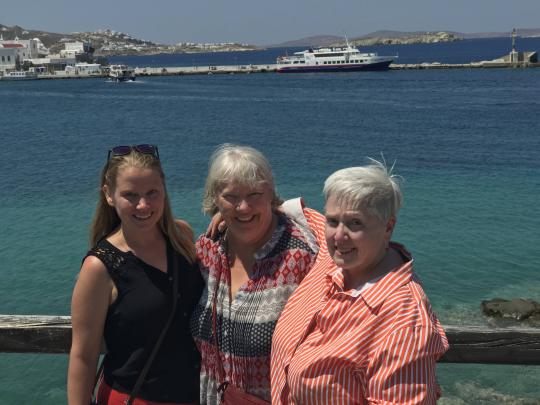
With my favorite ladies!
Alternative name: Ryan takes selfies with food

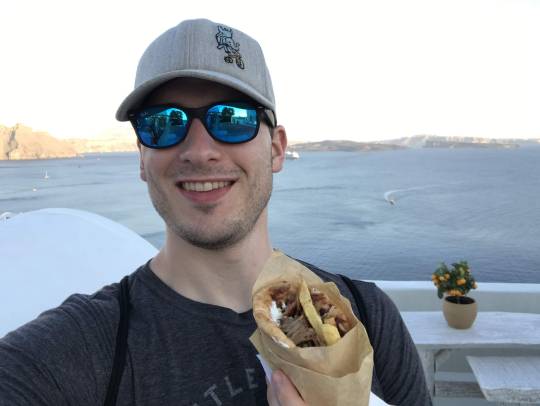
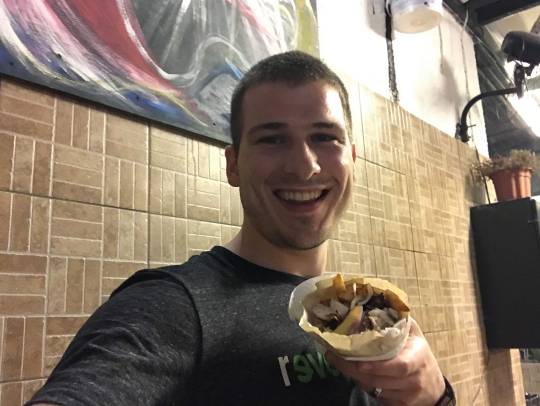

As our time in Amsterdam is winding down, my lovely mother finally got her bum in gear and booked her trip to come visit. I put a lot of time and care into planning this trip, because we haven’t been looking forward to it for the past two years-- we’ve been looking forward to it for closer to 20! My mom and I have had Greece on our bucket list for as long as I can remember, and my living in Europe made for the perfect opportunity.
My last day at work was the Monday following our anniversary trip to Edinburgh, so I didn’t have a whole lot of time to prepare before picking her up from the airport Tuesday morning. For some damn reason, she decided to arrive on literally the hottest day I’ve experienced since moving here myself. Seriously, heat records were broken for the last week of May. So - we grabbed some iced tea from Starbucks (the only place in Europe you can GET iced tea the way we like it) and hopped on the train.
Ryan worked from home that day, so once we dropped her luggage off, the three of us ventured up to the Foodhallen, which is, you guessed it, a food hall with stalls serving up different types of street food. While we generally don’t advocate eating traditional Dutch food, we do always try to make sure everyone gets at least a taste. The easiest way to do this is to order bitterballen, which I lovingly like to describe as ‘fried balls of gravy’. I think they’re disgusting, but I’ve received mixed opinions from my guests. Ryan enjoys them, but never seems to order them for himself. I don’t think mom was terribly impressed-- I’d show you the photo of her digging in, but then I’d have to give up my American citizenship and never return home, for fear she might murder me.
Ryan returned to work while mom and I wandered up through a neighborhood called the ‘Jordaan’ which is full of cute shops and great for people watching. After showing her the Anne Frank house (from the outside- the line was way too long to go inside) and buying a few charms for our charm bracelets, we hopped on the tram home to relax for a bit. I took her to dinner at my favorite neighborhood pizza place before calling it a night.
The next morning we took the train to Haarlem, one of my favorite little towns just outside of Amsterdam. We grabbed brunch at one of my favorite spots, then took a stroll to see one of the last remaining windmills in the area. We had some lemonade and shared a piece of carrot cake at my favorite tea shop (too hot for tea, and they don’t do iced!). I bought the biggest bag of loose leaf of my favorite blend they had, and we hopped back on the train to Amsterdam. Ryan met us for dinner at a delicious Kansas City BBQ joint we’ve come to love before heading in.
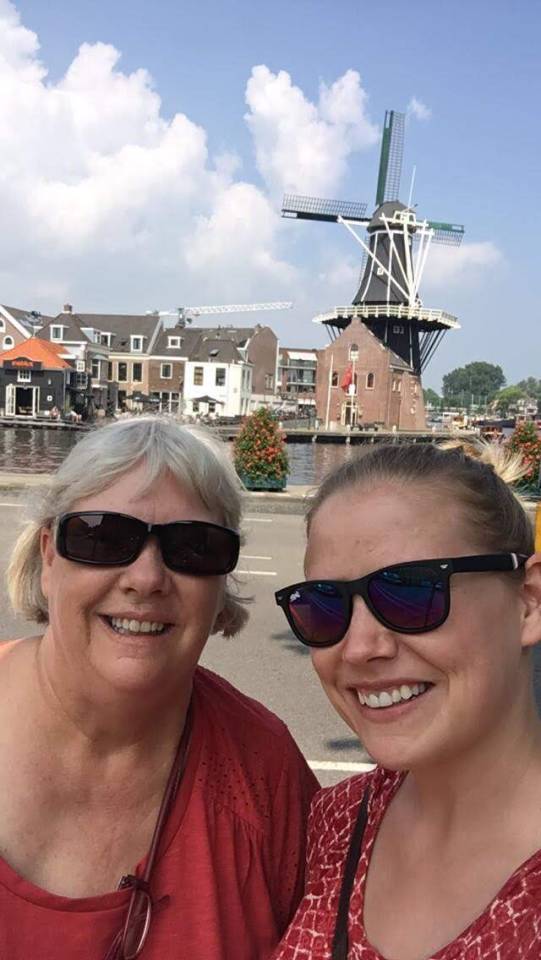
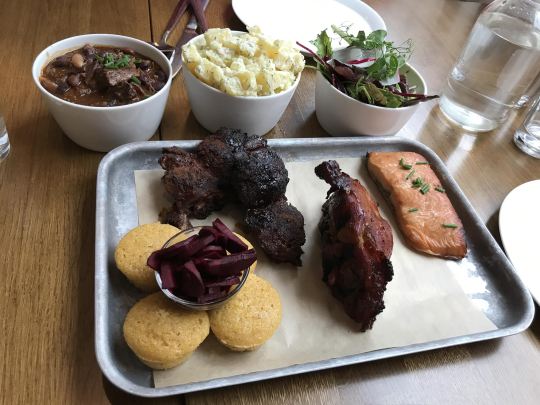
Thursday we went to the Van Gogh museum, where there was a special exhibit displaying his Japanese-inspired paintings. Of course we had to make the other typical Dutch food stops, where we hit up Ryan’s favorite fry place, a deliciously Instagram and Pinterest-famous chocolate cookie shop, and finally, a bakery specializing in everyone’s favorite Dutch treat, the Stroopwafel!
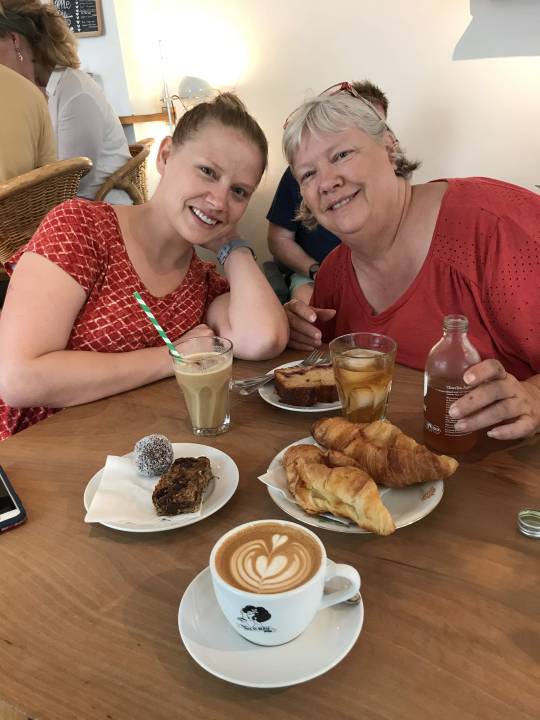
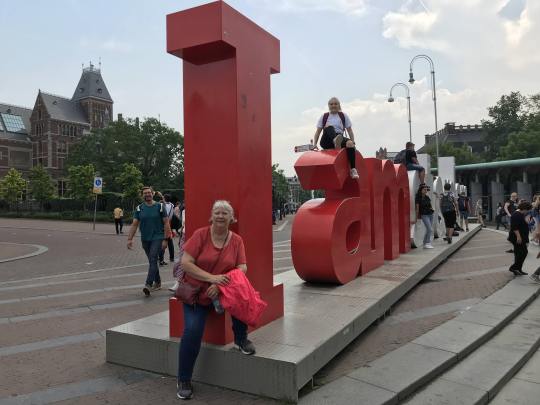
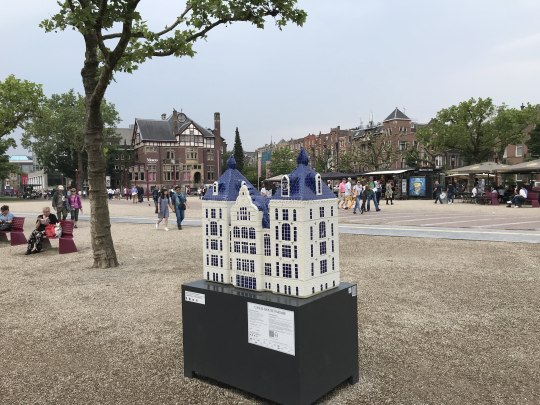
Here is mom’s impression of Amsterdam, in her own words:
Finally! I made it to Amsterdam! First impression - it’s very hot and humid! That impression didn’t change except when it was raining. I loved the rain! Being as I was only there a very short time, we ran around from place to place to see as much as I could without spending too much time in any one place. The first night we ate at a marketplace where you could get about any food type you desired. I had my first taste of bitterballen. Was very good but basically deep fried gravy and one was enough for me. Mariah and I took most of the next day and traveled to Haarlem. Adorable little town, sort of a miniature Amsterdam. Many cute stores and a great little tea shop. That evening we had authentic Kansas City BBQ. Delicious!
We went to the museum plaza where there was an exhibition of miniature canal houses done in Delft. They were wonderful! We visited the Van Gogh museum. Was a great museum but honestly think I was suffering from heat exhaustion and didn’t enjoy it as much as I wanted to. There are many museums on the plaza and I would love to explore more of them someday. Things of note in Amsterdam are the beautiful parks, the superb public transportation and of course the architecture. It is a very old city and the buildings are amazing. The architecture was probably my favorite thing about the city. Also noteworthy are the millions of bicycles ridden by all ages, shapes and sizes, all day long as well as the very small garden plots in front of nearly every home and window boxes adorning most windows on all floors.
On my last night in Amsterdam (a trip to Greece in-between) Mariah and I stayed in a very nice boutique hotel named The Muse. Was a great last night and I left the next morning after a great breakfast prepared by friends Scott and Ashley. They are very special people and it is easy to understand why Mariah and Ryan have become such great friends with them. Knowing I would see Mariah and Ryan in six weeks made it easier to go...
Finally time to head to Greece, we made a final round through our apartment, as we had actually ended our lease and were due to move out that day! As much as Amsterdam will be missed, that place absolutely will not, so we bid it good riddance and made for the airport!
We landed in Santorini at about 9 in the evening, and were lucky that my Aunt Karen had arrived a few hours earlier and was able to check into our rental, which was in the village of Perissa. We dropped our stuff off and immediately made our way to the dive across the street for some late-night dinner. We had gyro, dolmas (my favorite!) pita and tzatziki and we were in heaven!
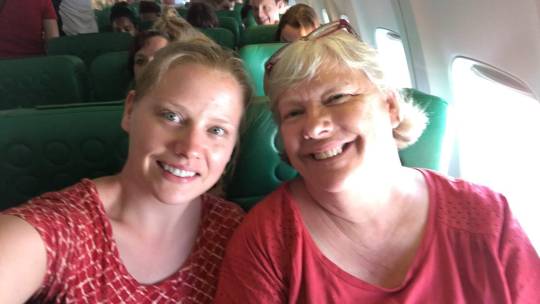
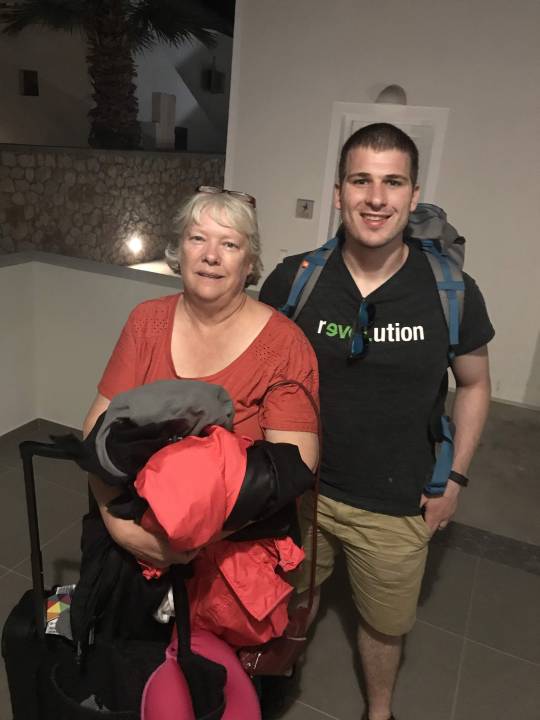
Made it!
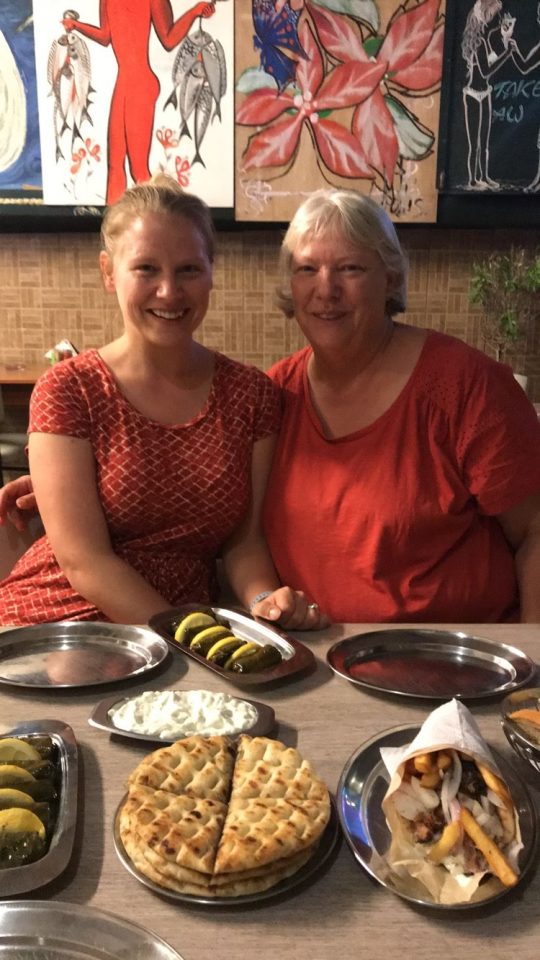
Oh Greek food, how I love you!
Friday morning we had some Greek pastries for breakfast and headed to the Excavations of Akrotiri, which were supposed to be some great ancient ruins but turned out to be the biggest waste of money on the trip. The site was unfortunately very disappointing. No matter, the site was right on the beach, so we walked down to the coast and hiked up and over to the Red Beach, aptly named for the color of its sand/rocks. We weren’t prepared for a true beach day, so we just admired for a bit, took a few photos and headed over to Fira for some lunch.
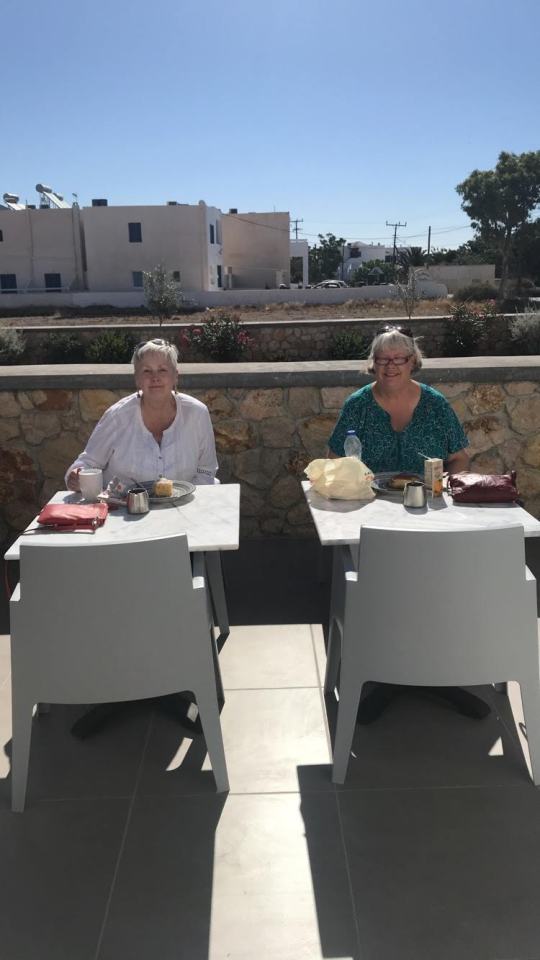

Some rather disappointing ruins. Good thing we’re cute!
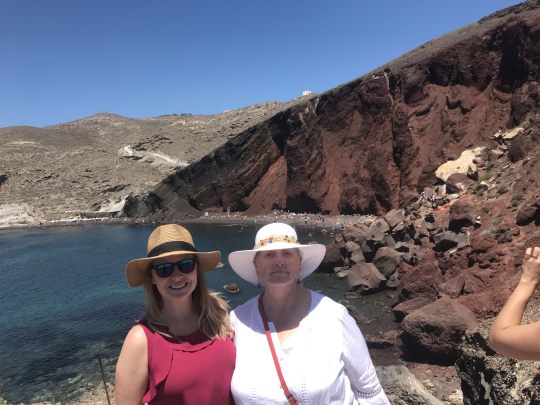
The beautiful red sand beach
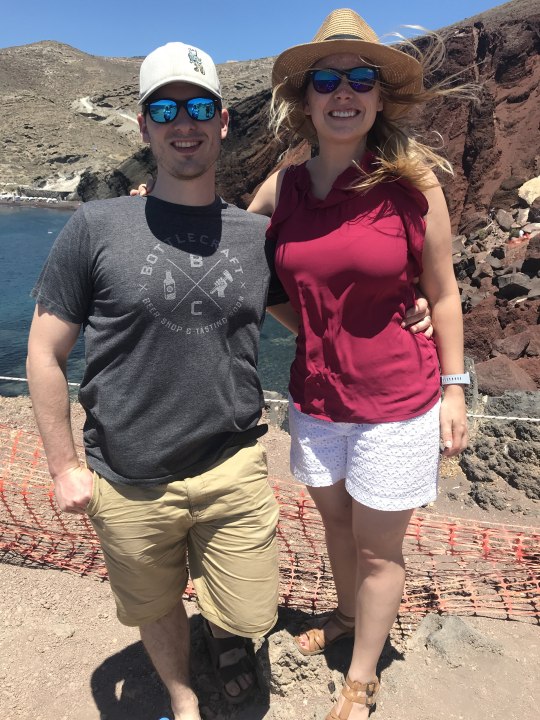
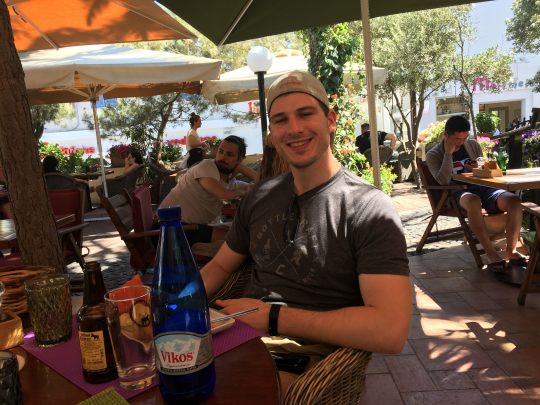
Mom and Karen hung out while Ryan and I took on the popular hike from Fira to Oia. It was absolutely stunning - the perfect mix of hills and ridges along the coast where we passed every #dreamgoals resort you can possibly dream up. We arrived in Oia just before sunset, where we sat and watched it go down on a rooftop sangria bar. We grabbed dinner then met up with Mom and Karen, who had spent our hiking time exploring Oia. We took advantage of our apartment’s private jacuzzi then hit the hay.
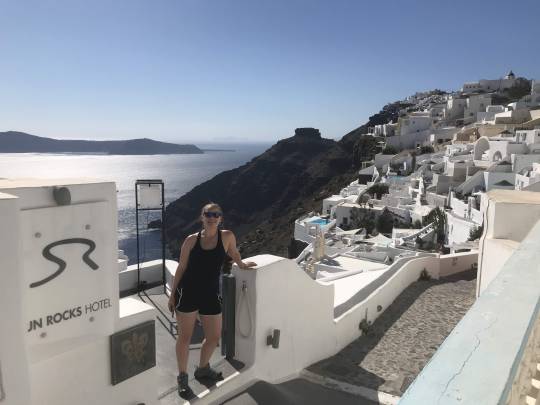
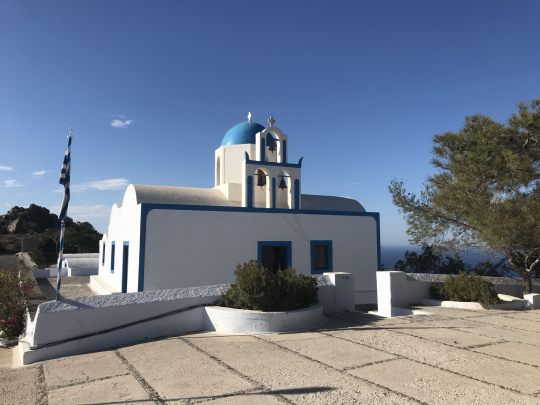

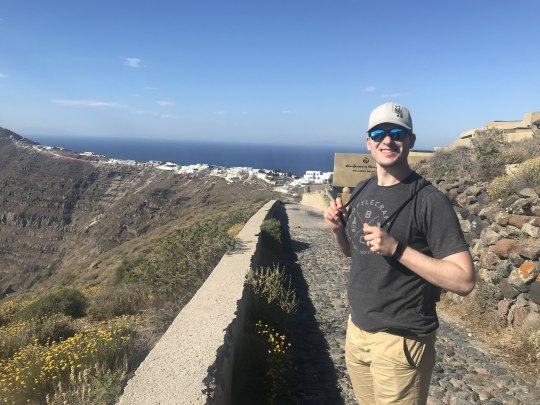
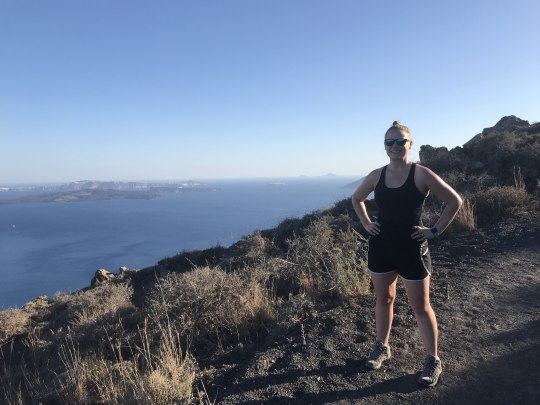
Hiking through paradise! (Prepping my new hiking boots for the imminent Trolltunga)

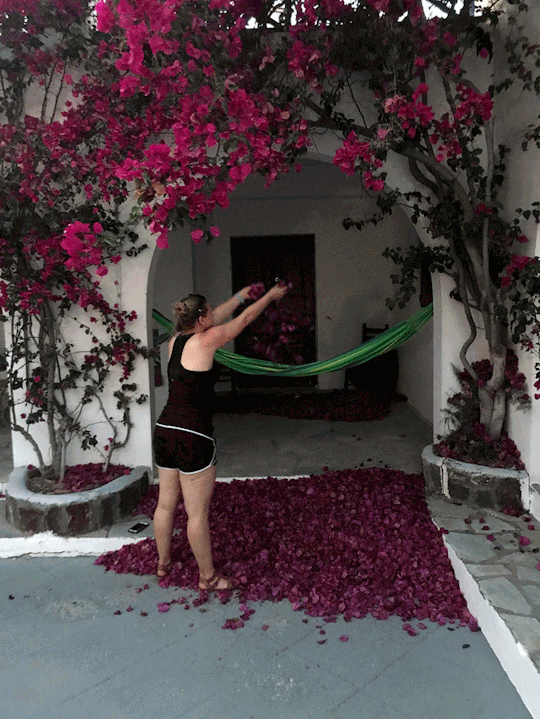

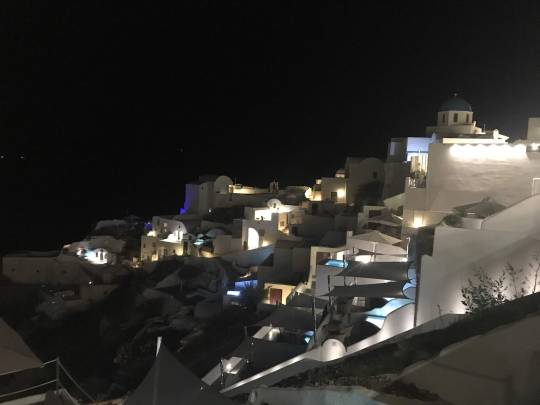
We slept in a bit on Saturday before walking down to the black sand beach. I had booked our specific apartment in Perissa because of its proximity to the best beach on Santorini. It was still about a 15 minute trek down, but it was 100% worth it. We grabbed brunch at a beachside cafe before walking about 100 feet through the sand and plopping down on some shaded beach lounges and ordering fresh fruit smoothies. We enjoyed our drinks by the sea then mom and I decided it was time to take a dip. What is nice about this beach is that the black sand is actually small pebble, which makes it much easier to stand on and brush off (though we did manage to trek plenty back to our apartment) and makes for very clear water, because it doesn’t get picked up in the current like typical beach sand does. While mom tried very hard to get me to let her stay there forever, we eventually decided we’d had enough sun and headed in. Ryan was nice enough to walk back and grab the rental car for us, so we were chauffeured back to our apartment for showers and a nap.
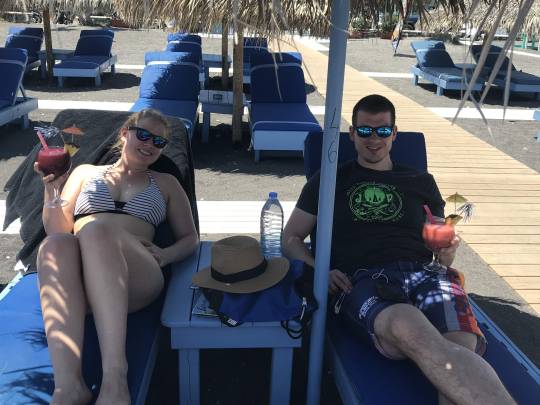
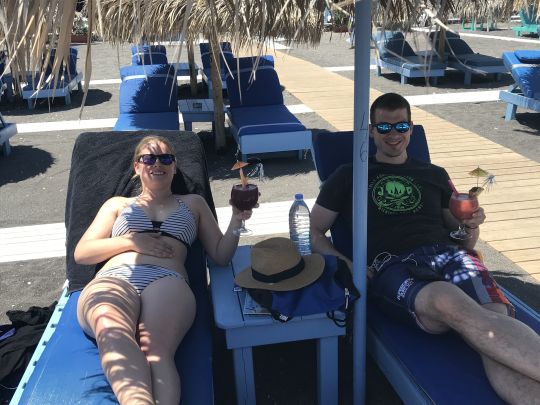
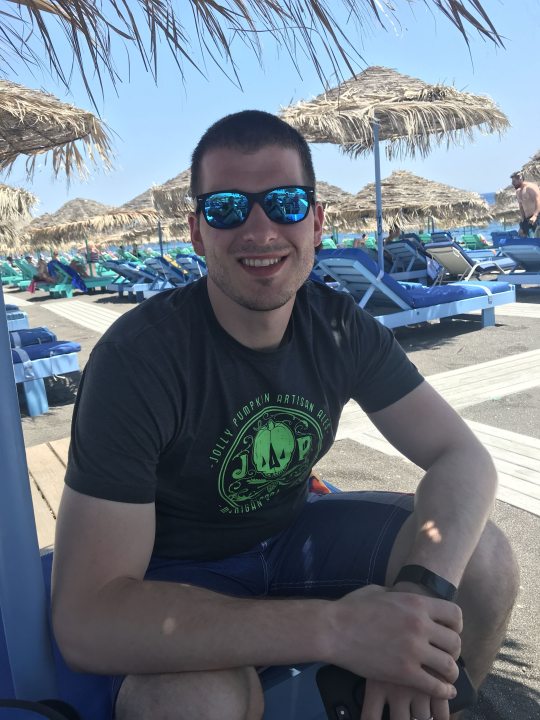

Mom and Karen stayed in the rest of the evening while Ryan and I went to a tasting at a local winery. The winery sat at the top of a hill overlooking the sea, but after a full day of sun, we decided we had better sit inside in the shade. The wine was great, some better than others. The entertainment, however, was provided by a crabby old man at the bar directly behind our table. Fortunately Ryan was able to sneak a photo of him in action.
Old man: ‘Can I have a mimosa?’
Bartender: *blank stare*
Old man: ‘Do you know what a mimosa is? In America we have mimosas!’
Bartender: ‘Like the flower?’
Old man: ‘Like the drink’
Bartender: ‘Ok, sir, where are you sitting? I will send the waiter over for your order.’
Old man: ‘I don’t have a table. I’ve already eaten and paid. I just want to wash everything down with a mimosa.’
Bartender: ‘Ok sir. What do you want?’
Old man: ‘Orange juice and champagne. Do you have orange juice and champagne? Just give me a glass of orange juice and a glass of champagne. I will make it myself!’
Bartender: *pours a flute of champagne and asks him hesitantly if he also wants a glass of orange juice before pouring a second flute and charging him for each separate drink. The old man pays and the bartender peaces out before she has to endure any more attacks.*
Old man: *proceeds to chug half of each flute before pouring the OJ into the champagne*
While the conversation took a solid five minutes, it took less than 20 seconds for the guy to down his drink and walk out of the winery once the bartender poured his two glasses. Was it really worth the trouble, man?
Anyways, we enjoyed our wine, headed to dinner and called it a night.
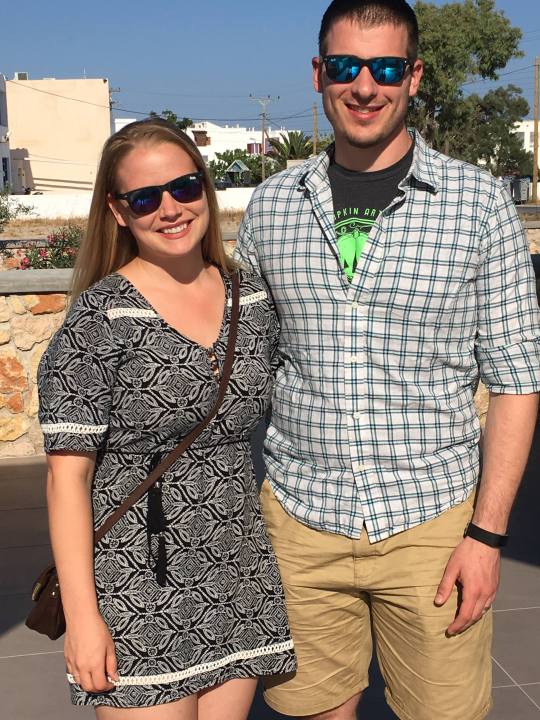
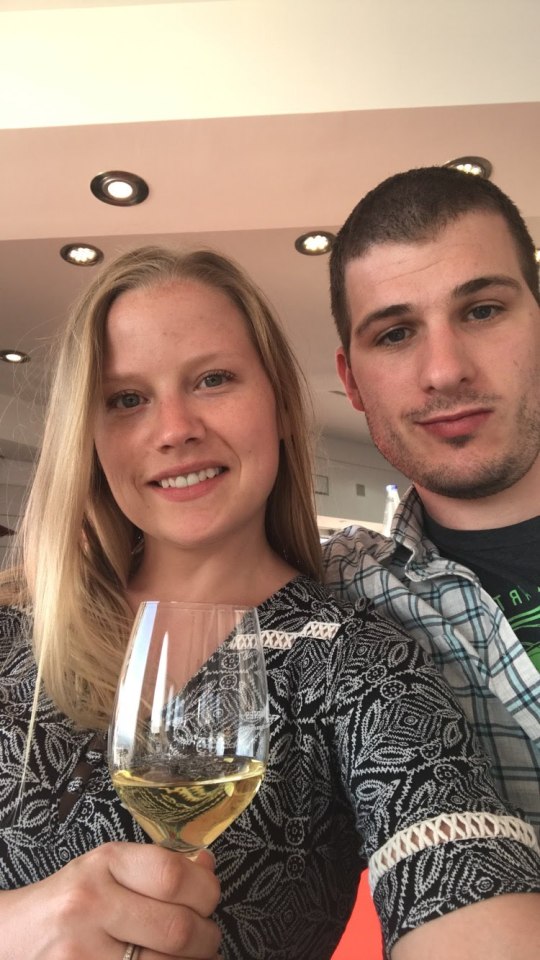
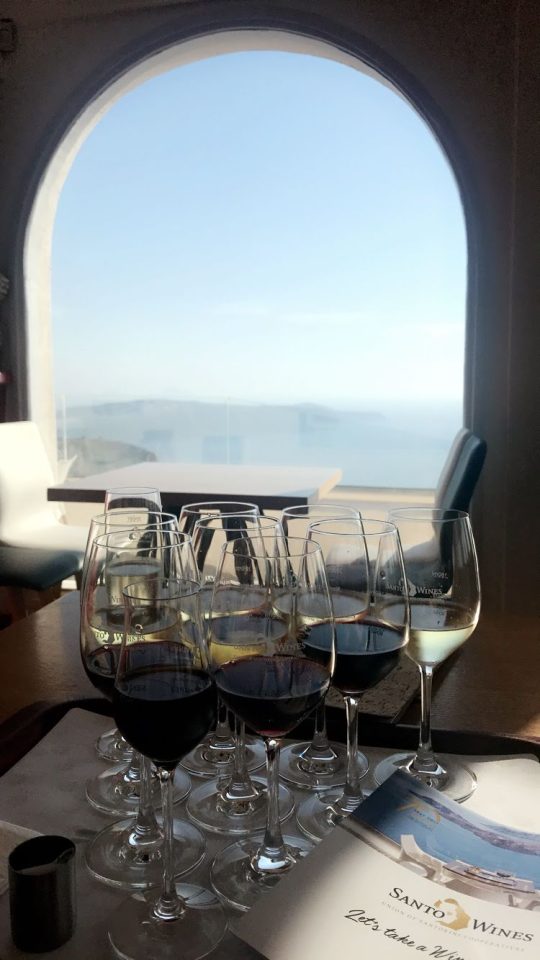
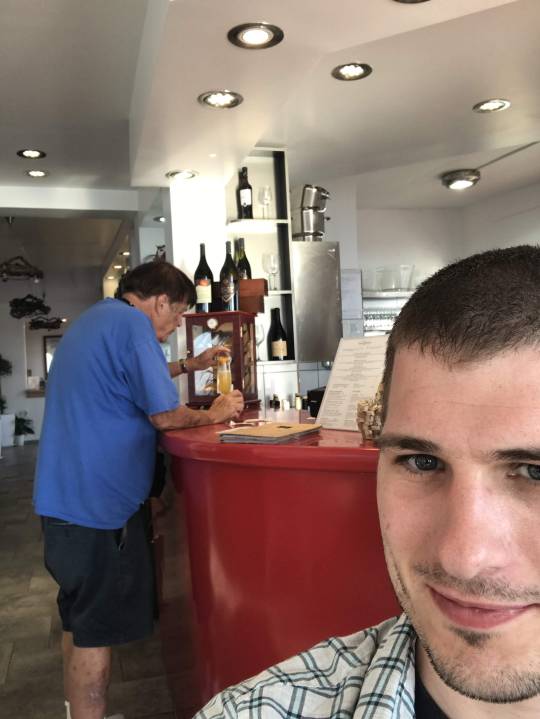
DIY mimosa guy
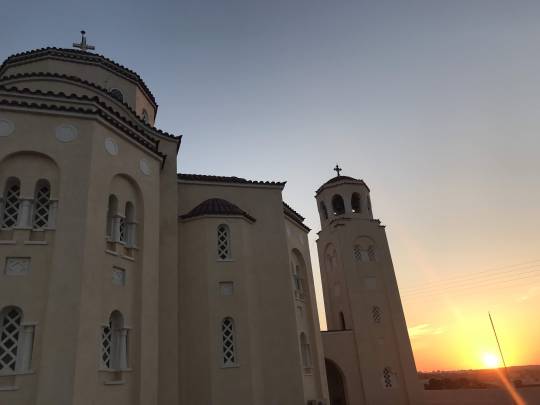

Eww, octopus
Sunday morning it was time to leave Santorini already. We booked a ferry to Mykonos, the second island of our trip. If Santorini is heaven, I don’t know what Mykonos is, but I could stay there forever. The views from our apartment were unbeatable, and we had an infinity pool and bar just outside our door. We decided to stay close to home that evening, but walked over to a nearby Indian spot for dinner. Ryan only recently got me to start enjoying Indian food, and I think it was mom’s first time ever. Regardless, it was delicious-- so delicious we went back the next night to grab takeout!
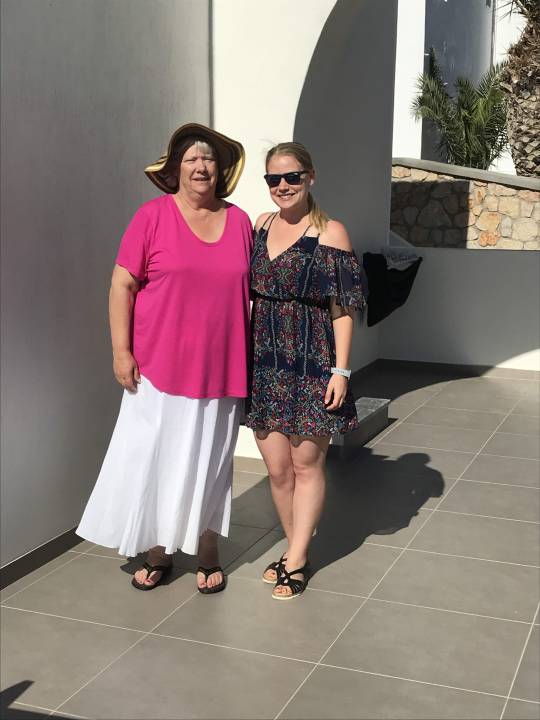
Leaving Santorini

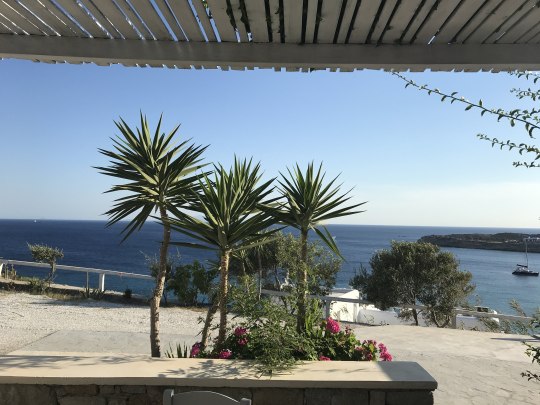
The new view isn’t so bad
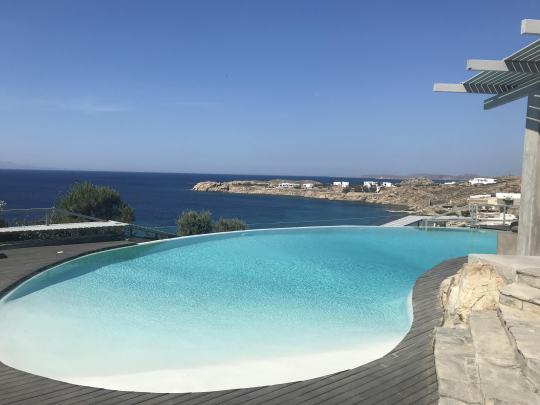
Back at the apartment mom and Karen took a quick dip in the pool, but I was a weenie and just dipped my toes in (Ryan grabbed a G&T and went up to sit on the rooftop patio).
We slept in again then sought out brunch. I had a life-changing acai bowl that I can’t stop thinking about nearly a month later, then we headed down into the main old town. The day was spent exploring the winding pathways of the city, taking way too many photos of the beautiful buildings, and stopping in all the local shops. Mykonos is known for its windmills, which are much different from those I’ve become accustomed to here in the Netherlands. Ryan and I spent a few hours lounging around back at the pool before grabbing that second helping of Indian for the whole crew.
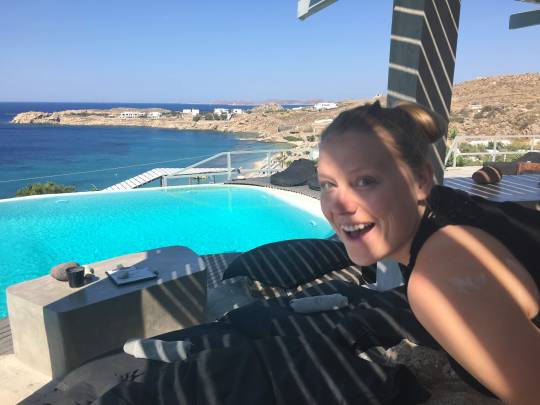
Apparently too excited to bother rubbing in all of my sunscreen...
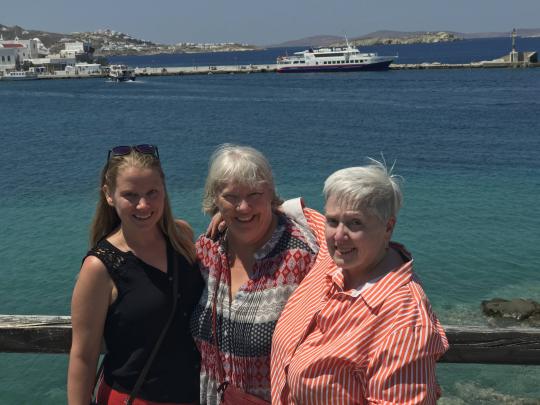
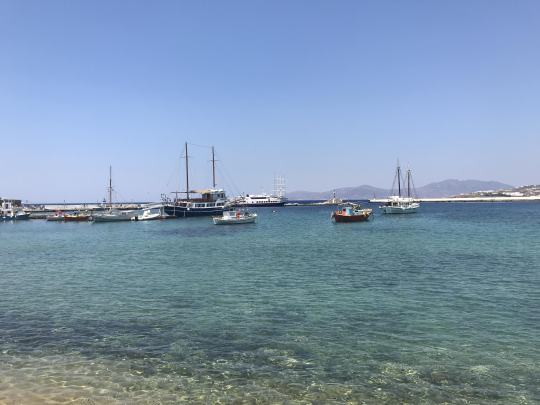
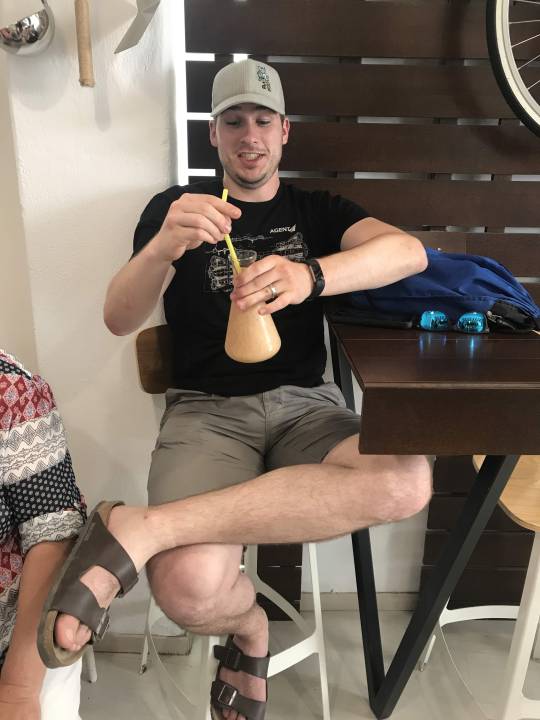
A quick tea and smoothie stop


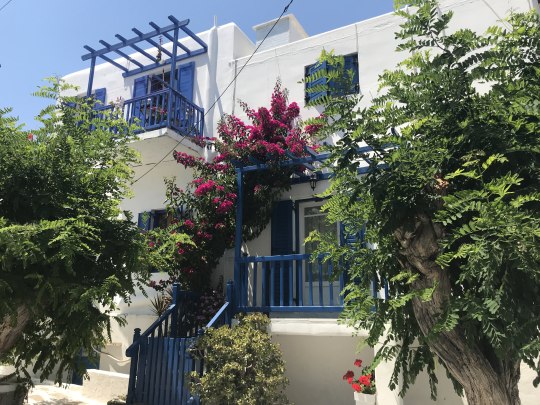

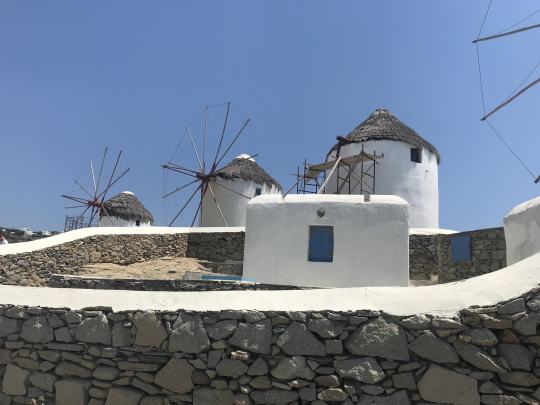
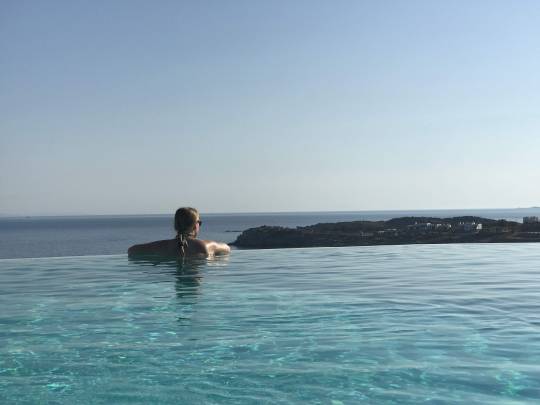
Not a bad way to end the day
The island of Delos was our main activity for the following day. We hopped on a ferry to check out the supposed birthplace of Artemis and Apollo. While it was ridiculously hot, these ancient ruins were far more interesting and well-preserved than the ones in Santorini. Back on the main (is)land, we grabbed lunch at a small Italian spot before an afternoon nap. Ryan and I journeyed out for another date night, this time walking (hiking) along the coast to a small family-owned restaurant on the other side of the island. We managed to arrive in one piece, where I had delicious salmon (chicken for Ryan) on the beach.
Our hike back was slightly less treacherous, as at least we knew the way, but we did receive a small surprise in the form of a wild hedgehog in our path! I can’t believe I didn’t take a photo now that I think about it. He was quite calm and friendly, we just had to step around him in his little ball and keep going. We grabbed some gyro from the snack bar on the beach for mom and Karen and headed in for the night.


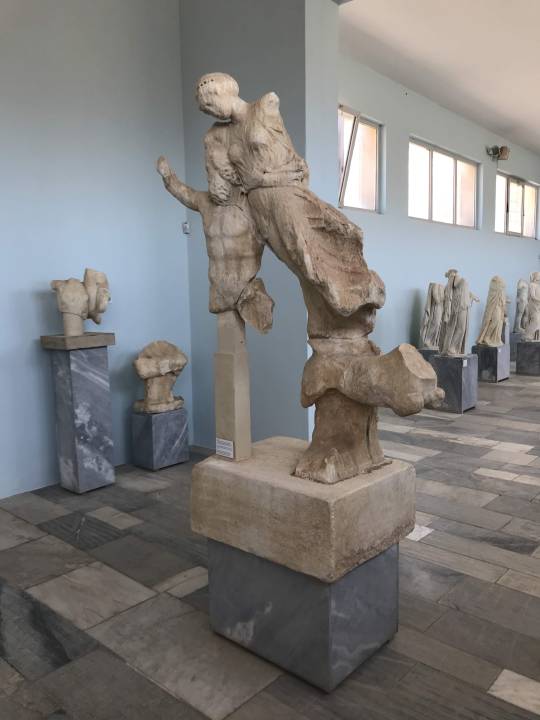
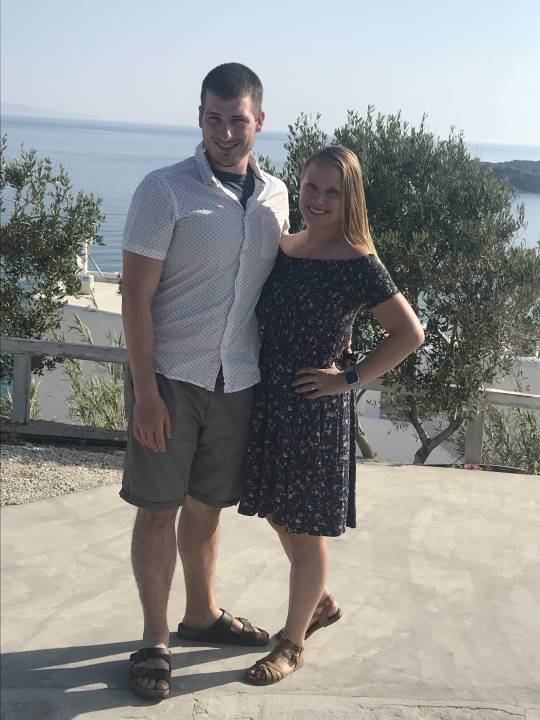
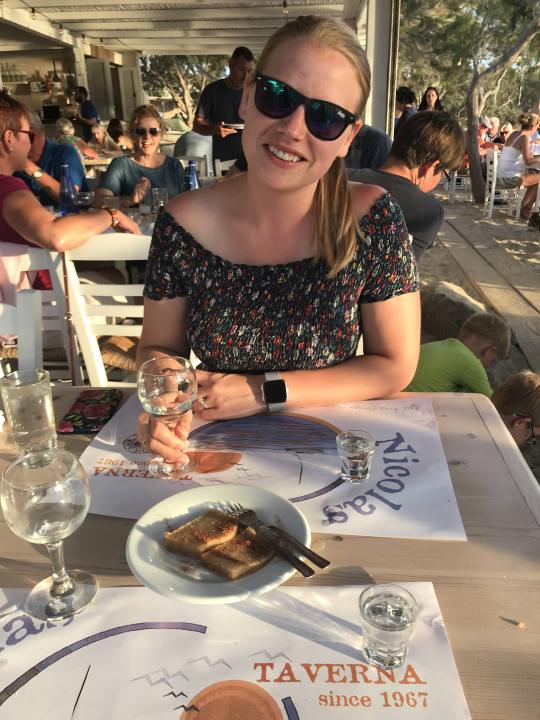
The next day it was time to hit the beach one last time. Our apartment was right next to one of the main beaches on the island but it was a serious hike to get down there. Mykonos is known as the party island of Greece, so the earlier in the morning you go, the less likely you are to have your ears assaulted with EDM and/or 90s rap. On the flipside, This is when all the 50+ folk decide it’s time to get their tan on, in the nude. Sweet baby Jesus. Actually it really wasn’t an issue, after the initial shock of old bronze fat man bits.
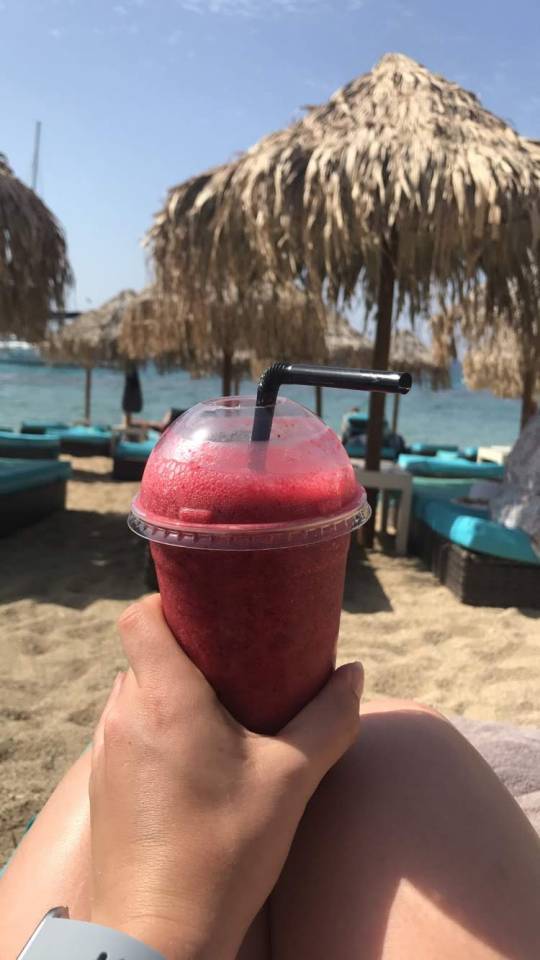
It was even harder to pull mom out of the water this time around, but after some solid fun in the sun we had to head back in order to take Karen to the airport. Unfortunately she had to head home a day earlier than the rest of us. We grabbed lunch at the ‘El Burro’ cafe and said goodbye. The three of us then went back into the old town to do some final shopping - mom wanted some souvenirs to bring home and I had some jewelry I wanted a second look at. The next morning it was our turn to head out, but not before one more go at that life-changing acai bowl.
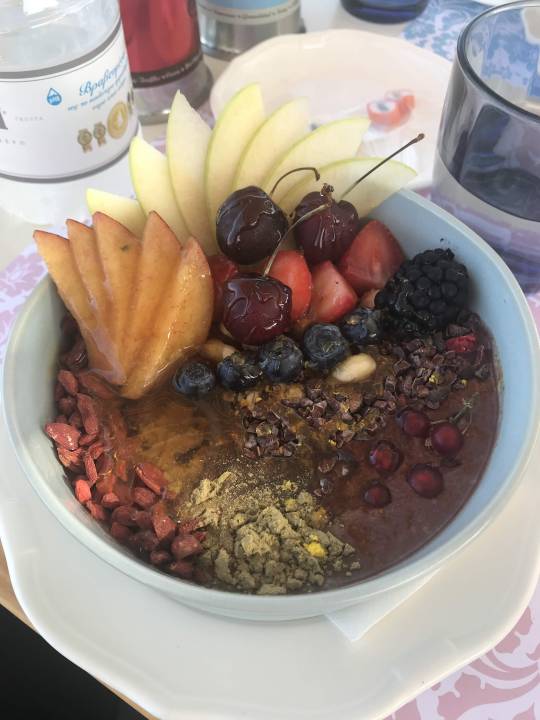
Clearly I have nothing but praise for Greece, and I think perhaps mom feels the same:
On to Greece! Top of my bucket list knocked off. Greece was everything I have ever imagined it would be. We spent several days on the island of Santorini. My sister Karen met up with us for this leg of my trip. The black beach will always be my favorite memory. Karen’s as well for a much different reason. The sand was a beautiful black. We had a lovely room with our own hot tub and private patio. Across the street was a dive restaurant that had the best Greek food. We ate there several times. The old town of Santorini was great for shopping and the bougainvillea was everywhere and absolutely gorgeous. We visited some ruins which I would not recommend to anyone but still somewhat interesting. We visited the towns of Fira and Oia. Wonderful shopping and great restaurants. Oia has one of the most beautiful sunsets in the world.
We then took a ferry to Mykonos and had another great room with a fabulous view of the sea. Little did I know but Mykonos is known as the party island and they partied at the island’s biggest Disco right down the hill from us all night long. Very loud and you could feel the energy. Once in our room you couldn’t hear the music so all was well. There was a great Indian restaurant near our place, so good we ate there twice. Paradise Beach is amazing. The water so clear, you can see little fishies swimming all around you. Apparently all the beaches in Greece are clothing optional but as long as they didn’t expect to see me without clothing it was no big deal. The roads are narrow and people drive crazy like I have never seen before. Lucky for us, Ryan did all the driving and I just didn’t look! We took a ferry, a very fast ferry, out to Delos to see the ruins of the Gods’ homes. I would recommend seeing the ruins there as well as the museum. As there was no shade and really hot, Karen and I spent most of our time in the museum while Mariah and Ryan trucked around the whole island. I’m sure I missed a lot - but the heat! I could go on and on but I could never explain how beautiful it was and just how much it meant to me to be able to go, and with such great company!
Once we arrived back in Amsterdam, I had about 24 hours to show mom anything else I deemed worthy before sending her back home. Having moved out of our apartment the week prior, mom and I got a hotel for the night while Ryan stayed with our friends Scott and Ashley. We went to the Albert Cuypmarket, which is a popular street market in the De Pijp neighborhood Not having enough time to make it over to Vondelpark, we settled for a stroll through the much smaller but also lovely Sarphatipark. We had a reservation for dinner at one of our favorite burger places, Cannibal Royale, so we took our time in meeting Ryan, Scott and Ashley there by walking by one of the red light streets--I couldn’t let mom leave Amsterdam without that experience!
Ashley was kind enough to have breakfast ready for us the next morning, so we all enjoyed a bit of time on their patio before sending mom off. Ryan and Scott were also heading to the airport, as they had a guys’ trip to Copenhagen planned for the weekend. They took good care of her, getting her to the airport and all checked in.
This trip was absolutely one for the books for a number of reasons. First of all, it was quite the task convincing mom to finally get her passport. Traveling can be scary, so I’m proud of her for finally taking the plunge! Greece has been at the top of my bucket list for as long as I can remember, and it truly did not disappoint. There are a lot of placed I’d love to visit and even revisit, but Greece was indisputably the most beautiful, wonderful, fun place I’ve ever been. Good thing there are about 100 (or so) more Greek Islands I can check out!
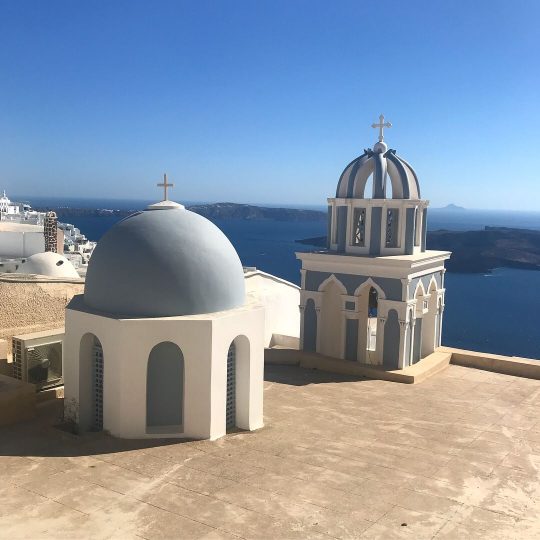
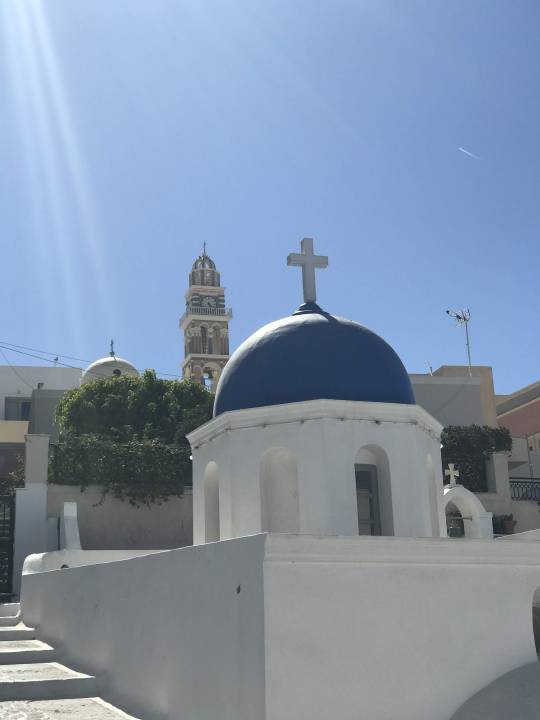
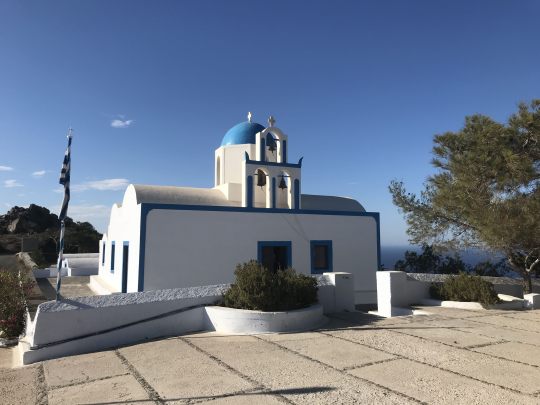


Leaving you with a few final photos of Santorini and Mykonos
Opa and tot ziens!
0 notes
Text
April 12, 2018. Haarlem-Keukenhof-Noordwijk-Oude Wetering
Combination of fresh air and exercise and adjustment to time change made for a better nights sleep and less of a groggy feeling in the morning. Up early for breakfast and ready to ride before 9am as instructed. We still ended up standing around waiting for the group - just part of the deal I guess. San & Matt, and Jeff and I went out with Sandra's smaller group - those that opted for the longer loop (53 km), and except for an older French couple, we were probably a faster group too. Another overcast morning, and again a moist feeling that made it feel colder. We started out riding bundled up again. Geo opted for staying on the boat today, along with a few others. We rode back through Haarlem, and the city square was different with full cafes and people milling about. Just garbage trucks and delivery vans, and people cycling to school and work. We even saw a women with a baby in a sling, feeding it a bottle while she blindly sped her bike through a red light! I'm always taken aback in awe when I'm in a European city center like this. I try to imagine the history that went on there before North American was even "discovered." From there, we rode a circuitous route through an amazing wooded park and neighborhoods with beautiful manor-like homes. It added some distance, but got us off the path that paralleled the busy highway and was much more enjoyable. We rode on paths dedicated to bikes and scooters over these past two days, hardly on the road at all. We had some experience with scooters on the paths last summer biking in Slovenia and Croatia - I don't like it, but you generally hear them coming so you're not surprised. After about an hour of riding, we had our first glimpse of a field of flowers. I was so excited, I was giddy! Sandra gave us a break and we ran up a little hill to get a glimpse through the trees. We traveled a little further and stopped at a cute little place for a coffee / pie break. As we set off in the direction of Keukenhof (an amazing spring flower display venue) we started seeing more and more fields with yellow daffodils and hyacinths in all shades from white to pink to purple (who knew there were so many variations of pink and purple). Not only would the site make me gasp in delight, the smell of a field of hyacinth is indescribable! There were also huge fields of tulips, some that were just beginning to bloom - next week they'll be spectacular too. We arrived at Keukenhof, and our group had 90 minutes there to enjoy the flower displays - which were amazing. The crowds though were harder to deal with after enjoying the flowers all to ourselves this morning. It's only open for 8 weeks, and they'll have two million visitors during that time! We covered about half of the displays, then ate our lunches and headed back to the bikes to meet Sandra. Jim had riden with mom and Cris in the morning, but at this point he jumped to the longer ride and joined us. It had gotten colder and windier, so we bundled up again as we headed out. We traveled west and south towards the North Sea resort town of Noordwijk. Along the way, many more flower fields and several cute villages. Soon we started seeing campgrounds, with what looked like seasonal campers already in place. Then dunes. We rode for several miles through the dunes, parallel to the sea, but never able to see the sea. It was a beautiful natural area with many trails designated for walking and off-road cycling, and a nice wide paved trail that we travelled on. We had approached a developed resort area with hotels and restaurants before we could see the sea. We took a 45 minute break there to check out the area and grab a snack. I took my shoes off and stepped into the sea, which was quite cold of course (it probably always is). As we left the beach area, it began to rain. We stopped to add more layers. The ride from Noordwijk to Sassenheim started out delightful. School had just gotten out, and it was fun to see the teenagers riding towards us, chatting animatedly as they rode. Some hanging onto each other too! Clearly these were kids that cycling was part of their DNA. The rain got heavier. We were on a nice path that paralleled a busy road. The traffic there felt frantic, more scooters joined our path, and we had to negotiate about 10 roundabouts. On top of that, Sandra seemed confused about our route. By now, I'd figured out the map and I'm pretty sure she missed our turn, which ended up being a short cut, but we had some not so savvy riders in a long chain negotiating those roundabout crossings - not so good. Finally we crossed under an autobahn kind of road and she got her bearings. We had to do a cloverleaf kind of path to cross over a barge lock / canal, and then we were back to peaceful riding looking at boats parked along the canal and cute little houses and the occasional restaurant. The rain let up, but our French couple was falling further behind, which slowed Sandra down too. We'd just get warmed then we'd stop. I asked permission to bust out ahead. She was worried about us getting lost, but I knew I had it figured out. The 5 of us plus a couple from Colorado sprinted off. Felt good to push it and move. We stopped for a photo of nesting swans, other than that raced all the way back to the boat. Gotta admit I breathed a sign of relief when we turned the corner and saw it just where I though it would be! Fun day. We expected rain on this trip, so what we had today was nothing to stop our mojo! Hot shower felt great and I'm ready for dinner!
0 notes